
J.P. Morgan Perspectives
Blockchain, digital currency and cryptocurrency: Moving into the mainstream?
Executive summary
Blockchain evolution: Moving into the mainstream?
- While blockchain technology has not yet emerged into the mainstream, it has moved beyond experimentation and use in payments, with stock exchanges embracing the efficiency around settlement/clearing and collateral management.
- Trade Finance and Payments blockchain solutions offer the most incremental efficiencies in the banking sector relative to other use cases, but widespread implementation is at least three to five years away.
- We see the long-term potential for Distributed Ledger Technology (DLT) to transform banks’ business models by providing efficient and resilient information transfer and storage once scale has been achieved…
- …but legal and regulatory frameworks and technical challenges, such as cross-platform integration, may decelerate further progress.
- There is a need for verification of the information going into a blockchain; quantum computing raises security questions and poses risks around blockchain’s ability to provide an immutable record.
The rise of alternative payments
- Asia represents the bulk of global growth in payments, driven in large part by the explosion in third-party (non-bank) and mobile providers, with the most rapid growth in China and India.
- Cashless economies work and increase financial inclusion with the example of China suggesting that the transition to a mostly cashless economy can be managed at scale…
- …but the rapid rise of payments-related Money Market Funds (MMFs) in China poses financial stability risks, and high-speed change requires an equally adaptive regulatory response.
Are stablecoins a scalable alternative to cryptocurrencies?
- The crypto market continues to mature with the increased participation by financial institutions and the introduction of new contracts on regulated exchanges.
- Bitcoin and other freely floating cryptocurrencies continue to exhibit extreme volatility relative to fiat currencies, which has led focus towards stablecoins to minimize price fluctuations.
- Private stablecoins are likely to face technical hurdles, including the need for intraday liquidity.
- Bitcoin prices have corrected much of the gap versus intrinsic value but have yet to demonstrate their value for portfolio diversification.
This is our annual update on the latest developments in the adoption, evolution and performance of blockchain technology and cryptocurrencies. We expand our report to include analysis of stablecoins and the rise of alternative noncash payments. This report is part of our J.P. Morgan Perspectives series, which brings together views and analysis from across the broad scope of J.P. Morgan’s Global Research franchise to look at big ideas and critical global issues transforming investment markets. We hope this series will both inform and foster public debate on evolving economic, investment, and social trends. – Joyce Chang, Chair of Global Research
Blockchain, digital currency and cryptocurrency: Moving into the mainstream?
- We expand our annual review of blockchain technology and cryptocurrencies to a broader discussion on implications of the rise of digital money.
- Stablecoins have the potential to grow substantially in global transactional activity despite challenges inherent in the microstructure of operating such a payment system.
- While the world is ready for private money in our view, rapid adoption and scale are hindered by the underlying technology and the need for substantial regulatory oversight.
- For a stablecoin like Libra to succeed, it will likely require short-term liquidity facilities, a source of positive-yielding reserve assets, and less distributed, semi-private networks.
- Blockchain has yet to emerge into the mainstream of financial services, but stock exchanges are embracing the efficiency around settlement/clearing and collateral management.
- Widespread implementation of blockchain solutions in traditional banking is likely three to five years away and will be concentrated in trade finance and payments.
- Asia has driven third-party (noncash) global growth in payments, especially mobile wallet, with card and e-money payments growing more rapidly than other types of noncash payments.
- Online platforms have driven the growth of China’s wealth management industry, including Money Market Funds (MMFs), posing financial stability risks.
- Despite the rise in cashless payments, cash use is still increasing in most countries.
- Cryptocurrency trading participation by institutional investors is now significant, but volatility remains a severe impediment to broader adoption.
- Cryptocurrencies continue to have a limited role in portfolio diversification or as a hedge instrument.
Moving beyond blockchain technology
As emerging technologies continue to disrupt every industry and as consumer preferences evolve, modernization of payments is now a global theme. 2019 will be remembered for the rise of digital money. The groundwork is now in place for more mainstream adoption of blockchain technology at the same time that the foundation is being established for the development of digital currency and fast payments. Although legal and regulatory frameworks and technical challenges remain high, the past year was marked by a number of breakthroughs, notably widespread blockchain technology adoption by stock exchanges, the explosive growth of third-party payment systems in China, which suggests that the transition to a mostly cashless economy can be managed at scale, and the launch of options on bitcoin futures contracts on regulated exchanges. The technology challenges for bitcoin opened up the opportunity for alternative cryptocurrencies to fuel blockchain adoption. That led to a surge in alternative cryptocurrencies, many with questionable initial coin offerings (ICO). USD Coin recently launched in 85 countries. JPMC became the first national bank to create and successfully test with clients a digital coin representing fiat currency with the announcement of the JPM Coin project, which is a digital coin representing US dollars held on deposit at JPMCB, designed to facilitate payments between institutional JPM clients.3 China is developing its own central bank digital currency, a digital yuan or “e-yuan,”4 and other central bankers have started to seriously examine a supranational multi-currency-backed token as a replacement global reserve asset. But the failed release of Facebook’s Libra serves as a reminder that rapid adoption faces practical challenges to attain scale. For a stablecoin like Libra to succeed, it will likely require short-term liquidity facilities, a source of positive-yielding collateral (for those coins relying on reserve asset income), and less distributed, semi-private networks.
The crypto market continues to mature, and cryptocurrency trading participation by institutional investors is now significant. Bitcoin prices appear slightly overvalued, but much of the gap versus intrinsic value has narrowed. However, Bitcoin and other freely floating cryptocurrencies continue to exhibit extreme volatility relative to fiat currencies, which has led focus towards stablecoins to minimize price fluctuations.5 Normand notes that developments over the past year have not altered our reservations about the limited role that cryptocurrencies play in global portfolio diversification or as a hedge instrument. He argues that crypto assets have a place in investors’ portfolios only as a hedge against a loss of confidence in both the domestic currency and the payments system. Cryptocurrency volatility has fallen, but remains about five times greater than core markets like Equities or hedges such as Commodities.
In our annual round-up of the latest developments in blockchain technology and cryptocurrencies (CC) we expand our analysis to include digital currencies and the rise of alternative payments (see Blockchain and Cryptocurrencies 2019: Adoption, Performance and Challenges, 24 January 2019 and J.P. Morgan Perspectives: Decrypting Cryptocurrencies: Technology, Applications and Challenges), 9 February 2018. In this publication 30 strategists and analysts examine the evolution of blockchain technology, the cryptocurrency market, and alternative payments. We expand our research coverage universe to include an assessment of the current state of development for stablecoin-based payment systems. Joshua Younger et al. map out the technological, regulatory and practical hurdles to achieving global scale for Libra and other stablecoins, particularly those backed by assets.
The IMF has laid out a tree featuring the different forms of digital money and different means of payment, mapping the type, value, backstop and technology for digital currencies, which we find useful for framing the key developments in this ecosystem over the past year (Figure 1).
Figure 1. Money Trees: Mapping the New Payment Technologies
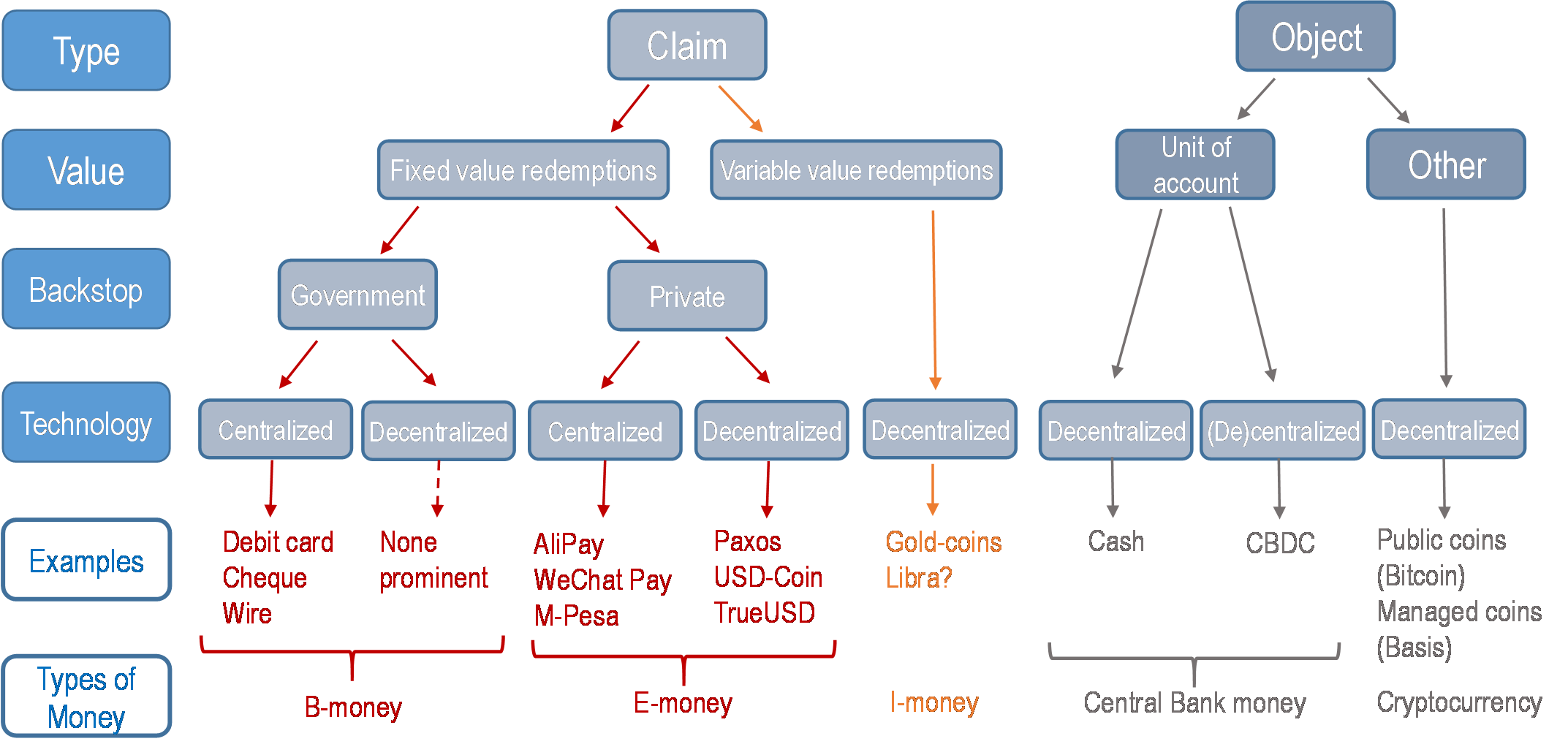
Note: CBDC = central bank digital currency. Source: https://www.imf.org/en/Publications/fintech-notes/Issues/2019/07/12/The-Rise-of-Digital-Money-47097
Technology: Is Blockchain becoming mainstream?
Payments, trade finance, and custodial services remain the clearest use cases for blockchain. The adoption of blockchain technology among stock exchanges to improve the efficiency around settlement/clearing and collateral management has been noteworthy. Exchanges around the world are embracing blockchain technology in their operations and seeking to launch new digital asset trading platforms. The potential beneficiaries of the new Distributed Ledger Technology (DLT)-based settlement/clearing system include banks and brokers who would see lower reconciliation costs and lower capital requirements (from potential real-time settlement), while registry service providers may be negatively impacted.
Deutsche Boerse has rolled out DLT solutions for collateral management in the securities lending market. Boerse Stuttgart launched a first of its kind digital asset exchange platform BSDEX, which allows investors to trade cryptocurrencies, with plans to extend this to other tokenized digital assets designed around markets such as real estate, investment funds, and debt. The Australian Stock Exchange has plans to replace its existing settlement/clearing system, Clearing House Electronic Subregister System (CHESS), with blockchain/DLT. Switzerland’s stock exchange has been working on launching a fully integrated, DLT-based end-to-end trading, settlement and custody service for digital assets later this year. QME (the commodity trading platform of the Hong Kong stock exchange) announced a partnership with Ant Financial to create a blockchain warehouse receipt alliance to prevent fraud. Traditional capital markets are also continuing the adoption of blockchain, with more assets becoming tokenized, and asset managers are exploring the roll out of digital asset solutions (Kambo and Parameswaran).
European banks continued to invest in blockchain initiatives in 2019, but we have yet to see tangible cost benefits. However, we continue to see long-term potential for DLT to transform banks’ business models and expect continued momentum in adoption in the medium term. In particular, we see Trade Finance blockchain solutions offering the most incremental efficiencies in the banking sector relative to other use cases, especially with payments largely digitalized and alternative Know Your Customer (KYC) solutions through other mediums available. The $2trn+ Traditional Documentary Trade segment has yet to achieve end-to-end digitalization, but blockchain has demonstrated its potential to materially reduce inventory lead times and lower operational costs, especially through the use of smart contracts. While we see widespread implementation of blockchain solutions at least three to five years away, challenges such as the macro-economic environment, legal and regulatory frameworks and technical challenges—such as cross-platform integration—may decelerate further progress (Sinha and Shah).
Blockchain technology has been gathering interest and attention from industry players as having the potential to disrupt traditional US banking for mid- and small-cap banks, but Alexopoulos et al. find that regional banks are in the early innings of adopting blockchain technology into day-to-day banking. Commercial payments were the focus for the first use case of blockchain technology by US banks, with a mid-sized regional bank, Signature Bank, taking the lead. In addition, while large multinational banks have for the most part stayed away from providing banking services to cryptocurrency clients, smaller banks have been stepping into this opportunity to provide financial products to this rapidly-growing segment of the financial industry.
Blockchain for supply chain buzz has faded as other logistics and visibility solutions, particularly automation, better meet near-term needs for productivity. In transportation, competition for disruptive freight tech has increased, with automation gaining momentum. Ossenbeck notes the potential to streamline transactions with a smart contract and isolate spoiled goods remain the most common use cases. However, the supply chain structure viewed as ripe for disruption is often a limiting factor in an industry still in the early days of leveraging data analysis, let alone applying new technologies. Specifically, digitizing information with tools such as blockchain is challenging when most of the sources are still “offline” in paper form. Instead, we see a larger potential disruption from automation. Self-driving trucks, as well as large and small drone cargo deliveries have emerged as the leading technologies for supply chain disruption.
Indeed, we believe that one of the reasons we have not seen even faster mainstream adoption of blockchain is the real world realization that there is a need for verification of the information going into a blockchain. The technology is very good at creating an immutable source of truth once the information is placed into a block, but the technology itself does not validate the source information in the first place. In our opinion, that is where industry-specific blockchain utilizing a consortium may be needed to provide verification capability to further advance mainstream blockchain adoption (Auty).
The Rise of Alternative Payments
The global payments landscape is evolving, with new systems allowing near-instant person-to-person retail payments increasingly available around the world. Asia represents the bulk of global growth in payments, driven in large part by the explosion in third-party (non-bank) and especially mobile providers. The volume of cashless payments has risen sharply in recent years, especially in Emerging Markets. In China and India, for example, the volume of cashless payments increased more than five-fold over 2014 to 2018, while the volume of cashless payments in Russia has tripled. The IMF notes that the value of e-money transactions in China, such as with WeChat Pay and Alipay, surpass those worldwide of Visa and Mastercard combined.6 Among the various types of noncash payments, card and e-money payments have grown faster. However, we note that despite the rise of cashless payments, cash use is still increasing in most countries. Indeed, only China, Korea, Singapore, Turkey, Indonesia, India, and the US (assuming 2017 numbers)—seven countries in total—have seen an increase in the value of cashless payments per inhabitant over the 2014-2018 time period (Harano).
The example of China suggests that the transition to a mostly cashless economy can be managed at scale. Younger et al. review the major third-party payments platforms in China, including business models, market structure, regulatory developments and importantly their interconnections to financial markets. Money market funds and bank wealth management products form key components of the Chinese financial system. The integration of these funds into online ecosystems (e.g., YU’E Bao and Alipay/Alibaba) helped drive explosive growth in AUM for wealth management products (WMPs) and money market funds (MMFs). YU’E Bao was briefly the largest fund in the world. The rise of digital MMFs led to outflows of personal deposits into money markets. The rapid growth of the digital MMF industry posed financial stability risks, including mismatches between assets and liabilities and redemption risks during periods of rising interbank rates. Timely regulatory intervention was key to managing this transition. Authorities introduced a temporary imposition on holdings and same-day withdrawals, which were lifted in April 2019. Digital MMF assets have stalled despite the lifting of regulatory limits, even as the money supply in China has continued expanding, likely reflecting much less attractive yield pick-up versus traditional bank deposits.
Cashless payments are growing rapidly in Japan, especially since government promotion started in October 2019. The Japanese cashless rate stood at 24% (BIS basis), but at 49% with direct debit/bank transfers. Credit card payments are driving the rise, and QR code payments are growing the most. Loyalty programs are also growing rapidly, supported by platformers’ reward ratios as high as 20% and the negative interest rate environment in Japan. Platformers’ loyalty points, with currently modest market size, could be used as an alternative payment measure as their ecosystems expand. It could bring issues for monetary policy/financial stability in the medium term (Nishihara).
Are stablecoins a scalable alternative to cryptocurrencies?
As Bitcoin and other freely floating cryptocurrencies continue to exhibit extreme volatility relative to fiat currencies, there has been much greater focus on stablecoins designed to minimize these price fluctuations. Younger et al. provide a primer on stablecoins and discuss key stability risks introduced by some designs. First, they argue that high-turnover payment systems require short-term liquidity facilities, particularly daylight overdraft provided by a non-economic central authority, to avoid gridlock—especially under stress. Second, the underbanked populations likely make up a small fraction of global payments volume, even after folding in the shadow economy. This means a world in which Libra or another stablecoin is successful is one in which its activity is dominated by developed markets—and by extension business-to-business (B2B) transactions with their associated reliance on intraday liquidity. Third, any system that relies on reserve asset income to fund operational and other ongoing costs becomes unstable in a negative yield world.
Younger et al. also examine the scalability of Libra and other stablecoins, particularly those backed by assets. They believe that the world is ready for private money, as most of the money in the world already comes from private issuers. However, private stablecoins are likely to face technical hurdles, including the need for intraday liquidity. If the experience of traditional banks is any guide, the institutionalization of stablecoins will come with significant regulatory oversight and costly compliance obligations. Second, they argue that given that DLT protocols are very energy intensive, less distributed, semi-private networks likely will be required. Third, they note that sourcing positive-yielding collateral may be difficult since a significant fraction of short-term high-quality sovereign debt is locked up in central bank balance sheets. The rise in negative-yielding debt poses a significant challenge to Libra and other fiat-backed stablecoins. While global financial markets are awash in high quality short-term government debt suitable as stablecoin collateral, only half offer positive returns. In our most recent J.P. Morgan Perspectives publication, What if US yields go to zero?, 16 January 2020, we outline why the persistence of very low nominal policy rates is here to stay.
Valuation: Far from institutionalized, but gap closing between market and intrinsic value for cryptocurrencies
The market capitalization of cryptocurrencies recovered from around $125bn a year ago to around $235bn, with Bitcoin increasing its dominance by accounting for nearly two-thirds of the total. Once ‘fake’ trading volumes such as wash trades are adjusted for, participation by institutional investors is now significant. In addition, the crypto market continues to mature with the introduction of new contracts on regulated exchanges, most recently with the launch of options on futures contracts in regulated exchanges.
Panigirtzoglou and Inkinen find that the gap that opened up between Bitcoin’s market price and their estimate of its “intrinsic” value has narrowed substantially, largely due to declines in the market price. Its market value continues to trade above their estimate of intrinsic value, suggesting some downside risk remains. However, volatility remains a severe impediment to broader adoption of cryptocurrencies. The IMF notes that the standard deviation of day-on-day changes in Bitcoin prices is roughly 10 times higher than in most G7 currency pairs, and even a little higher than in the Venezuelan Bolivar to US dollar exchange rate.7
That being said, we have seen some integration into mainstream apps and scaling. For example, we have seen companies like Square announce that they are working on a Lightning Development Kit to help integrate the Lightning Network into bitcoin wallets. Moves like this utilizing open source tools can help alleviate some of the scaling issues with bitcoin allowing the cryptocurrency to finally move into the realm of use for everyday payments (Auty).
Cryptocurrencies have yet to demonstrate their usefulness for hedging extreme macroeconomic environments and geopolitical flashpoints. The appeal of crypto assets for investors has been their low correlation to traditional asset classes, which has usually improved portfolio efficiency. However, even miniscule allocations remain impractical as long as the lack of legal tender status limits their transactional use and in turn their liquidity. While cryptocurrencies might serve some retail investors with a small asset base as one of several hedge instruments, it could not serve all retail investors nor institutional ones and corporates due to a liquidity constraint that is tough to circumvent without legal currency status to convey scale. Crypto assets are also still failing to rise as consistently as Bonds, the Yen, and Gold when Equities incur large drawdowns. Thus, Normand argues that crypto assets should form part of an investor’s long-term hedges, but more for the ability to hedge an environment that most countries have never experienced—entailing a loss of confidence in both the domestic currency and the payments system—because they still fail to deliver the same protection as more liquid defensives.
Venezuela’s Petro—supposedly the first sovereign cryptocurrency, and apparently backed by oil—was introduced with much fanfare, but it has gained little, if any, international traction. Instead, the Petro has thus far served as a reference price for domestic transactions inside Venezuela, and more recently as a vehicle to distribute social spending, pensions and bonus payments to government employees. In the end, the Petro has so far looked more like another (hyperinflationary) fiat currency (Ramsey).
Joyce Chang AC
joyce.chang@jpmorgan.com
J.P. Morgan Securities LLC
Kimberly Harano AC
kimberly.l.harano@jpmorgan.com
J.P. Morgan Securities LLC
Blockchain evolution: Moving into the mainstream?
- Blockchain starts to emerge to the mainstream.
- Bitcoin further solidified as platform of choice.
- Hurdles remain: garbage in, garbage out.
- Quantum computing raises future security questions.
It is often difficult to determine whether a new technology will catch on, and especially difficult to determine when a technology will go through its inflection point to really see mainstream adoption. But what has been consistent through the years are the phases that technologies must go through to reach that point of inflection. Notable technology writers including Geoffrey Moore (Crossing the Chasm) and Rita McGrath (Seeing Around Corners) use similar phases of hype, disillusionment (when the naysayers take over the message), emergence, and maturity. We believe the latter part of 2018 and beginning part of 2019 represented the timeframe when naysayers were owning the message that Blockchain and cryptocurrencies would not be successful. In the second half of 2019 and heading into 2020 we believe the groundwork has been laid for more mainstream adoption of the technology/cryptocurrencies.
Integration into mainstream apps and scaling are good signs. We have seen companies like Square announce that they are working on a Lightning Development Kit to help integrate the Lightning Network into bitcoin wallets. Moves like this utilizing open source tools can help alleviate some of the scaling issues with bitcoin allowing the cryptocurrency to finally move into the realm of use for everyday payments. Currently, transactions are limited to a maximum of around seven per second for bitcoin, and that is why in 2018 the Lightning Network was created as an off-chain peer-to-peer layer two payments protocol. Scaling remains one of the biggest hurdles to future adoption, but the level of activity in terms of research to solve the issue is very encouraging. Payments remains one of the clear use cases for blockchain, as does smart contracts, supply chain (companies like Cargill and Bumble Bee Foods are utilizing), secure transfer (medical records for companies like CVS), and custodial services (biggest being the DTC that supports the investment industry).
Bitcoin solidified as platform of choice. The technology challenges for bitcoin opened up the opportunity for alternative cryptocurrencies to fuel blockchain adoption. That led to a surge in alternative cryptocurrencies, many with questionable initial coin offerings (ICO) making it challenging for companies to understand where to focus. One could argue the peak was the 2019 failed release of Facebook’s Libra. All in all, we believe this has further emboldened bitcoin as the platform of choice and motivated the increase in research to solve challenges like scaling.
Garbage in, garbage out. One of the reasons we believe we have not seen even faster mainstream adoption of blockchain is the real world realization that there is a need for verification of the information going into a blockchain. The technology is very good at creating an immutable source of truth once the information is placed into a block, but the technology itself does not validate the source information in the first place. This is where building processes that in some cases are manual, or in the best case utilize real-world sensors to validate information, are needed to ensure accuracy of information going into a blockchain. In our opinion, that is where industry-specific blockchain utilizing a consortium may be needed to provide verification capability to further advance mainstream blockchain adoption.
Quantum computing raises security questions. Some of the most important characteristics around the use of blockchain as a technology include the security and ability to provide an immutable record. The security aspects are centered around encryption (cryptographic hash) that potentially could be put at risk from the power of quantum computing. Unlike today’s computers where information can only exist in two states 1 or 0 (binary computing), quantum computing uses quantum bits (qubits) that allow it to store a huge amount of information rather than just 0 and 1. This provides the capability to complete what today’s computers would consider massively complex calculations in a fraction of the time. Today’s encryption standards using traditional computing methods would take an unreasonable amount of time or resources to crack using force methods. However, there is an argument that quantum computing would be able to break the encryption in a matter of minutes. We are still in the early stages of seeing the capability of the first generations of quantum computers, but it could require a fundamental change to the encryption foundation being utilized in blockchain and bitcoin.
Sterling Auty, CFA AC
sterling.auty@jpmorgan.com
J.P. Morgan Securities LLC
Blockchain adoption in US financial services: Early innings but Signature Bank stands out
- Commercial payments a focus for first use case of blockchain technology by US banks as a mid-sized regional bank takes the lead.
- Large banks shy away from banking cryptocurrency companies, but smaller banks have stepped in to fill a gap in providing banking services.
- A handful of smaller banks step out from the pack, with Signature Bank an early mover.
Early use cases of Blockchain at regional banks focused on commercial payments
As emerging technologies continue to disrupt every industry on the planet, the US bank industry remains fully ripe for disruption. In particular, blockchain technology has been gathering interest and attention from industry players as having the potential to disrupt traditional banking. Looking across our US mid- and small-cap banks universe, we find that regional banks are in the early innings of adopting blockchain technology into day-to-day banking. In fact, most regional banks are in a wait-and-see mode to observe what larger banks or fintechs end up developing before potentially investing in the technology. This fast follower approach is largely due to limited technology budgets at smaller regional banks when compared to the largest US banks in the country, which have annual technology budgets in the $10+ billion range. However, we would note that there are exceptions for regional banks as some smaller players are going head-to-head with some larger banks.
Banks developing use cases for Blockchain have initially been around the commercial payments space to reap the benefits of blockchain technology in the form of lower cost, faster and around-the-clock settlement, fewer errors, and other benefits. First movers developing blockchain use cases include J.P. Morgan’s JPM Coin and Wells Fargo’s Digital Cash. In February 2019, J.P. Morgan announced plans to launch JPM Coin, which is a digital coin representing US dollars held on deposit at JPMCB, designed to facilitate payments between institutional JPM clients.8 In September 2019, Wells Fargo announced the testing of Wells Fargo Digital Cash, an internal platform to support real-time payments processing and settlement for cross-border payments.9 Meanwhile, a mid-sized regional bank, Signature Bank, was the first to reveal its blockchain-based Signet payments platform in December 2018.10
Signature Bank first to market with Blockchain-based payments platform
On 1 January 2019, $49 billion asset size Signature Bank became the first US bank to launch a blockchain-based proprietary payments platform via partnering with trueDigital Holdings, a fintech focused on blockchain-based infrastructure, exchange, and settlement technology. The Signet platform was approved by the New York State Department of Financial Services, making Signature Bank the first bank to receive regulatory permission to use blockchain in this capacity. Signet allows Signature Bank’s commercial clients to make real-time payments in US dollars to other Signature commercial clients at no cost, eliminating the need for a third party to facilitate the payment. This new vertical should provide a steady stream of low-cost deposits as customers sign up for the service. Clients using Signet are required to maintain minimum deposit balances of $250,000 that are FDIC-insured. Signet allows commercial clients to make payments in US dollars 24/7, which compares to traditional corporate payments using the SWIFT interbank platform or the Automated Clearing House (ACH) network, which can take as long as three days and are generally not available on weekends. In January 2020, Signature Bank announced its partnership with Prime Trust, a fintech providing infrastructure solutions for the digital economy.11 Prime Trust’s Prime Settlement Network will leverage the Signet platform to provide real-time payments and settlement services to Signature and Prime Trust’s institutional clients.
In this use case, the first customer to sign up was power supply company American PowerNet, which chose to use Signet to facilitate real-time payments within the renewable energy sector and to purchase power for Pennsylvania. Signet would allow American PowerNet to settle with power generators on a daily basis once schedules are confirmed, as compared with the traditional 30-day payment structure that has long been the industry standard. The Commonwealth of Pennsylvania, through its electric supplier relationship with American PowerNet, is the first entity in the country to purchase its power using Signet. Additionally, the Lancaster County Solid Waste Management Authority has also begun to incorporate Signet into its regular transactions of buying and selling power via American PowerNet’s Verde Blocks platform, a blockchain technology that provides large retail electric buyers direct access to sustainable power generators. This use case displays the potential for clients in all industries to leverage the bank’s blockchain platform to improve the flow of money.
Small banks step in to bank crypto-related businesses, as large banks shy away
While large multinational banks have for the most part stayed away from providing banking services to cryptocurrency clients due to the ambiguity on how they are regulated, as well as a volatile trading market, smaller banks have been stepping into this opportunity providing financial products to this rapidly-growing segment of the financial industry. Top concerns are around anti-money laundering regulation that require banks to identify customers and the flow of funds. Today, there are only a handful of small banks in the US that operate in this space, including New York-based Signature Bank (SBNY) and Metropolitan Commercial Bank (MCB) within our coverage universe, as well as California-based Silvergate Bank (SI), which serves over 750 digital currency clients. While some money-center banks have announced intentions to offer some form of digital currencies (JPM Coin12 and Wells Fargo Digital Cash, for example), beyond that, large banks’ involvement in this space has been very limited.
Silvergate Bank has the highest exposure to cryptocurrency clients
Although Silvergate Bank was founded in 1988, its push into becoming a prominent player in providing digital currency products did not begin until 2013. Today, $2.1 billion asset size Silvergate provides to its 750+ fintech clients various banking solutions including real-time 24/7/365 settlements for currency transactions (through its no-fee Silvergate Exchange Network), support services for digital currency exchanges including cash management products, and traditional bank accounts (with online banking and debit card functionality). Silvergate’s fintech clients include cryptocurrency exchanges, large institutional investors that hold positions in digital assets, and blockchain miners and service providers (that hold a combined $1.3 billion in deposits, primarily non-interest bearing, at Silvergate). In 3Q19, Silvergate’s Exchange Network processed over $10 billion of USD transfers across 12,000 unique transactions, and the company has 250 prospective digital currency customers in its pipeline. The value proposition in the network is that it enables its participants to transact US dollars at any time, even outside of regular market hours, with funds clearing immediately, compared to a legacy process that can take anywhere from several hours to several days to complete. On the deposit accounts that the company provides to its digital currency clients, today Silvergate is one of only a handful of financial institutions that has the ability to open these accounts in a way that is regulations-compliant.
Metropolitan Commercial Bank banks cryptocurrency clients, but a small contributor to overall banking
Another small-sized bank that banks cryptocurrency clients is New York-based $3.1 billion asset size Metropolitan Commercial Bank, although at a smaller scale than Silvergate. As of 2Q19, Metropolitan Commercial Bank held $213 million in deposits from digital currency-related customers, or 9% of total deposits at the bank. Not only does Metro gain access to low-cost funding from banking digital currency-related clients, but it also earns fee income from these relationships by providing services such as wire transfers, ACH, and foreign exchange conversion at the same fee as is charged to digital currency-related clients. The niche client base includes cryptocurrency exchanges, hedge funds, and other cryptocurrency investors that seek to move money and use other banking services. We note that deposit balances for digital-currency clients have been on a decline every quarter since 2Q18 and therefore this activity has been a smaller driver of deposit growth.
Steven Alexopoulos, CFA AC steven.alexopoulos@jpmorgan.com J.P. Morgan Securities LLC | Alex Lau alex.lau@jpmorgan.com J.P. Morgan Securities LLC |
Anthony Elian, CFA anthony.elian@jpmorgan.com J.P. Morgan Securities LLC | Janet Lee janet.s.lee@jpmorgan.com J.P. Morgan Securities LLC |
Nikhil Potluri nikhil.potluri@jpmorgan.com J.P. Morgan India Private Ltd. | |
Blockchain adoption in European financial services: Exchanges embrace settlement and clearing efficiencies
- Blockchain technology has the potential to drive efficiency gains across the sector especially in areas of settlement and clearing.
- Exchanges are embracing blockchain technology in their operations; seeking to launch new digital asset trading platforms.
- Traditional capital markets are continuing the adoption of Blockchain, with more assets becoming tokenized.
- Asset managers are exploring the roll out of digital asset solutions.
Blockchain adoption: Stock exchanges
The adoption of blockchain technology among stock exchanges offers scope to improve the efficiency around settlement/clearing and collateral management. Settlement in the exchanges space is currently typically T+3 days, but the delay is principally due to market practices, financial industry laws, and regulatory requirements and not necessarily to current technological infrastructure. The industry has discussed the potential to reduce settlement time, and the implementation of Blockchain could act as a catalyst to drive down the settlement period towards T+0 over time.
Deutsche Boerse has rolled out DLT solution for collateral management
Following Deutsche Boerse’s investment in technology firm HQLAˣ in early 2018, in December 2019 Deutsche Boerse and HQLAˣ launched their jointly developed Distributed Ledger Technology (DLT) solution for frictionless collateral swaps in the securities lending market, with live transactions executed by Commerzbank, Credit Suisse and UBS on the Eurex Repo F7-trading system. The HQLAᵡ operating model leverages distributed ledger technology to enable atomic Delivery versus Delivery (DvD) for baskets of securities residing at multiple custodians. DvD enables capital savings by reducing the consumption of intraday credit and liquidity.
Australian Stock Exchange advancing in implementation of blockchain technology
In the exchanges universe, the Australian Stock Exchange is at a relatively advanced stage to embrace Blockchain/DLT as it seeks to replace its existing settlement/clearing system (Clearing House Electronic Subregister System (CHESS)); however, we note that the planned implementation has been delayed from late 2020 to early 2021. ASX management has indicated that their version of DLT would involve a private permissioned ledger with key benefits including reduced costs for participants, continued trust (with the ASX being the single source of truth), and the availability of real-time data on settlements. ASX management believes that there will be no computational issues with using Blockchain technology to replace the CHESS system, as ASX will be the only entity who needs to verify the chain, unlike a public ledger which requires verification by multiple participants within the blockchain system.
The ASX initiative has attracted complaints from a range of current system users including Chi-X (which processes one-fifth of the Australian trades and relies on ASX’s clearing system) which joined share-registry firms, Computershare and Link Administration, in raising concerns over the CHESS overhaul. While ASX already has a monopoly on clearing and settlement, the firm believes that they will experience disruption and an unfair disadvantage as a result of the new system introduction. ASX is proceeding with the system rollout, while the debate on the financial benefits of the new system, as well as the security offered by a non-consensus algorithm-based ledger continues.
Swiss Stock Exchange working towards SIX Digital Exchange rollout
Switzerland’s stock exchange has been working on launching a fully integrated, Distributed Ledger Technology-based end-to-end trading, settlement and custody service for digital assets. The new platform, known as the SIX Digital Exchange (SDX) was expected to launch in H1 2019, but was delayed into H2 2019 and now further into 2020. The delays are reportedly caused by the changes to the legislation required to accommodate digital exchanges and assets. The service will provide a safe environment for issuing and trading digital assets, and enable the tokenization of existing securities and non-bankable assets to make previously untradeable assets tradeable, as well as to reap the benefits of nearly instant settlement and the potential for fractional ownership. SIX trialed the first prototype in late 2019, aiming to demonstrate the integration of a distributed CSD (central securities depository) with the conventional model of a stock exchange. The prototype featured digital security token issuance, live trading, and instant settlement. The second prototype, due to be released in the coming months, will feature asset servicing and post trade services.
Boerse Stuttgart launched a digital asset exchange
In September 2019 Boerse Stuttgart launched a digital asset exchange platform BSDEX, which allows investors to trade cryptocurrencies, with plans to extend this to other tokenized digital assets designed around markets such as real estate, investment funds, and debt. The platform is regulated and is the first of its kind in Germany offering investors a modern and transparent way to directly trade digital assets by avoiding time and costs associated with intermediaries such as brokers.
The potential beneficiaries of the new DLT technology based settlement/clearing system include banks and brokers who would see lower reconciliation costs and lower capital requirements (from potential real-time settlement). Registry service providers may be negatively impacted as they will lose interest income on cash balances, and the service of providing ownership information may become redundant since exchanges will have access to that information quite readily.
In the long run, as the pool of tokenized securities grows, we believe digital exchanges could put pressure and increase competition among the traditional brokers and asset managers.
Blockchain adoption: Capital markets
Fidelity expanding digital asset custody and trading
Fidelity announced in October 2018 that it would be launching Fidelity Digital Asset Services (FDAS) to offer as institutional-grade digital asset custody, trade execution, and dedicated client service. Since then the company noted a “significant interest and engagement by the institutional community, which show no signs of slowing,” and in December 2019 formed a UK subsidiary to formalize the provision of digital asset services in Europe.
State Street collaborates with Gemini on reporting
In December 2019 State Street announced it will collaborate with the Cryptocurrency exchange and custodian Gemini Trust to integrate Gemini’s digital asset custody solutions into State Street’s investment reporting, enabling investors to have an integrated interface for investment reporting spanning their digital and traditional assets.
QME and Ant Financial launched a blockchain warehouse receipt alliance to prevent fraud
QME (the commodity trading platform of the Hong Kong stock exchange) announced a partnership with Ant Financial, to integrate warehousing and logistics, using blockchain technology to provide transparency for the entire lifecycle of a commodity. Warehouse receipts, which can be used as collateral for finance, have been subject to widespread fraud in recent years, and blockchain technology allows a receipt to be better tracked and authenticated, hence preventing potential for double financing.
Blockchain facilitates the debt issuance process
Blockchain technology has been used to improve the process of bond issuance by enabling more efficient bookkeeping, underwriting, pricing and allocation of bonds. Blockchain is also seen as enabling better transparency in the allocation of debt securities by issuers, an area where, in some instances, a conflict of interest could exist.
2019 saw an increasing number of blockchain bonds being issued. For example, the Bank of China completed the issuance of 20bn yuan ($2.8bn) of bonds using its proprietary blockchain system. In addition, Santander issued a tokenized $20mn bond on the public Ethereum Blockchain. BBVA has completed a number of loans ranging between €35mn and €1bn using its Blockchain loan platform, which also won it the Bankers Tech Projects Award in 2019.
Following its launch of bond-I (the world’s first bond to be created, allocated, transferred and managed through its life cycle using distributed ledger technology) the World Bank announced in 2019 it has raised an additional A$50mn, and the second tranche has taken the total capital raised by bond-I to A$160m. The bond is part of a broader strategic focus of the World Bank to harness the potential of disruptive technologies for development. In June 2017, the World Bank launched a Blockchain Innovation Lab to understand the impact of Blockchain and other disruptive technologies in areas such as land administration, supply chain management, health, education, cross-border payments, and carbon market trading.
Gurjit S Kambo, CFA AC gurjit.s.kambo@jpmchase.com J.P. Morgan Securities plc | Siddharth Parameswaran AC siddharth.x.parameswaran@jpmorgan.com JP Morgan Securities Australia Ltd |
Banks’ adoption of Blockchain: Latest developments in distributed ledger technology
- Banks have continued to invest in blockchain initiatives in 2019, but we have yet to see tangible cost benefits. However, we continue to see long-term potential for Distributed Ledger Technology (DLT) to transform Banks’ business models, and expect continued momentum in adoption in the medium term.
- We see Trade Finance Blockchain solutions offering the most incremental efficiencies in the Banking sector relative to other use cases, especially with Payments largely digitalized and alternative KYC solutions through other mediums available.
- While we see wide-spread implementation of blockchain solutions at least three to five years away, challenges such as the macro-economic environment, legal and regulatory frameworks and technical challenges, such as cross-platform integration may decelerate further progress.
Developments in Blockchain applications for the banking industry
Following on from our Blockchain and Cryptocurrencies 2019: Adoption, Performance and Challenges, J. Loeys et al., 24 Jan. 2019 report, we look at the progress that the Banking sector has made in 2019 on blockchain initiatives and our expectations for the medium term. While we continue to see wide-spread Blockchain adoption at least three to five years away, progress has been made in 2019 with a growing number of Banks’ supported Blockchain platforms in live operation across key business segments such as Trade Finance and Payments, inter-operability solutions piloted across platforms with the same underlying technology, and a growing awareness across the financial community (Global Banks, Regulators and other stakeholders) of the potential benefits of blockchain adoption.
We continue to see significant long-term potential for Blockchain to transform Banks’ business models once scale has been achieved, but we also see near-term headwinds outside of Banks’ control, which may impede progress
We expect continued momentum in the medium term, particularly in areas such as network expansion for Trade Finance platforms, but we also outline several challenges that could negatively affect further progress: 1) With the macro-environment more dovish compared to a year ago, we see Global Banks responding to increased revenue pressures through cost-cutting and a reduction in discretionary investment programs, which could directly impact funding into Blockchain consortiums and programs, resulting in slower progress and operational challenges; 2) The legal and regulatory framework for Blockchain/Crypto globally remains incomplete resulting in a deficient ecosystem, hindering widespread adoption in our view—although we note that Central Banks have paid close attention to developments, particularly around Payment systems (e.g., Facebook’s Libra); 3) Technical challenges remain including cross-platform integration and a lack of standardization resulting in hurdles when upscaling platforms. We continue to see Blockchain’s long-term potential, once scale has been achieved, through the transformation of manual/cost-intensive processes that could drive more efficient business models in the Banking sector.
Since the cryptocurrency boom in 2017, expectations of the transformative qualities of Blockchain for the Banking sector and the time horizon of development and adoption of initiatives have rebased. We note that PWC’s 2017 Global Fintech Report surveyed >1.3K executives and showed 55% of respondents planned to adopt Blockchain as part of processes by 2018 and 77% expected Blockchain to be a common element found in business processes by 2020, but we see this unlikely to materialize. We continue to see wide-spread Blockchain adoption at least three to five years away, but see progressive development across various initiatives. See our previous Blockchain reports from 2018 J.P. Morgan Perspectives: Decrypting Cryptocurrencies: Technology, Applications and Challenges, J. Loeys et al., 9 Feb. 2018) and from 2019 Blockchain and Cryptocurrencies 2019: Adoption, Performance and Challenges J. Loeys et al., 24 Jan. 2019, which address key use cases of Blockchain in the Banking sector, and expand on below.
Trade Finance represents one of Blockchain’s key opportunities where significant progress has been made to provide end-to-end digitalization
Trade Finance, and particularly the $2trn+ Traditional Documentary Trade segment, has yet to achieve end-to-end digitalization with Blockchain emerging as a potential solution to materially reduce inventory lead times and lower operational costs, especially through the use of smart contracts. Blockchain initiatives in Trade Finance have seen significant progress relative to other use cases with an increasing number of global Banks participating in pilot programs and some offering live solutions to clients (e.g., Societe Generale, HSBC, UniCredit, Know Santander, and UBS). In our view, given the palpable benefits to clients, we see Banks’ participation and investments into Trade Finance-related Blockchain initiatives both as defensive over market share and ultimately customer relationships, and geared towards new growth opportunities (e.g., products/clients/markets).
KYC Blockchain solutions offer the potential for significant cost-saving, but well-developed alternatives such as SWIFT’s KYC registry already exist
Blockchain offers a potential solution to reduce duplicative Know Your Client (KYC) processes performed by Banks and significantly reduce the on-boarding time for clients—which can take up to one month and in many cases, longer—reducing the overall KYC cost base. A Thomson Reuters survey in 2016 showed that the average firm paid $60mn a year for KYC compliance, with some spending up to $500mn annually. Such Blockchain solutions are still in production phases including Dubai’s KYC data-sharing consortium partnering with KYC blockchain developer ‘norbloc,’ which is planned for 1Q20, with several successful trials including R3’s KYC application partnering with 39 firms concluded. Blockchain technology for KYC processes has the potential to produce the most time efficiencies relative to other use cases.
However, we expect progress on blockchain KYC projects to continue to be challenged in areas including multi-jurisdiction hurdles on data sharing and privacy, lack of network effects, and concerns around transferring KYC responsibilities, but not liabilities to third parties (i.e., other institutions on the Blockchain). Further, the availability of alternate solutions such as SWIFT’s KYC registry, which is already used by more than 5k financial institutions and provides substantial time efficiencies,13 may hinder widespread adoption of a blockchain solution (even if incrementally more efficient)—although we note underlying differences in the technology such as the responsibility of validation.
Syndicated Lending offers high margin potential, but is still reliant on manual processes, with Blockchain a potential solution to digitalize
Syndicated Lending offers Banks high margin potential, but is still reliant on manual processes with 20+ day settlement cycles due to the quantity of information exchanged, lengthy reviews and the paper forms of communication between parties. Blockchain offers a potential solution to digitalize this process, reducing complexity and operational risk. Finastra is one of the companies at the forefront of Blockchain-based Syndicated Lending with its Fusion LenderComm platform partnering with multiple banks such as RBS, BNP Paribas, HSBC and ING. However, given the larger volume of transactions in Trade Finance relative to Syndicated Lending, and hence the greater potential to reduce aggregate inefficiencies, we see Trade Finance Blockchain solutions and partnerships as more of a focus for Banks, in our view.
New use cases such as document management, Blockchain mortgages and custody platforms are in development, driven by the continuing need to digitalize processes
While much of the Blockchain attention in the Banking sector is drawn toward developments in Payments and Trade Finance, new initiatives are emerging for other Banking processes. Poland’s Alior Bank announced plans to use a public Blockchain for client document management, allowing clients to verify and authenticate their documents by matching hash codes—a notable difference to other initiatives that use private Blockchains. RBS is also working on a Blockchain solution for the mortgage process to enable background data to be shared with relevant parties (e.g., lawyers, conveyancers), giving clients more transparency with the process. Further, HSBC has plans to shift $20bn of assets to a Blockchain-based custody platform (“Digital Vault”) by March, giving investors real-time access to records of securities bought on private markets. We also note that Citigroup and Goldman Sachs recently completed the first total return swap transaction using DLT on Axoni’s Blockchain platform to process trade data, which allows for continuous reconciliations between parties during the trade lifecycle.14
Widespread adoption for Trade Finance Blockchain solutions remains three to five years away
Network expansion through organic and inorganic means is the key next step to drive participation in the supply chain. Through 2019, Banks have featured in pilot programs globally across multiple Trade Finance Blockchain platforms, producing evidence that Blockchain technology can provide efficiency gains (e.g., costs, time) to the supply chain. In our view, the next key step for Banks and consortiums towards the ultimate goal of full-scale Blockchain adoption is network expansion, as this provides scalability and wide acceptance across supply chains. We expect network growth to be achieved organically (i.e., new Financial Institutions and their client networks joining as participants in programs) or inorganically (i.e., consolidation of Blockchain projects where Banks are mutually inclusive or inter-technology/cross-platform integration between programs).
The number of participants in Blockchain projects provide an indication as to the level of adoption seen—which we expect to grow in the medium term through positive feedback loops
Below, we highlight the scale of current Blockchain programs within the Trade Finance and Payments segments—we focus on these segments as this is where we have seen the most progress and where Blockchain technology could be significantly impactful on Banks’ business models. While we note that each project offers different solutions and may be geared towards a particular geographic region, the number of participants provides an indication as to the level of progress made by each program given the importance of network expansion. The Interbank Information Network® has the highest level of adoption so far with 400 Global Financial Institutions having signed letters of intent to join, of which over 90 are live participants, followed by Marco Polo and the Letter of Credit Network programs, which have core Financial Institution members. Komgo has cross-industry uptake with shareholders that include banks like Citi, BNP Paribas, and ABN Amro, alongside trading houses like Koch and Mercuria, and energy majors like Shell.15 Vakt is an example of an industry-specific network with over a dozen energy market investors as network participants.16 We expect continued growth in the participant base in the medium term, particularly as programs mature and the number of successful transactions increase, creating positive feedback loops.
Successful pilots show platform inter-operability is achievable where the underlying technology is consistent, but cross-platform integration remains a challenge
Inorganic network growth with programs using the same underlying technology (e.g., Marco Polo and Letter of Credit Network using R3 Corda) is relatively easier from an operational and governance perspective compared to the challenges faced with cross-platform integration. We note that HSBC has successfully piloted a Letter of Credit in 2019 using inter-operability between two Blockchain programs: Letter of Credit Network and ReChainME, both on R3 Corda technology. Similarly, multiple Asian banks also trialed a shipping trade finance transaction in 2019 using eTradeConnect and Global Shipping Business Network programs, both operating on Hyperledger technology. However, we are beginning to see pilots demonstrating successful, cross-platform integration. A prototype network, using the underlying technology developed by J.P. Morgan, and announced by the Monetary Authority of Singapore and Temasek, as part of Phase 5 of Project Ubin, demonstrated a Quorum-based payments network that provided interfaces for other non-Quorum blockchain networks (such as Hyperledger, DAML) to connect and integrate to support use cases such as Delivery-versus-Payment (DvP) settlement with private exchanges, conditional payments and escrow for trade, as well as payment commitments for trade finance.17
Table 1: Key Blockchain Initiatives
| Name | Number of Participants (JPMe) | Underlying technology | Application | Stage in cycle |
| Contour (formerly Voltron and Letter of Credit Network) | 8 Financial Institutions and the R3 consortium | R3 Corda | Letters of Credit | Expected to go live in 2020 |
| We.Trade | 15 European Financial Institutions | IBM Blockchain Platform using Hyperledger Fabric | Open Account trade and Trade Finance for SMEs | Live |
| Marco Polo | 30 Financial Institutions and the R3 consortium | R3 Corda, Trade IX | Open Account trade | Expected to go live in 2020 |
| komgo | 15 core shareholders (o.w.10 Financial Institutions) and 2 non-shareholder members | Quorum, a permissioned-variant of the Ethereum blockchain | Letters of Credit, Open Account trade, KYC solutions, Certification processes | Live |
| VAKT | 12 members (o.w. 3 Financial Institutions) | Quorum, a permissioned-variant of the Ethereum blockchain | Post-trade management in commodities trading | Live |
| eTradeConnect | 7 initiating Financial Institutions and 5 member Financial Institutions – Asia focused | IBM Blockchain Platform using Hyperledger Fabric | Open Account trade and Trade Finance | Live |
| Interbank Information Network® | 400 Global Financial Institutions have signed letters of intent; 90 are live currently | Quorum, a permissioned-variant of the Ethereum blockchain | Information sharing related to global cross-border payments | Live |
| Axoni | 15 Financial Institutions | Variant of the Ethereum blockchain | Equity swaps | Live |
Source: J.P. Morgan estimates, Company reports. R3 Consortium contains >300 members.
Raul Sinha AC raul.sinha@jpmorgan.com J.P. Morgan Securities plc | Sheel Shah AC sheel.shah@jpmorgan.com J.P. Morgan Securities plc |
Distributed ledger technology/Blockchain
Distributed ledger technology (DLT) has the potential to disrupt payments, clearing, settlement and related activities. Distributed ledger technology draws on well-established technologies, as well as newer technologies like blockchain technology to operate a set of synchronized ledgers managed by one or more entities. In many financial markets there is a central ledger managing certain risks on behalf of participants. Distributed ledger technology could reduce the traditional reliance on a central ledger managed by a trusted entity. Distributed ledger technology may substantially change how assets are maintained or stored, obligations discharged, contracts enforced and risks managed. The key potential positives include:
- Reduction of complexity
- Improving processing speed, and thus speeding up the availability of assets and funds
- Reducing the need for reconciliation across multiple record-keeping ledger infrastructures
- Increasing transaction transparency
- Improving network resilience through distributed data management
- Reducing operational and financial risks
A key property of distributed ledger technology is the distribution of responsibilities for updating the ledger or transactions to multiple nodes. These nodes can be deployed across multiple sites, institutions and jurisdictions. This is depicted in Figure 1. Depending on the rules implemented, changes to the ledger are reflected in all copies in a certain time span.
Figure 1: Ledgers distributed across multiple nodes
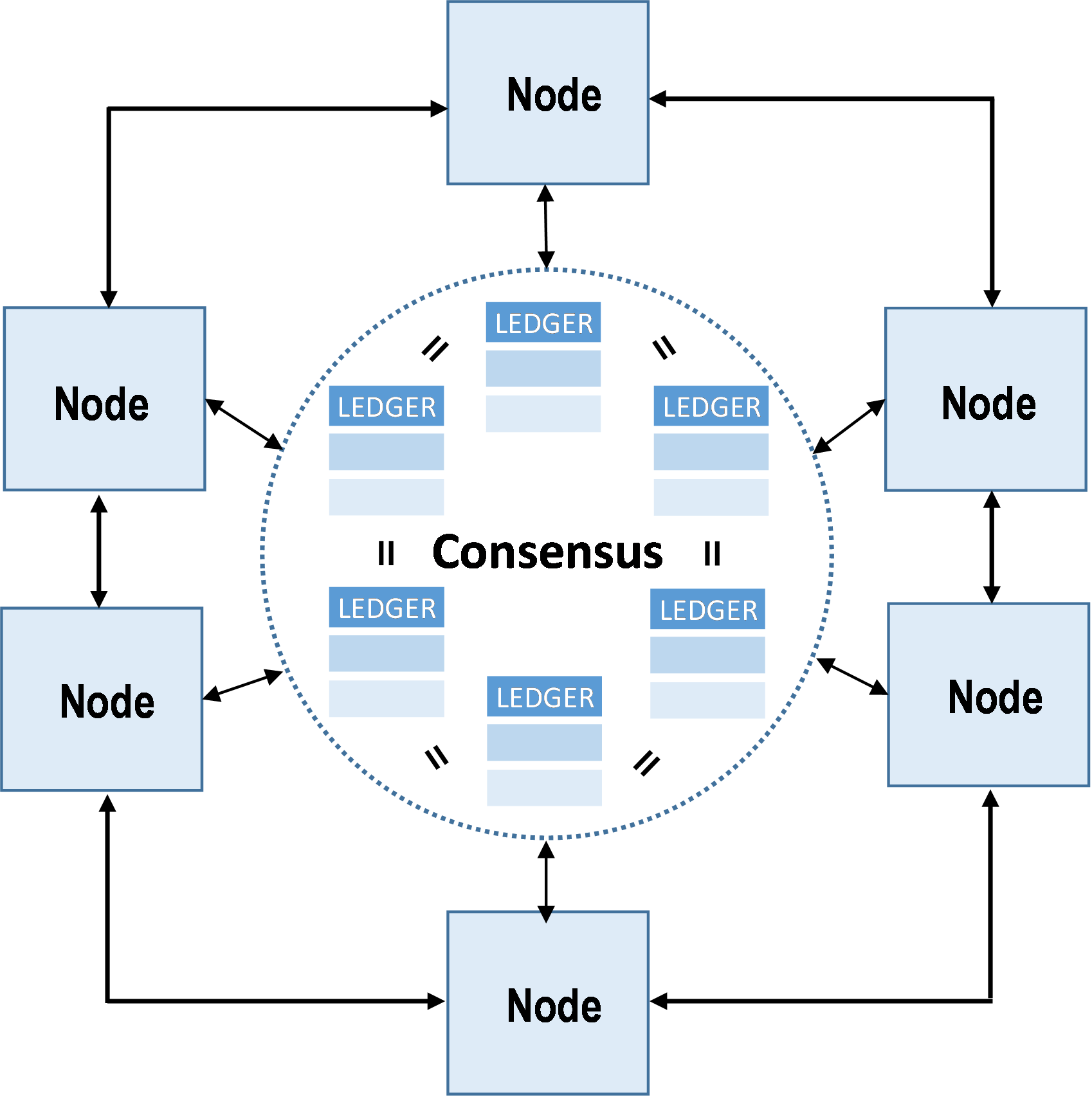
Source: Bank for International Settlements
Typically in order to maintain a synchronized ledger, a number of protocols are used for communication between the nodes and for facilitating consensus among nodes about the current state of the ledger and the historical record. Cryptography tools play an important role in DLT in terms of authenticating approved participants, confirming data records and facilitating consensus.
As part of the protocols, different nodes in the system may play different roles. These roles in a particular protocol may include, system administrator; asset issuer; proposer to update the ledger; validator to update the ledger; auditor of the ledger etc. Figure 2 shows an example payment transaction using DLT:
- To initiate a payment, Entity A uses cryptographic tools to propose an update to the shared ledger that would transfer funds from its account on the ledger to Entity B’s account on the ledger.
- Upon receiving the request, the other nodes authenticate Entity A’s identity to makes sure Entity A has the requisite permissions. Then verification to make sure Entity A has the requisite funds. Nodes agree on the consensus process about which transactions should be included in the next update to the ledger.
- After the update has been accepted by the nodes, the properties of the asset are modified so that all future transactions on that asset must be initiated using the cryptographic credentials of Entity B.
Figure 2: Process flow for a distributed ledger technology-based payment system
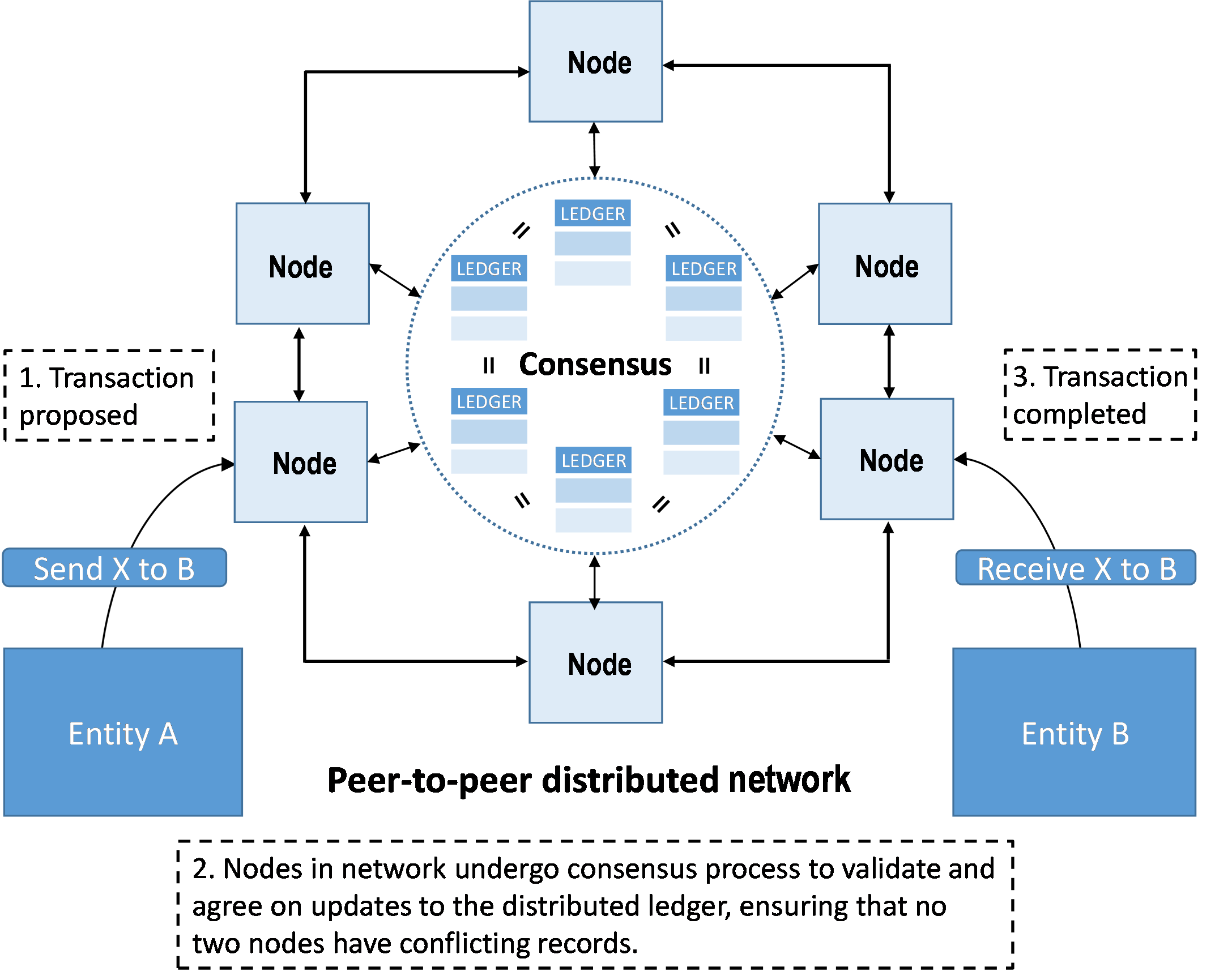
Source: Bank for International Settlements
For the full report, see Primed for payments: Growth and consolidation go hand in hand, Sandeep Deshpande and Varun Rajwanshi, 9 September 2019
Sandeep Deshpande AC sandeep.s.deshpande@jpmorgan.com J.P. Morgan Securities plc | Varun Rajwanshi, CFA AC varun.rajwanshi@jpmorgan.com J.P. Morgan Securities plc |
Blockchain in Transportation: Hurdles persist to widespread adoption
- Competition for disruptive freight tech has increased, with automation gaining momentum.
- Other collaborative logistics and visibility solutions meet near-term needs for productivity.
- Several hurdles remain for widespread adoption including standards and government integration.
Commercial viability remains a challenge
Use cases remain unchanged, still in proof of concept. The potential to streamline transactions with a smart contract and isolate spoiled goods remain the most common use cases. However, the supply chain structure viewed as ripe for disruption is often a limiting factor in an industry still in the early days of leveraging data analysis, let alone applying new technologies. Specifically, digitizing information with tools such as Blockchain is challenging when most of the sources are still “offline” in paper form.
Other hurdles include adoption models, complexity. Data quality is a concern for Blockchain if records are truly immutable, given the likelihood for entry errors. Dynamic networks would also have a difficult time maintaining Blockchain if updates are required but no longer centralized. Lastly, the path toward greater adoption is not clear and split between industry-led (push), or start-up-created (pull), to gain critical mass.
Competition has increased in freight tech
Larger potential disruption from automation. Self-driving trucks, as well as large and small drone cargo deliveries have emerged as the leading technologies for supply chain disruption. Recent testing in real-world applications with broadly supportive regulations have elevated the competition for Blockchain as a strategic imperative. Moreover, the potential long-term economic benefit of automation is more readily quantifiable after successful pilot programs even if it remains several years away from implementation at a larger scale.
Competing visibility and collaboration tools are in use. Logistics platforms such as Turvo (a real-time collaborative logistics platform) are already driving collaboration with existing systems and across different supply chain partners. Other hardware and software solutions have improved track and traceability beyond just “dots on a map” and extended the business case to working capital savings. These offerings are low friction software and can also rely on data gathered from existing assets or a low level of investment with IoT sensors.
Companies investing more in near-term productivity. Amid the recent volatility in global trade and US freight rates, public companies will make targeted efforts to drive cost savings with “low tech” applications. Process automation and leveraging internal data to improve asset utilization and freight visibility will likely remain focal points for companies looking to offset the challenges of a weaker freight market entering 2020.
Governmental agencies play a significant role
Cross-border trade integrates customs officials. Accelerating and streamlining customs clearing is a commonly cited use case for Blockchain. However, adopting this system would not only require shippers and carriers to join, but also governmental agencies from multiple countries. As noted in a recent paper from George Mason’s Mercatus Center,18 “rent seeking behaviors” could work against Blockchain adoption in instances of significant bureaucratic corruption.
Federal approval required for new consortiums. TradeLens, a Blockchain initiative for ocean shipping started by Maersk and IBM, signed up other global container vessel carriers, but will require US regulatory approval for cooperation amongst competitors. One railroad (CSX) joined TradeLens in November 2019, but could also attract similar scrutiny should other US railroads look to join the consortium.
On the back burner, but not going away
Blockchain for supply chain buzz has faded. After dominating the freight tech world in 2017/2018, Blockchain for the supply chain has fallen down the “Gartner hype cycle” and was not a key topic at the recent freight tech conference we recently attended. The lack of substantive progress with use cases and the rise of competing technologies with a larger potential for long-term disruption are part of the declining interest level.
Standards are critical and still under development. The Blockchain in Transportation Alliance (BiTA) formed in 2017 has ~500 member companies in 25 countries, including blue chips and tech-enabled “disruptors.” BiTA is facilitating common standard development and hosting education sessions. The lack of standardized data interchanges and software in legacy supply chains reinforces the need for an organization like BiTA to introduce a new framework, but the process will likely take a significant amount of time.
Brian P. Ossenbeck, CFA AC
brian.p.ossenbeck@jpmorgan.com
J.P. Morgan Securities LLC
The rise of noncash payments globally
- The volume of cashless payments has risen sharply in recent years, especially in Emerging Markets…
- …but the value of cashless payments has been more mixed; in several countries, the value of cashless payments adjusted for GDP declined over 2014-18.
- Card and e-money payments have grown more rapidly than other types of noncash payments.
- Despite the rise of cashless payments, cash use is still increasing in most countries.
- The 2019 Federal Reserve Payments Study shows similar trends for the US, with noncash payment growth accelerating in 2015-18.
The volume of cashless payments has increased sharply in recent years
The global payments landscape is evolving, with new systems allowing near-instant person-to-person retail payments increasingly available around the world. The BIS notes that fast retail payment systems operate in 45 jurisdictions, and this number is projected to rise to 60 in the near future.19
Indeed, BIS Red Book statistics show that the number of cashless payments20 has risen sharply in recent years, especially in Emerging Markets (Table 1). In China and India, for example, the volume of cashless payments increased more than five-fold over 2014 to 2018, while the volume of cashless payments in Russia has tripled.
At the other end of the spectrum, Singapore has seen the slowest growth in cashless payments, but that could be because noncash payments are already ubiquitous. As Figure 1 shows, the average inhabitant in Singapore made 831 cashless payments in 2018, substantially above the number of payments made per person in any other country. The next highest country, Korea, had only 547 payments per inhabitant in 2018, followed by Sweden with 529.
Table 1: The volume of cashless payments has risen sharply in recent years, especially in Emerging Markets
Total number (volume) of cashless payments by country, and CAGR; millions
| 2014 | 2015 | 2016 | 2017 | 2018 | 2014-18 CAGR | |
| China | 36,620 | 66,709 | 96,639 | 133,920 | 198,362 | 52.6% |
| India | 4,644 | 6,995 | 10,926 | 15,811 | 24,430 | 51.4% |
| Russia | 11,367 | 14,338 | 19,174 | 25,797 | 34,836 | 32.3% |
| Saudi Arabia | 498 | 587 | 736 | 947 | 1,286 | 26.8% |
| Indonesia | 4,773 | 6,029 | 7,416 | 8,985 | 11,044 | 23.3% |
| Argentina | 1,385 | 1,548 | 1,845 | 2,049 | 2,375 | 14.4% |
| Turkey | 3,748 | 4,165 | 4,620 | 5,325 | 6,274 | 13.7% |
| Korea | 18,896 | 21,131 | 23,215 | 25,717 | 28,230 | 10.6% |
| Mexico | 3,495 | 3,798 | 4,030 | 4,546 | 5,068 | 9.7% |
| South Africa | 3,432 | 3,798 | 4,386 | 4,484 | 4,940 | 9.5% |
| Australia | 9,060 | 9,936 | 11,003 | 12,257 | 12,941 | 9.3% |
| Italy | 4,709 | 5,177 | 5,698 | 6,035 | 6,700 | 9.2% |
| Switzerland | 1,799 | 2,022 | 2,146 | 2,327 | 2,547 | 9.1% |
| United Kingdom | 21,270 | 23,080 | 25,152 | 27,139 | 29,778 | 8.8% |
| Sweden | 3,900 | 4,202 | 4,777 | 4,995 | 5,380 | 8.4% |
| Netherlands | 6,452 | 6,796 | 7,174 | 7,800 | 8,707 | 7.8% |
| Spain | 6,490 | 6,475 | 7,069 | 8,176 | 8,607 | 7.3% |
| United States* | 128,237 | 135,139 | 142,962 | 154,448 | N/A | 6.4% |
| Germany | 17,620 | 19,370 | 19,931 | 21,009 | 22,260 | 6.0% |
| Brazil | 27,582 | 28,251 | 28,954 | 31,065 | 34,600 | 5.8% |
| Canada | 11,531 | 12,000 | 12,610 | 13,315 | 14,452 | 5.8% |
| France | 18,958 | 20,208 | 20,908 | 21,964 | 23,498 | 5.5% |
| Belgium | 3,436 | 3,239 | 3,436 | 3,852 | 4,254 | 5.5% |
| Singapore | 3,886 | 4,029 | 4,256 | 4,391 | 4,687 | 4.8% |
* For the US, 2018 data were not available, so the Compound Annual Growth Rate (CAGR) shown is for 2014-17. Source: BIS Red Book, J.P. Morgan
Figure 1: Cashless payments are most widely used in Singapore, Korea, and Sweden
Average number of cashless payments per inhabitant in 2014 and 2018

* For the US, 2018 data were not available, so 2017 numbers are shown instead.Source: BIS Red Book, J.P. Morgan
In contrast, although India, Saudi Arabia, and Indonesia have seen double-digit growth in cashless payments over 2014-18, noncash payments are still relatively uncommon in these countries: the number of cashless payments per inhabitant was only 18, 38, and 42 in 2018 for India, Saudi Arabia, and Indonesia, respectively.
The value of cashless payments has been more mixed
Although the total number of cashless payments increased for all countries in the sample above, the total value of these payments has been more mixed. In aggregate, the value of global cashless payments has increased significantly: for the 24 countries in the previous figures and including Japan, the value of such payments increased from $900trn in 2014 to approximately $1370trn in 2018 (assuming US values remained the same as in 2017).
Figure 2: The value of cashless payments adjusted for GDP has declined in several countries over 2014-18
Value of cashless payments as a ratio to GDP in 2014 and 2018; number
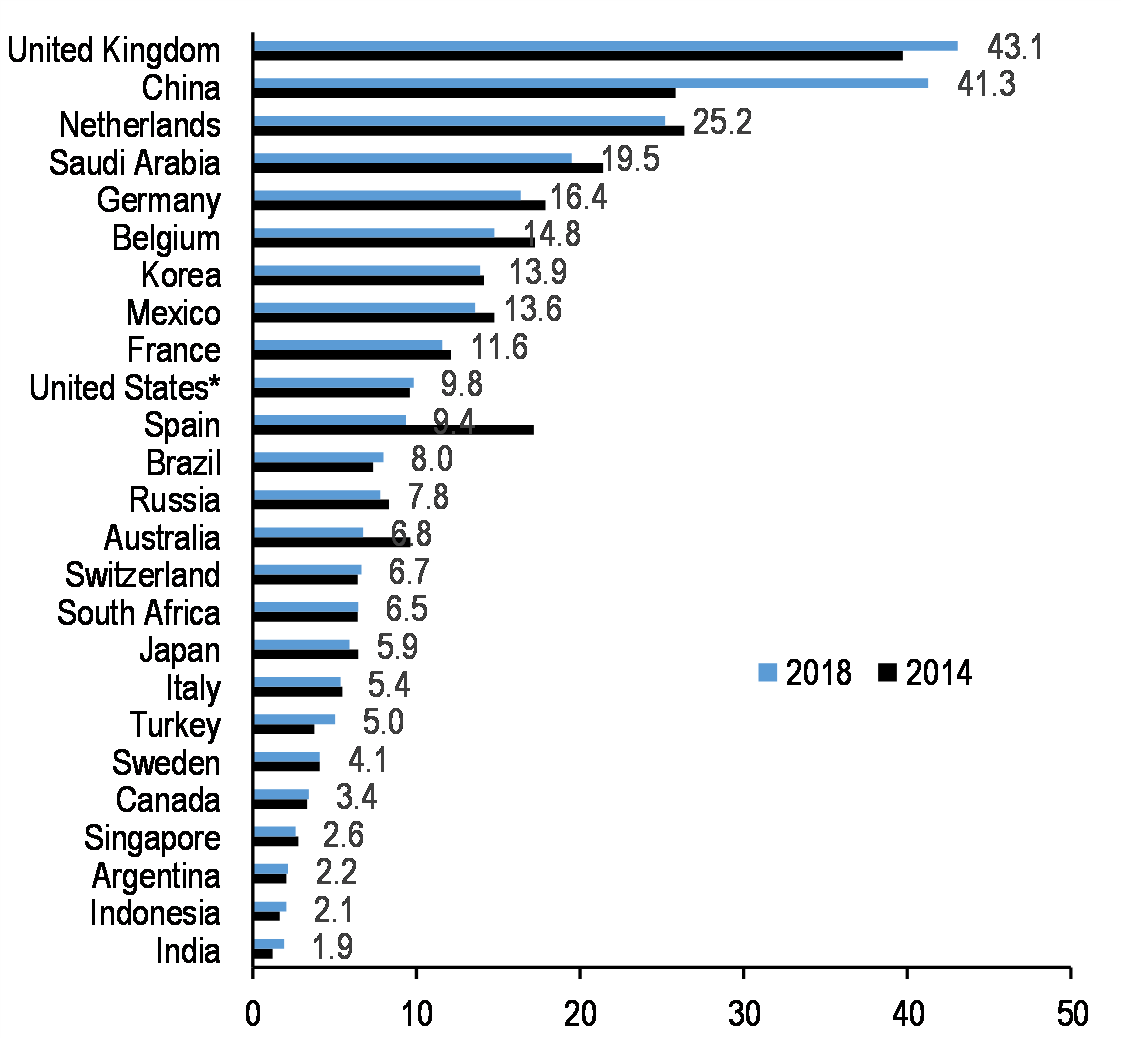
* For the US, 2018 data were not available, so 2017 numbers are shown instead.Source: BIS Red Book, J.P. Morgan
However, China alone contributed $280trn of this increase, and on a country-by-country basis, growth rates were more mixed. Of these 25 countries, only 11 saw an increase in the total value of cashless payments over 2014-18. If we adjust for population, then even fewer countries saw growth. Only China, Korea, Singapore, Turkey, Indonesia, India, and the US (assuming 2017 numbers)—seven countries in total—saw an increase in the value of cashless payments per inhabitant.
Another way we can look at these numbers is by adjusting for GDP. Figure 2, which displays the value of cashless payments as a multiple of GDP, shows that the UK and China had the highest value of cashless payments after adjusting for the size of the economy in 2018. And although these values increased over 2014-18, that was not the case for the next countries in the list: the Netherlands, Saudi Arabia, Germany, Belgium, and Korea all saw declines in the value of cashless payments relative to the economy.
Card and e-money payments have grown more rapidly than other types of noncash payments
Among the types of noncash payments, we find that the growth of card and e-money payments has outpaced the rest (i.e., credit/debit transfers and checks; see Figure 3). This makes sense as innovation and consumer preferences have driven payments towards more convenient electronic payment methods.
Figure 3: Card and e-money payments have grown more rapidly than other noncash payments
CAGR over 2014-18 for card and e-money payments and CAGR for all other noncash payments** by country; %
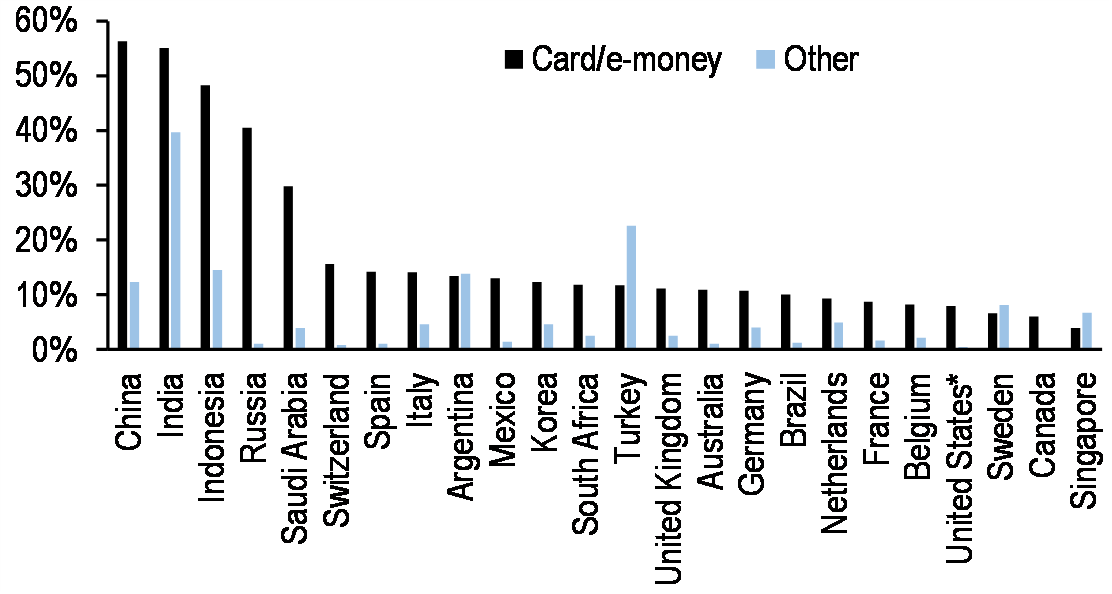
* For the US, 2018 data were not available, so the CAGR shown is for 2014-17.** To calculate all other noncash payments, we subtracted the number of card/e-money payments per inhabitant from the total number of noncash payments per inhabitant.Source: BIS Red Book, J.P. Morgan
Cash use is still increasing in most countries
This explosive growth of noncash payments begs the question of whether we are moving towards a cashless world. To answer this question, we looked at the change in currency in circulation as a percentage of GDP. As Figure 4 shows, cash has become a less important part of the economy for some countries. (We do note, however, that a negative number does not indicate that currency in circulation is actually declining; it could also indicate that currency in circulation is growing at a slower rate than GDP.) However, the majority of countries in our list actually saw currency as a percentage of GDP increase over 2014-18.
Figure 4: Although the importance of cash is declining in some countries, most countries saw an increase in cash use in 2014-18
Change over 2014-18 (%-pt; left axis) and 2018 level (%; right axis) for banknotes and coins in circulation as a percentage of GDP
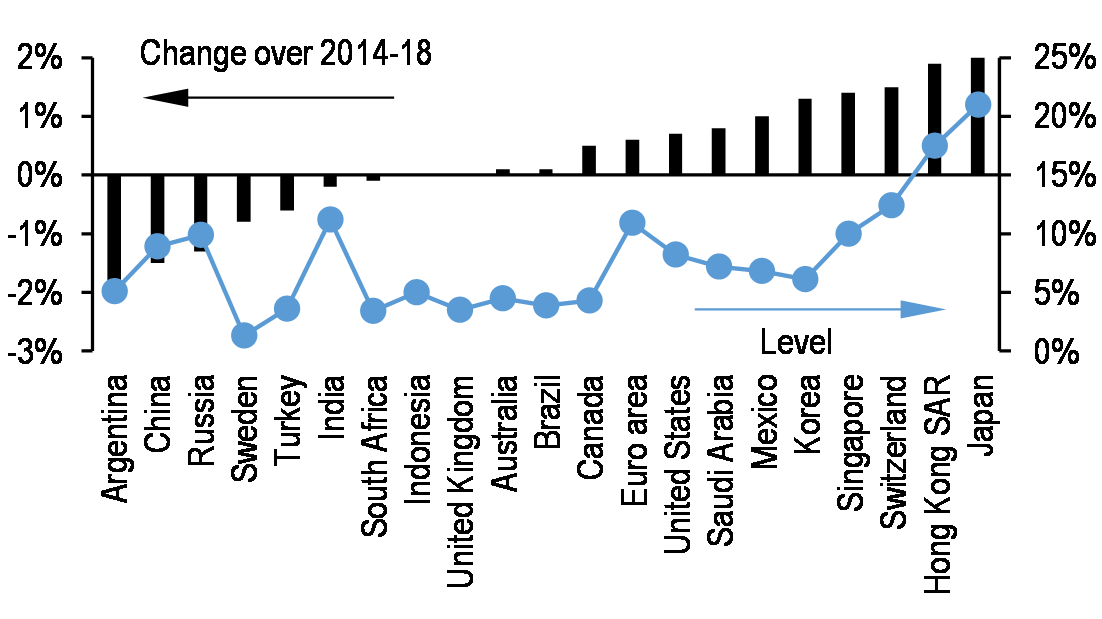
Source: BIS Red Book, J.P. Morgan
The 2019 Federal Reserve Payments Study shows similar trends for the US
In December 2019, the Fed released its seventh triennial study on noncash payment trends in the US, and its findings were similar to what we have discussed above. In 2018, the number of core noncash payments—defined as payments using credit or debit cards, the automated clearinghouse (ACH) system, or checks—rose to 174.2bn in 2018, up from 143.6bn in 2015 and 123.9bn in 2012. Figure 5 shows these transactions broken down by broad payment type. Similar to the global trend, card transactions in the US increased most dramatically (up 57% over 2012-18), followed by ACH transfers (up 38%), while check use declined 27%.
Figure 5: The number of card payments in the US have increased most dramatically over 2012-18, while check use has declined…
Number of payments in the US made using cards, ACH, and checks by year; billions
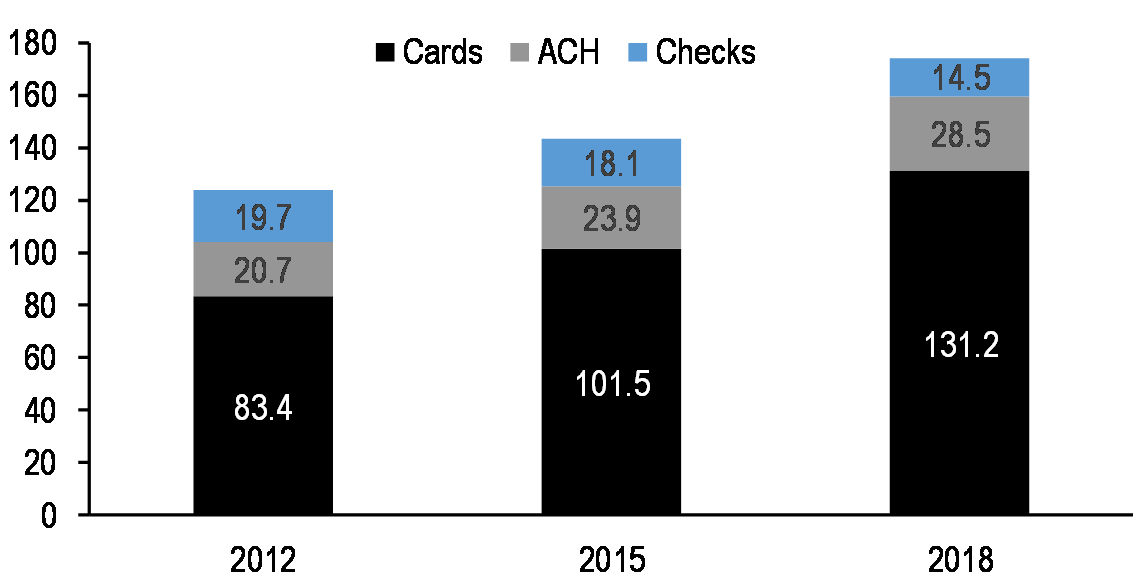
Source: The 2019 Federal Reserve Payments Study, J.P. Morgan
The value of noncash payments in the US also increased over 2012-18, rising from $78.0trn in 2012 to $86.8trn in 2015 and to $97.0trn in 2018. Although the number of card transactions dwarfs the other two payment methods, the value of card transactions is quite small—only $7.1trn in 2018 versus $64.2trn for ACH payments, which accounted for two thirds of noncash payments by value (Figure 6).
Figure 6: …but the value of card payments remains quite small compared to the other payment methods
Value of payments in the US made using cards, ACH, and checks by year; $trn
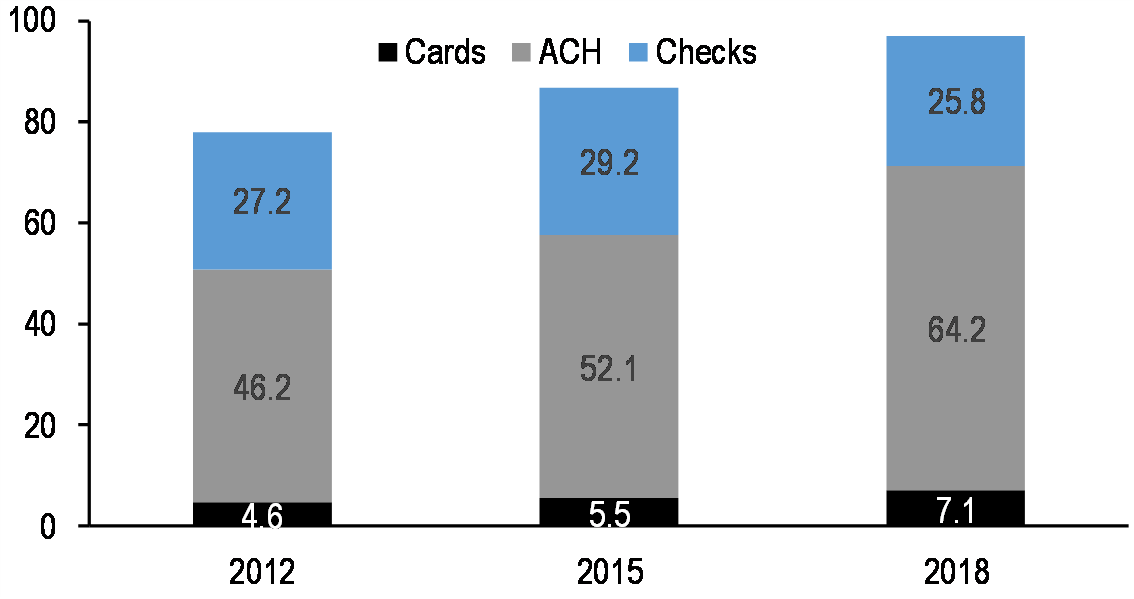
Source: The 2019 Federal Reserve Payments Study, J.P. Morgan
Not only have noncash transactions increased, but their growth is also accelerating. The number of noncash payments increased by 6.7% per year over 2015-18 versus 5.1% over 2012-15, while the value of noncash payments rose by 3.8% over 2015-18, versus 3.6% over 2012-15. Card transactions have been growing fastest: over 2015-18, the number and value of card payments increased by 8.9% and 8.6%, respectively, versus growth of 6.8% and 5.9% over 2012-15.
One last trend to note is the distribution between in-person and remote card payments. Although the majority of card transactions occur in person (72% versus 28% for remote transactions in 2018), the value of in-person and remote transactions were virtually identical in 2018: $3.30trn for in-person payments versus $3.29trn for remote payments.
Kimberly Harano AC
kimberly.l.harano@jpmorgan.com
J.P. Morgan Securities LLC
The Chinese case study: Managing a cashless economy at scale
- Modernization of payments is a global theme, and a key driver of stablecoin projects like Libra.
- To complement prior work in this area, we appeal to the Chinese experience with digital payments as a case study in financial disruption and consumer preferences.
- We review the major third-party payments platforms in China, including business models, market structure, regulatory developments and importantly their interconnections to financial markets.
- Money market funds and bank wealth management products form key components of the Chinese financial system.
- The integration of these funds into online ecosystems (e.g., YU’E Bao and Alipay/Alibaba) helped drive explosive growth in AUM…
- …but this has since slowed, even as the money supply in China has continued expanding, likely reflecting much less attractive yield pick-up versus traditional bank deposits.
- This interaction led to rapid technological and structural change, which in this case drove a similarly fast build-up of new risks to financial stability; timely regulatory intervention was key to managing this transition.
- Though the convenience and features offered by integration into e-commerce networks was certainly a significant factor, the degree of sensitivity of Chinese MMF AUM to yield pick-up suggests economics was a comparable if not more important consideration compared to the network externalities of participating.
- The example of China suggests that the transition to a mostly cashless economy can be managed at scale.
Lessons from the Chinese experience
In a recent publication, we considered the practical implications, and risk posed, by the potential rise of stablecoin-based ecosystems (see The market implications of Libra and other stablecoins, J. Younger et al., 5 Sept. 2019), as well as the hurdles to them achieving global scale (see Can stablecoins achieve global scale?, J. Younger et al., 3 Dec. 2019). For that work, we took a more first-principles approach, applying the lessons of more traditional fiat currency payment systems to alternative venues like Libra and its cousins. In doing so we highlighted two key risks posed by current design choices: the potential for gridlock in the absence of intraday liquidity via either overdraft or netting on the one hand, and the inherent instability of negative yielding collateral on the other. At this point, Facebook appears to be considering some modest design changes in the wake of several high profile presumptive Libra Association members bowing out. However, news reports suggest no moves to address the concerns raised above.
A complementary approach to evaluating the market and financial stability implications of stablecoins is to appeal to case studies. Given that these projects, including Libra, remain at a very early stage of development, good examples are unsurprisingly difficult to come by. That said, the recent Chinese experience is, in our view, one worth considering for several reasons.
First, this region in particular is likely to be critical to the success of any new global or cross-border payments system. Asia has already been the engine of growth in global payments over the past few years. In fact, China now makes up nearly a quarter of retail payments activity globally, up from only 11% as recently as 2012 (Figure 1). This growth has mostly come at the expense of larger developed economies, especially the US and Euro Zone for which market share has fallen. Along similar lines, projections from the McKinsey Global Payments Report for 2019 suggest this should remain the case going forward21.
Figure 1: Asia has driven most of the growth in retail payments globally over the past few years …
Gross annual retail payment volume; $trn

* Includes the remaining six of the top 10 payments systems by value transferred: the U.K., Brazil, Mexico, Korea, India, and Canada.Note: Payments data from the most recent BIS Red Book.Source: J.P. Morgan, BIS
Figure 2: … which likely reflects increasing levels of financial inclusion via third party payments venues, especially the explosive growth in mobile wallets
Annual volume in mobile and internet-based third party payments in China, annual growth rates for mobile, internet, and total are indicated; RMBbn
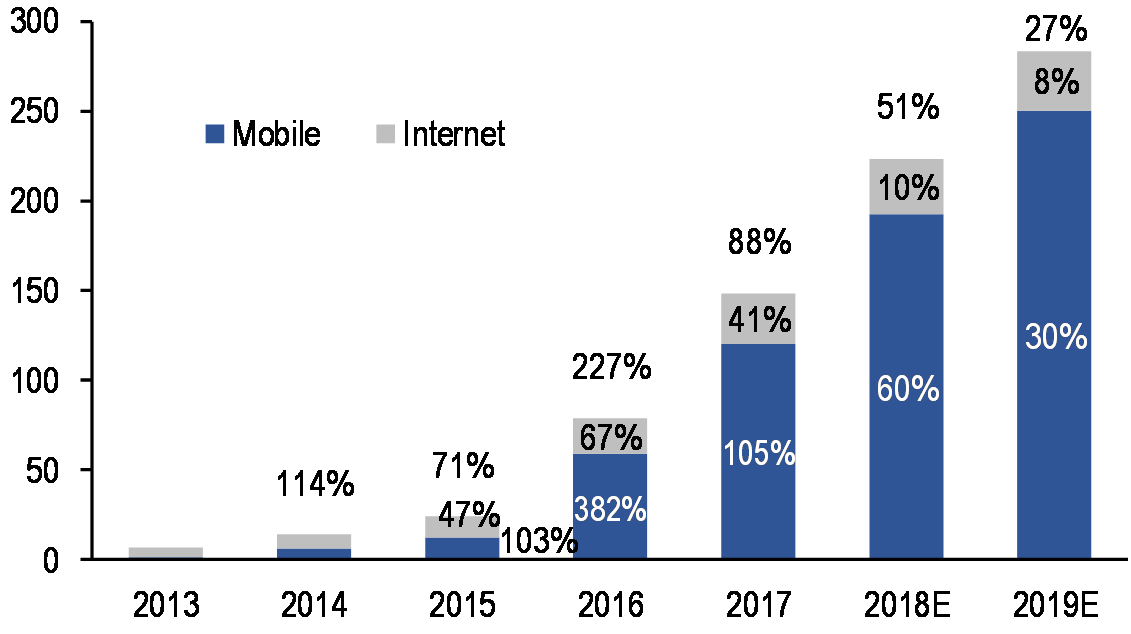
Source: J.P. Morgan, PBoC
This has been driven in large part by the expansion of e-commerce, which in China we estimate exceeded RMB10trn in 2019. That would represent a more than 400% increase over the past four years—more than twice the pace of increase in overall retail sales over the same period. In large part this likely reflects broader financial inclusion via online and mobile payments—for example, a survey conducted by the World Bank22 found that roughly 67% of adults in China made or received digital payments in 2017, up from 45% three years earlier—account ownership at a financial institution, on the other hand, barely budged over the same period. Consistent with this, third-party payments have experienced explosive growth over the past few years, the vast majority of which comes from mobile wallets (Figure 2). In this sense, the Chinese payments system has already moved significantly towards digital payments, and thus in principle the leap to a token-based stablecoin system would be much less disruptive.
Second, China appears to have more growth potential, particularly in the B2C and P2P e-commerce transactions that would likely be first adopters of stablecoins. Based on official figures, current activity totaled nearly $2trn in 2018, making it the fourth largest market by this measure. Though impressive, this represents a somewhat smaller fraction of GDP and overall retail payments than other large economies, which implies ample room for further expansion (Table 1). Additionally with a higher overall fraction of these payments tied to B2C transactions, this growth is likely more representative of what the Libra Association has highlighted as the intended uses of Libra, and by extension other stablecoins.
Table 1: Though China is not the largest e-commerce market yet, but it has substantial room to grow relative to GDP and overall retail payments, with more B2C activity than most developed countries
2018 e-commerce statistics by country; $bn unless otherwise specified
| Economy | Total | % of GDP | % of retail payments | B2C Share | B2C Value | ||||
| United States | $9,430 | 46% | 14% | 8% | $800 | ||||
| Euro zone | $5,922 | 35% | 36% | 29% | $1,727 | ||||
| Germany | $1,640 | 41% | 44% | 6% | $96 | ||||
| Italy | $352 | 17% | 19% | 7% | $24 | ||||
| France | $778 | 28% | 12% | 13% | $98 | ||||
| Japan | $2,975 | 61% | 11% | 5% | $147 | ||||
| China | $1,989 | 18% | 4% | 31% | $617 | ||||
| Korea | $1,360 | 84% | 7% | 5% | $73 | ||||
| United Kingdom | $820 | 29% | 9% | 27% | $224 | ||||
| Canada | $539 | 31% | 12% | 12% | $63 | ||||
| India | $404 | 15% | 23% | 8% | $31 | ||||
Source: J.P. Morgan, various official data sources, UNCTAD
Finally, the connection between non-bank payments in China and domestic money markets offers a valuable laboratory for tracking flows in and out of those ecosystems. In particular, the two largest providers of these services—Alipay and WeChat Pay—recently began offering financial products as a way to earn income on funds kept within their network. These primarily consist of sweeps into money market funds (MMFs) that then invest in short-term onshore securities and bank deposits. They are not, however, required to participate in either system. In this sense, users of Alipay and WeChat Pay can use their servicers in one of two ways: pure payment rails that simply connect more traditional bank accounts, or as an expansive ecosystem in which their transactional cash and even savings are kept within those proprietary networks. Both were likely at play to some extent in the dramatic growth of MMF assets in China, which outpaced broad money supply by nearly 60%, and their subsequent decline—in sharp contrast to other major economies (Figure 3).
Figure 3: The linkage between money markets and payment ecosystems like Alipay initially drove a surge of investment into MMFs, but more recently these flows have reversed
MMF assets versus M2 for the US, Eurozone, and China; unitless and set to 100 as of 1Q 2016
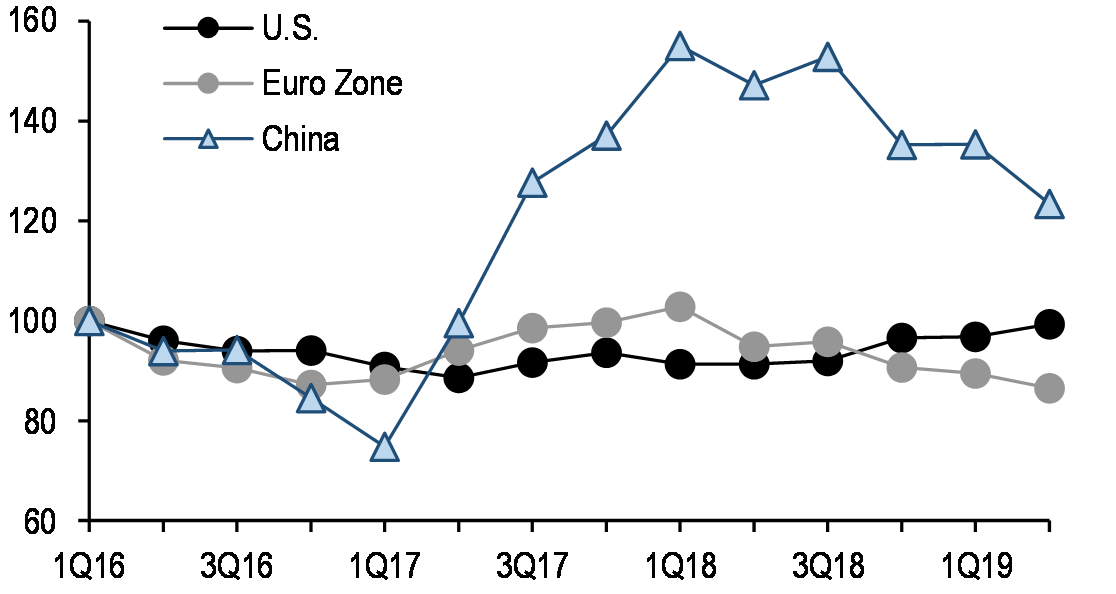
Source: J.P. Morgan, IIF, Haver Analytics, various official sources
Are they doing this for economic reasons, for example higher rates of return than traditional short-term investments? Or for the network externalities associated with participation in those systems? And are there any negative financial stability implications of such a rapid and large-scale reallocation of savings? Granted third-party payments in China are quite different from stablecoins, especially on the technology front. But they share the arguably more important feature of being a payments and e-commerce network that is both integrated into social media platforms and largely separated from the traditional banking system. In this sense, the size of Chinese money markets relative to the money supply offers a rather unique, even if imperfect, test of how consumers react to economic versus network-related incentives.
With this backdrop in mind, this chapter presents a deep dive into the Chinese alternative payments system. We consider the mechanics and evolution of these systems, as well as the economic incentives of their providers. We also consider the implications for the structure of Chinese financial markets, including wealth management products (WMPs) and money market funds (MMFs). Finally, payments-related MMFs have had a rather dramatic impact on Chinese funding markets, with potential financial stability implications, but also value as a diagnostic of the relative importance of different consumer incentives. This is interesting in of itself, as we move towards a cashless global economy. However, for all the reasons mentioned above, it should be seen as a case study with lessons for the designers of Libra and other stablecoins.
China’s third-party payment market
Market overview
The hyper-growth stage is over; industry focus shifts from customer penetration to usage frequency. According to iResearch, China’s third-party payment volume grew from RMB7trn in 2013 to RMB223trn in 2018. Such rapid industry development is mainly driven by exponential growth of mobile payments. Mobile payment volume expanded from RMB1trn in 2013 to RMB192trn in 2018, representing 86% of total third-party payment volume (Table 2).
Table 2: Mobile payment penetration has largely saturated
| Alipay | |
| Global annual active users | ~1.2bn |
| Domestic annual active users | ~900m |
| Tenpay | |
| WeChat Pay MAU | >800m |
| Mobile payment penetration % | 94.7% |
Source: Company data, IPSOS
Broadly speaking, there are three key use cases for digital payment in China:
- Consumption payments: daily consumption payments both online and offline. This component is by far the largest, comprising roughly 70% of industry revenue.
- Financial payments: non-payment financial products such as loans, wealth management products, and insurance. This represents a significant fraction of value transferred on third-party payment networks, but because Alipay, Tenpay and others don’t directly charge on payment services, revenue is generated through distribution fees.
- Other payments: money transfer including social payment (e.g., WeChat red pocket) among users. Payment companies only generate revenue when users withdraw money from their payment account to their bank account, but the associated fees are usually sized only to offset the 10bp charged by traditional banks.
According to IPSOS, China’s mobile payment systems have reached the 1bn users milestone, with the penetration rate of total smartphone users close to 95% (Table 1). We believe the industry has therefore shifted from penetration-driven growth to frequency-driven growth, suggesting the hyper-growth stage is already over: total/mobile payment volume should grow at a more modest 2-year CAGR of 27%/30% during 2018-20E.
Value chain and economics split
NetsUnion is in full operation; the near-term economic impact is likely to be insignificant. As the primary regulatory authority for the third-party payments, PBoC mandated the establishment of NetsUnion to process online payment transactions in that market. Since the second half of 2018, all mobile payment transactions are required to be cleared by this centralized clearinghouse—in contrast to the direct connections among mobile payment providers and individual banks that existed in the past (Figure 4). So far, this transition has been smooth and we do not anticipate any major operational incident, even during peak time such as Double 11.
Figure 4: Online payment model transits from direct connection model to centralized model

Source: J.P. Morgan
PBoC also indicated that the establishment of NetsUnion is for regulatory purposes and not for commercial gains, and consequently it does not charge a fee for its clearing and routing services. Further, given it will not be profit-seeking, we believe any fees imposed in the future will be small, and therefore will either not constitute a material cost increase to payment companies or can also be easily passed on to merchants/customers. Using UnionPay’s offline bank card transaction charge as an example, the rate should be no more than 6.25bps (approximately 10% of total payment service charges). Furthermore, this fee is borne equally by issuing parties and merchant acquirers.
Economics split across the value chain. As NetsUnion currently does not charge a fee, payment service fees are mainly split between issuing parties—e.g., Alipay and Tenpay—and merchant acquirers (Figure 5)—e.g., China UMS and Huifu, though in some cases Alipay and Tenpay also play the role of merchant acquirers. For these two market participants, take rates are trending lower in the last few years, mainly due to 1) industry competition and 2) small merchant penetration.
Figure 5: Key participants in the third-party payment value chain and their economics split
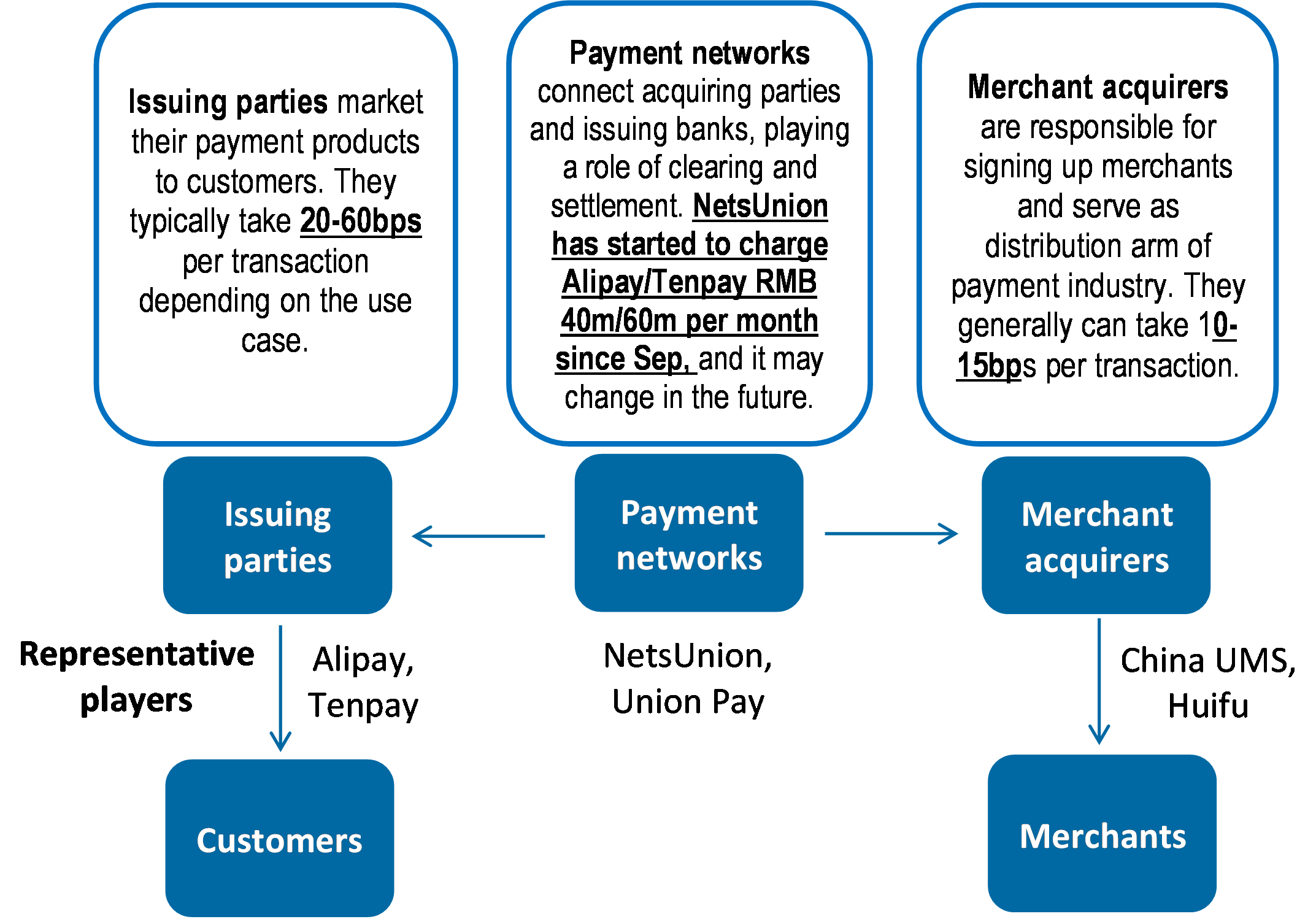
Source: J.P. Morgan
Alipay and Tenpay generally take 20-60bps of total payment value per transaction depending on the use case. For example, the take rate of offline consumption on QR code is lower than that of pure online in-app payment. Merchant acquirers can take 10-15bps per transaction, and they sometimes need to share the economics with their channel partners. We think further downside risk on take rate is limited because 1) the charge rate is already low, 2) the main phase of merchant coverage expansion is largely done, and 3) the major players have shifted their focus from pure volume growth towards more balance between growth and earnings.
Figure 6: A schematic of funding sources for third-party payment providers in China
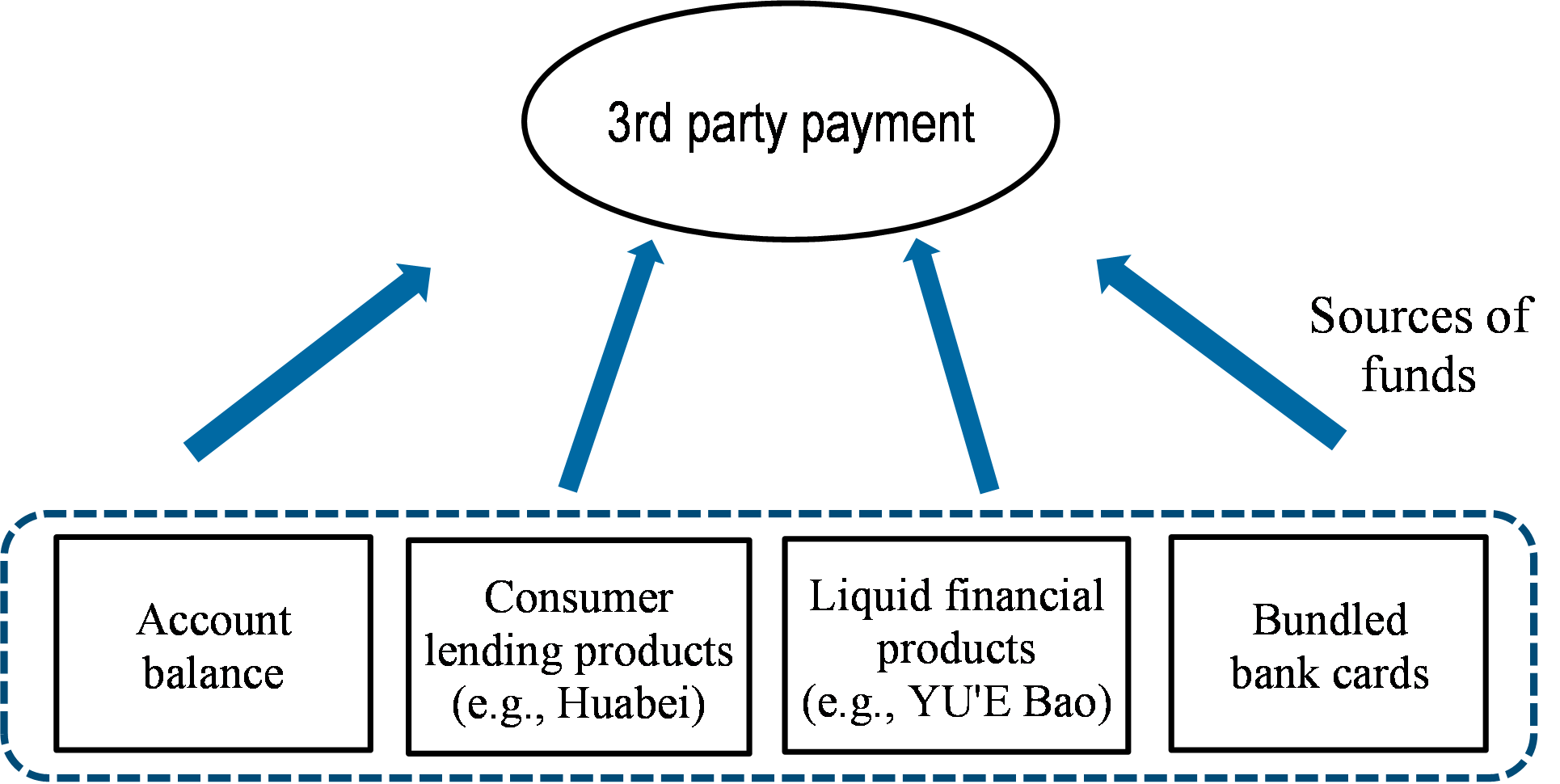
Source: J.P. Morgan
How do third-party payment providers source funding? There are four major funding sources of third-party payment transactions (Figure 6), including payment account balance, consumer lending products, money market fund products (e.g., YU’E Bao), and traditional bank accounts. When funds are sourced from a bank account, payment companies are required to pay a 10bps processing fee to the bank—otherwise there are no fees.
Competitive landscape
- Mobile payment: Mobile payments remain a duopoly structure, with Alipay and Tenpay combined representing more than 90% market share. We believe Tenpay has an advantage in the offline payment market by leveraging WeChat’s large user base and high usage frequency, while Alipay still leads in online consumption payments supported by Alibaba’s online retail marketplaces (Figure 7).
- Internet payment: The internet payment market structure is more fragmented than mobile, with the top three players taking 57% market share. The market scale is also much smaller than mobile payment, only accounting for 14% of total third-party payment volume in 2018 (Figure 8).
Figure 7: Market share of third-party mobile payment in 2018
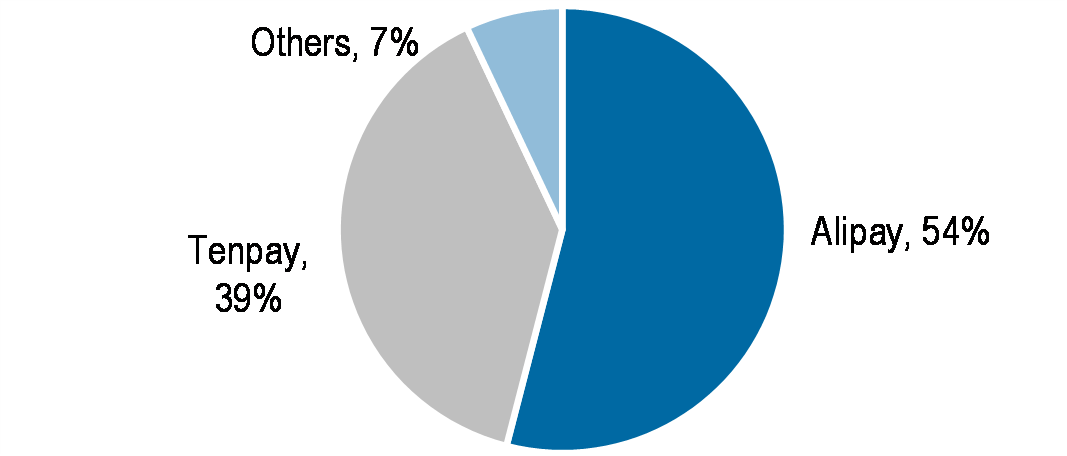
Source: Analysys, J.P. Morgan estimates
Figure 8: Market share of third-party Internet payment in 2018
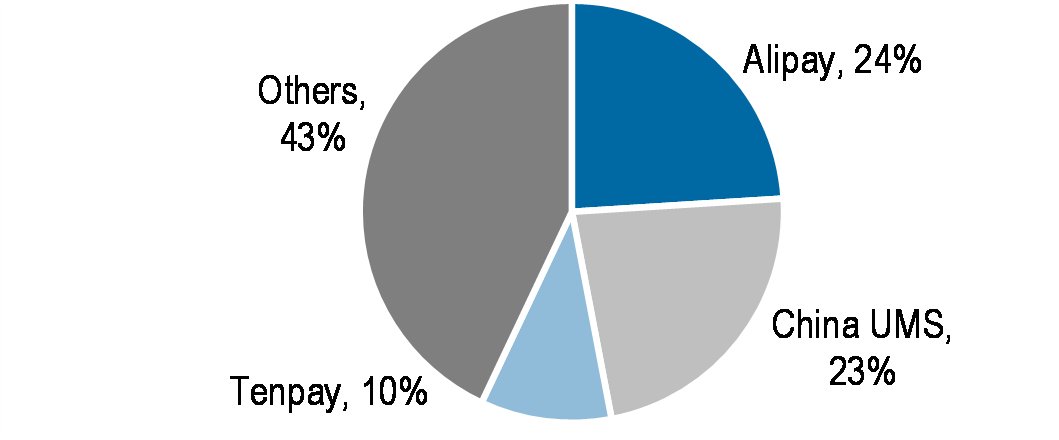
Source: Analysys, J.P. Morgan estimates
Regulatory changes reshape industry landscape
Two major regulation-driven changes have been implemented in recent years: 1) diminishing interest income from client reserve funds323and 2) establishment of NetsUnion with a centralized clearance model (versus previously payment companies directly connected to banks; see discussion above). We believe both changes are mainly for risk management purposes, and that Chinese regulators generally remain supportive of market innovation.
These new, tighter regulations have had some negative financial impacts on the industry. In particular, 1) above has effectively eliminated interest revenue from customer reserve funds. We estimate Tencent had RMB7bn client reserve fund related interest income in 2018, and this number declined to RMB200mn in 2019 (this interest revenue has reduced to 0% from mid-Jan 2019 onwards; Table 3).
In addition, although NetsUnion has indicated that it has no intention to charge a fee for clearing and routing services, it may change in the future, causing incremental operating cost for payment service providers.
Table 3: Internet income from client reserve fund diminished in Tencent's Fintech and business services segment
| (RMB mn) | 1Q18 | 2Q18 | 3Q18 | 4Q18 | 2018 | 2019E |
| Fintech & business services revenue | 15,182 | 16,666 | 19,343 | 21,600 | 72,791 | 101,981 |
| Interest income | 2,500 | 2,050 | 1,520 | 859 | 6,929 | 200 |
| as % of segment revenue | 16% | 12% | 8% | 4% | 10% | 0% |
Source: J.P. Morgan estimates, Company data
Figure 9: YU’E Bao adopts a hybrid 1P and 3P model

Source: J.P. Morgan, Company data
Connections between digital payments and money markets
The rise of YU’E Bao
YU’E Bao was launched by Tianhong Asset Management (51% owned by Ant Financial) in June 2013. Since then, it has quickly gained strong traction and become one of the largest money market funds (MMFs) in the world. As of mid-2019, YU’E Bao AUM reached RMB1,034bn, or 14% of China’s total MMF AUM.
YU’E Bao has expanded from one single MMF operated by Tianhong Asset Management to a marketplace that is made of Tianhong and more than 30 third-party MMF managers.
The decline in AUM since 1H18 is mostly attributable to Ant Financial’s decision to shift the YU’E Bao business model (in May 2018) from a pure principal model (1P) to a hybrid 1P and marketplace (3P) model by introducing third-party MMFs. Its overall (1P+3P) AUM remains largely stable (Figure 9).
According to The Paper (澎湃新闻), YU’E Bao introduced 13 third-party funds by the end of that year, with a combined incremental AUM of over RMB600bn. Adding this amount to YU’E Bao’s 1P AUM at the end of 2018, this platform actually expanded by approximately 10% YoY in 2018. This past Investor Day, Ant Financial management indicated total AUM (1P+3P) had reached RMB2 trillion. Given that the Chinese MMF complex experienced some outflows in aggregate (contracting by 4% in 1H19 versus 2H18; Figure 10), this product appears to be gaining some traction despite the industry-wide slowdown. Though a noticeably slower pace of growth compared to prior years, this is nonetheless a much different story than simply tracking the assets of the main fund.
Figure 10: YU’E Bao assets grew explosively in 2016-17 and have continued growing when one includes MMF investments with third parties facilitated by the Ant Financial marketplace
YU’E Bao AUM and that held by third parties on the Ant Financial marketplace (LHS; RMB bn) and as a fraction of the overall Chinese MMF industry (RHS; %)
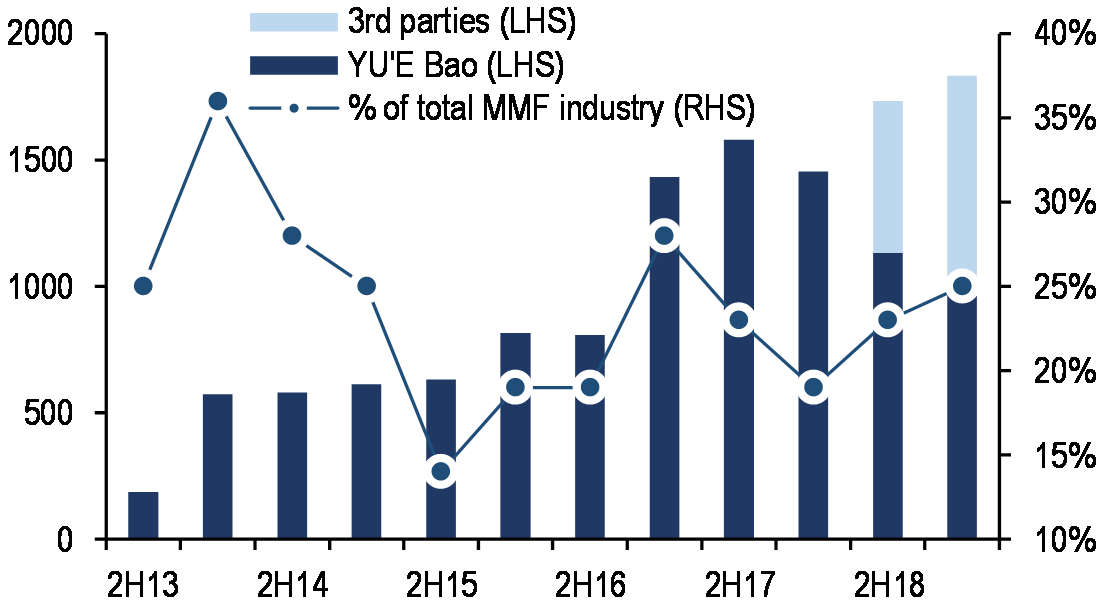
Source: Company data, AMAC, J.P. Morgan estimates
Figure 11: The rise of digital MMFs noticeably has led to outflows of personal deposits into money markets, as evidenced by their growing share of cash management products
Personal deposits and MMF AUM in China (LHS; RMB bn) and MMFs AUM as a fraction of personal deposits (RHS; %)
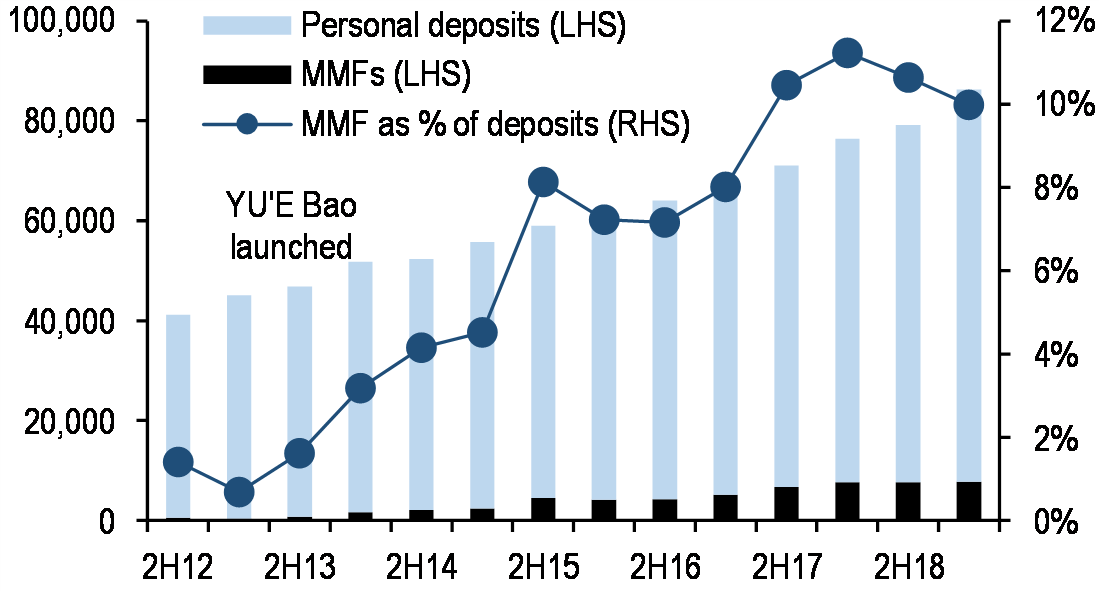
Source: J.P. Morgan, PBOC, AMAC
Following YU’E Bao, Tencent launched wealth management platform LiCaiTong in Wechat Pay in Jan 2014. In contrast to YU’E Bao, LiCaiTong has adopted a complete marketplace model since inception: in addition to the MMF, LiCaiTong sells a wide range of wealth management products from third party financial institutions including banks, security companies, and asset management firms. As of 2Q19, total AUM on the LiCaiTong platform surpassed RMB800bn, of which we believe a significant fraction is invested in the MMF.
This explosive growth in digital wallet-linked MMFs has driven a material reallocation from traditional bank deposits to money markets. Before YU’E Bao was launched in Jun 2013, MMFs represented only 1% of personal deposit balances in China; by 2018, bank account balances had doubled but MMF AUM expanded by more than 12x, pushing that ratio to more than 10% (Figure 11). Since then, however, this ratio has declined somewhat, an interesting development we discuss later in this publication.
Digital wallets such as Alipay and Wechat Pay do not charge for payment services related to MMF subscriptions. Rather, they charge fund distribution, custody, and asset management fees. Under the 1P model, Ant Financial retains distribution and asset management fees, while custody fees are paid to custodian banks; under the 3P model, the digital wallet only keeps the distribution fee. Taking YU’E Bao as an example:
- Asset management fee, equal to fund NAV on the day before (net asset value)*0.3%/total calendar days of the year.
- Custody fee, equal to fund NAV on the day before (net asset value)*0.08%/total calendar days of the year.
- Distribution fee, equal to fund NAV on the day before (net asset value)*0.25%/total calendar days of the year.
Figure 12: The growth of YU’E Bao has generated sizeable asset management and distribution fees for Tianhong…
Asset management and distribution fees for YU’E Bao; RMB mn
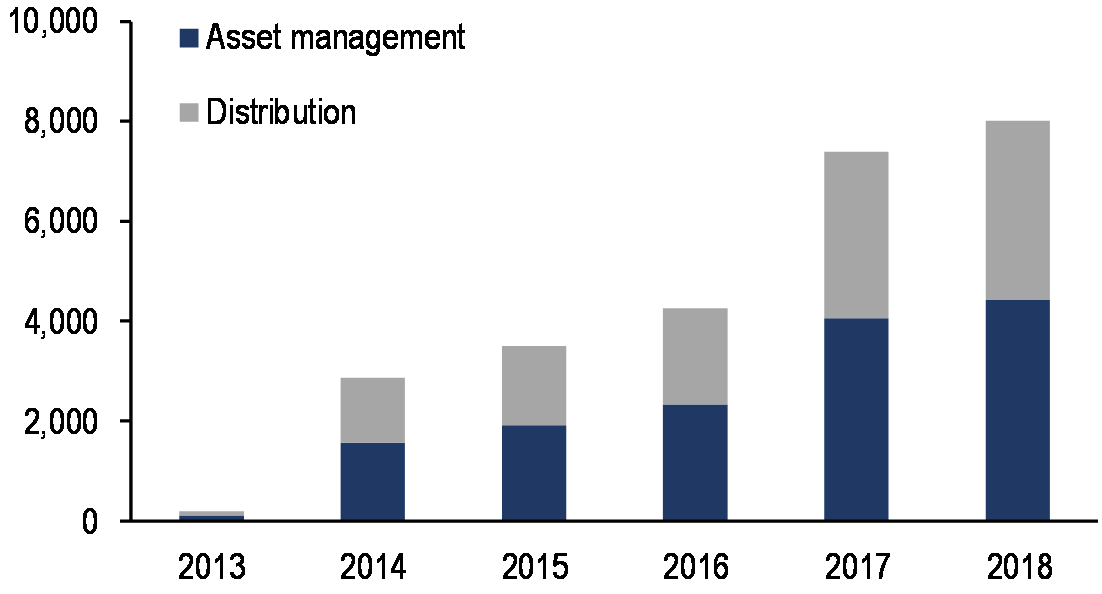
Source: Company data
Figure 13: …and the move to a third-party business model significantly reduced the revenue growth, though net profit margins remained constant
Revenue (annualized growth indicated above) and net profit (net profit margin indicated above) for Tianhong; RMB mn
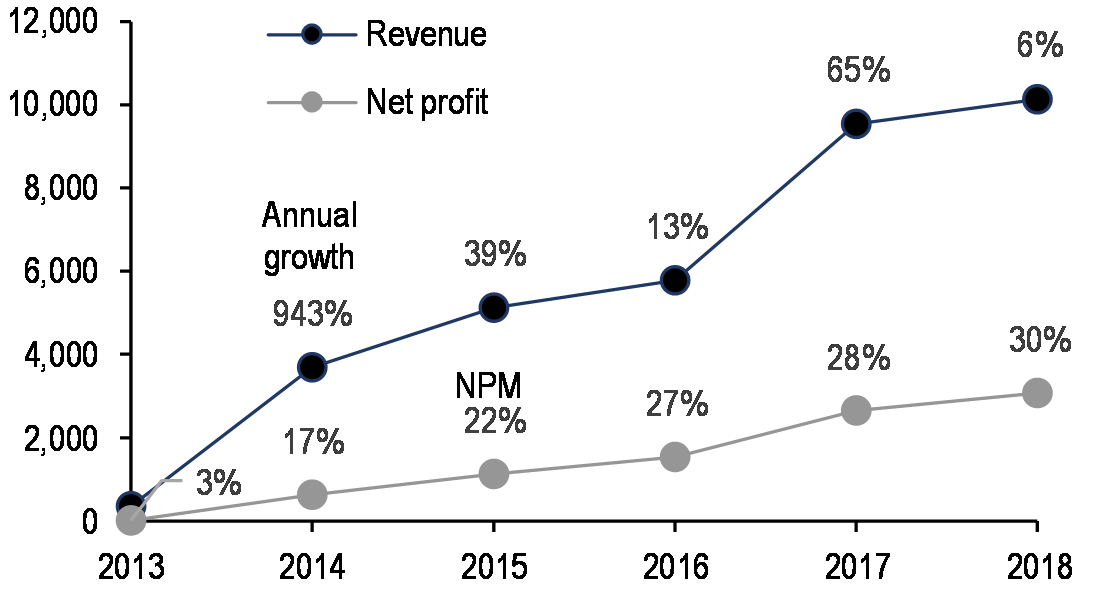
Source: J.P. Morgan, company data
With exponential growth of AUM, YU’E Bao’s revenue (asset management fee + distribution fee) expanded by more than 40x from RMB190mn in 2013 to RMB8bn in 2018. Riding on the rapid growth of YU’E Bao, Tianhong (51% owned by Ant Financial) saw its revenues grow by 28x from 2013 to 2018, during which the YU’E Bao contribution went from 54% to 79% (Figures 12 and 13).
We believe there are three possible explanations for the dramatic growth of YU’E Bao and other similar funds:
- Strong traffic support from Alipay: Alipay already had more than 300mn active users when the fund was launched in 2013. Because YU’E Bao is embedded in Alipay, it can fully leverage that traffic and visibility to quickly drive user adoption. By the end of 2018, Yue Bao had more than 600mn investors, suggesting a close to 70% penetration rate compared to all domestic Alipay users.
- Better payment account balance management: Alipay launched this cash management product to address large amounts of dormant cash in users’ accounts, which does not generate any economic value to users. The higher rate of interest offered by MMFs, specifically YU’E Bao, was a significant selling point of the product.
- Integrated investment and consumption: YU’E Bao provides a smooth user experience for both fund subscription and redemption. It also offers improved liquidity in the form of T+0 redemption, rather than T+1 settlement offered by traditional financial institutions. In addition, YU’E Bao is uniquely integrated into everyday payments.
Bank Wealth Management Products
MMFs and bank WMPs are the most popular quasi-cash investments in China at RMB7.3trn and RMB22.2trn, respectively, in 1H19. Two factors primarily explain the rapid growth of these products (Figure 14):
- Limited options for wealth preservation in China: equity markets have been sluggish (Shanghai Stock Exchange Composite Index, -9% in the past decade), access to offshore investment opportunities is limited due to capital controls, and authorities have moved to curb money inflow into real estate via property purchase restrictions.
- Segmented money markets: the two-track interest rate system has led to a wide spread between institutional money market rates (i.e., interbank and bond yields) and household deposits (Figure 15).
Figure 14: Both Off-BS WMP and MMFs in China have experienced rapid growth over the past few years
Off-balance sheet WMP (LHS) and MMF AUM balance by quarter; both axes in RMB trn
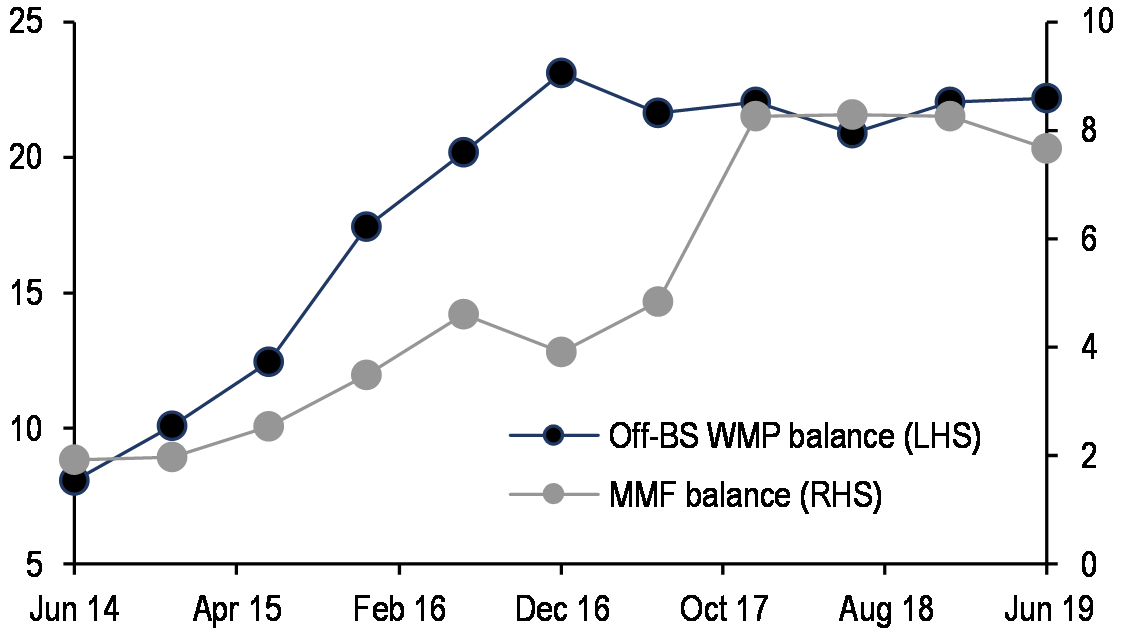
Source: 2019 Private banking reports published by CCB and BCG
Figure 15: Blended deposit costs for large and JSB banks under J.P. Morgan coverage are consistently lower than interbank funding rates (e.g., SHIBOR) owing to the two-track interest rate system in China
Indicative interest rates for Chinese bank funding markets; %
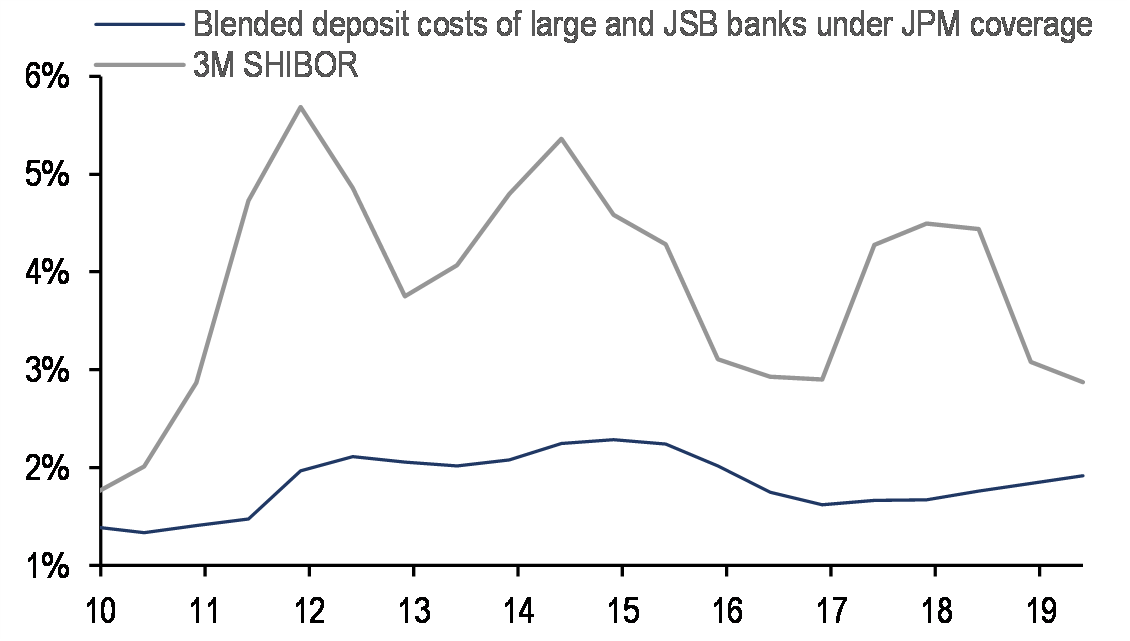
Source: Company reports, WIND
According to ChinaFund, 81% of mutual funds are distributed through online channels. There is no system-wide data on WMP distribution, but if we take China Merchant Bank (which is the largest private bank in China), as an example, 70% of WMPs are distributed through mobile channels. This shows a high acceptance among China’s netizens to purchase investment products online. For example, data suggests that 170mn Chinese (20% of the total) have purchased wealth management products online, a sharp increase from 63mn (or 10% of the total) as of five years ago (Figure 16).
Figure 16: Online users of wealth management products have been growing rapidly, and faster than all Chinese netizens
Number of online wealth management services in China at semi-annual frequency, % of all netizens indicated as well; millions
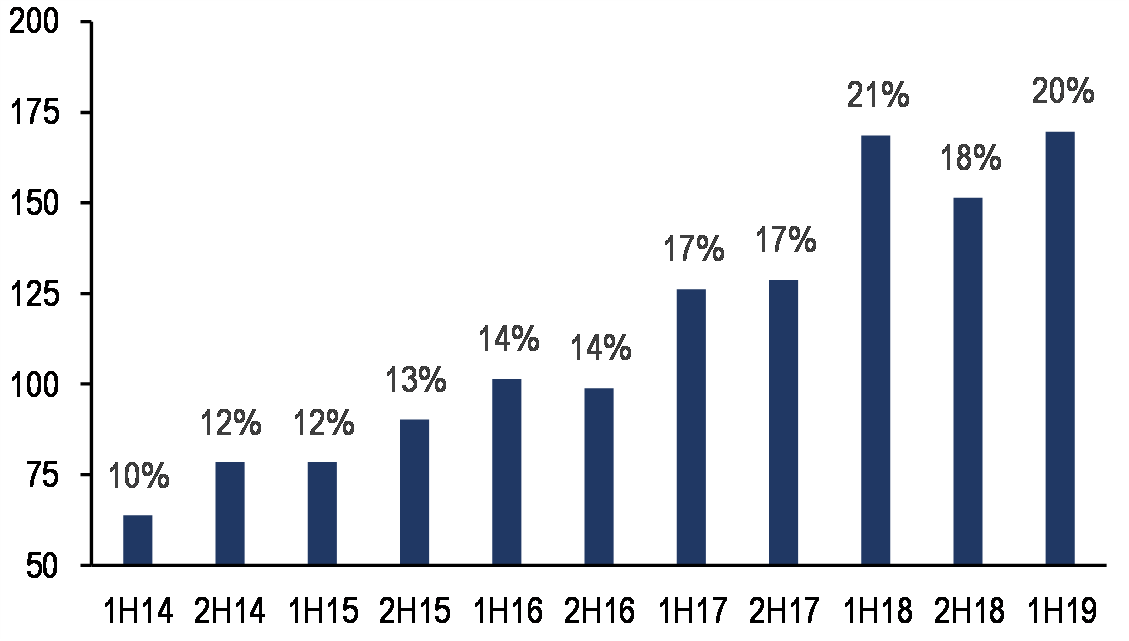
Source: NBS, CEIC
Currently, mobile banking platforms are the largest distribution channel for online sales of WMPs. But this is going to change with the launch of banks’ asset management subsidiaries. Going forward, third-party wealth distributors, such as Alipay or Tenpay platforms will be also able to offer WMPs issued by these managers. If these internet platforms are able to integrate their payment function with banks’ asset management capacity, we expect a rise in digital distribution.
Understanding the underlying investments and risks
Figures 17 and 18 show the underlying assets of MMF and WMP, respectively. Note that these two products are not mutually exclusive as RMB 2.4trn of WMPs (or 11% of AUM) are allocated into MMF. However, in aggregate key differences emerge. First, about 17% of WMP portfolios are alternative investments products (non-standardized assets) as yield enhancers. Also, MMF AUM mainly consist of cash and equivalents—e.g., deposits, interbank products and banks negotiated certificates of deposit (NCDs)—while WMP portfolios hold a higher proportion of bonds and have a somewhat longer portfolio WAM (~6 months). WMPs are consequently somewhat higher yielding than MMFs, though this difference has fluctuated over time (Figure 19).
Figure 17: MMF asset composition in 1H19
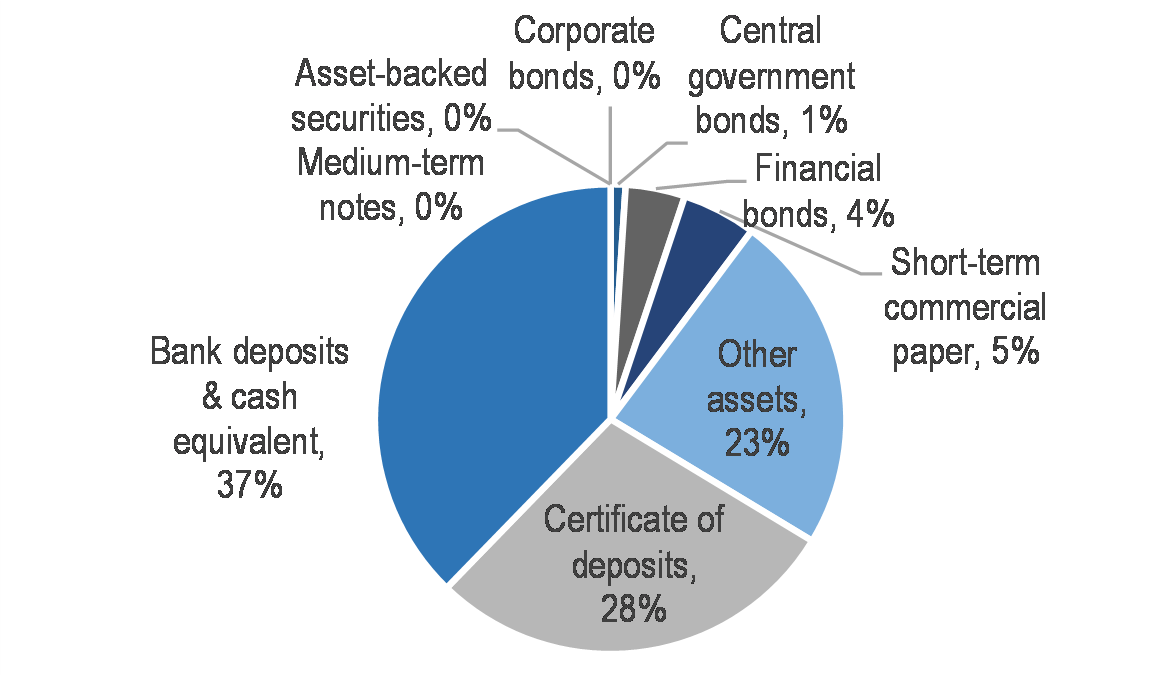
Source: WIND, fund reports, AMAC, J.P. Morgan
Figure 18: Off-balance sheet WMP asset composition in 1H19

Source: ChinaWealth, J.P. Morgan
Figure 19: WMP products tend to run longer duration portfolios and focus more on yield enhancement, leading to higher returns than typical MMFs
Average MMF and WMP yield; %
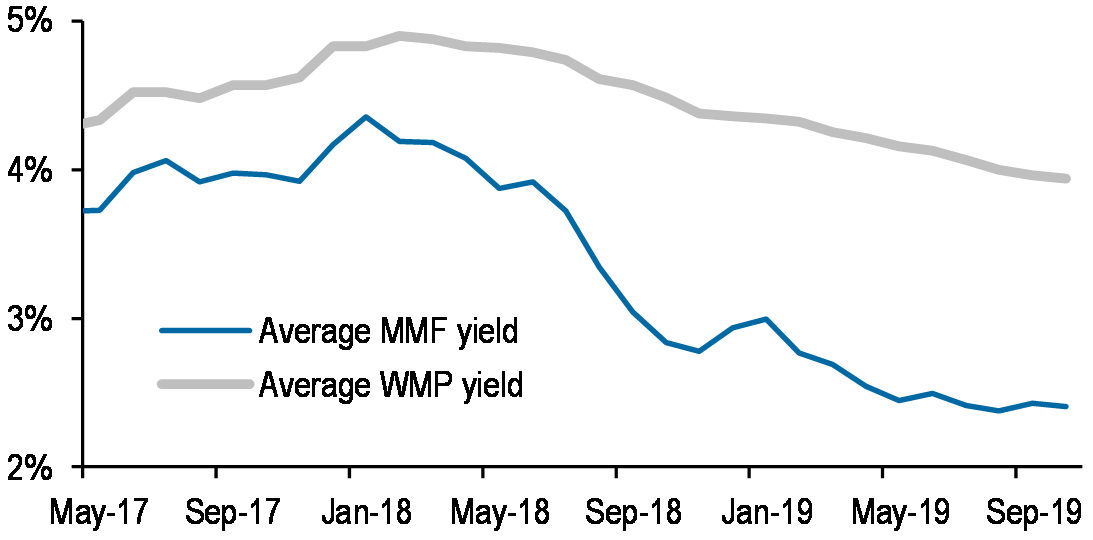
Source: WIND, J.P. Morgan
Regulatory moves to transform banks’ WMP into MMF
The rapid growth and evolution of the WMP industry has led to a material shift in industry landscape. Though we refer the reader to two previous publications for details (e.g., China Financials – Thoughts on regulatory impact on money market fund development outlook, K. Lei et al., 5 June 2018 and China Banks – WMP regulation is more lenient than the AM rule, temporary relief for credit supply, K. Lei et al., 22 July 2018).
- Banks transforming WMPs into MMF under the new regulation: Under new regulations, banks are required to reinforce WMP portfolios with their own Treasury operations. Major banks have applied to set up asset management subsidiaries in order to run their WMP book similar to MMF managers. This aims to stop banks from providing a guarantee, implicitly or explicitly, on the principal or return of the WMPs they issued. Also, through reducing the NSCA in banks’ WMP portfolio, yields should converge with those of MMFs. Both measures push banks to shift their WMP portfolios to products similar to MMFs, in our view.
- Setting daily redemption cap on MMF reduces its competiveness: Earlier in their evolution, MMFs could use bank credit facilities as bridge loans to manage the liquidity risk introduced by offering same-day liquidity. In light of the much larger financial footprint of these funds, however, regulators capped daily redemptions at RMB10k to reduce stability risks. Though those limits have subsequently been removed, WMPs are not subject to the same potential restrictions.
The impact of alternative payments on Chinese money markets
Money Market Funds (MMFs) are the most popular fund type in China: As of August 2019, the NAV of all money market funds is RMB7.4trn (up from RMB300bn in early 2012), which represents 54% of total size of the fund industry (Figure 20). The rapid development of MMFs started in 2013, when the Tianhong-managed YU’E Bao fund entered the investment landscape of hundreds of millions of Alipay users.
YU’E Bao’s 1P Tianhong-managed money market fund had an AUM of 1.055trn as of September 2019 and is one of the largest MMFs in the world, and alone accounts for roughly 14% of Chinese MMFs. As discussed earlier in this publication, the success of the fund is attributed to it being China’s first-ever Internet fund specially designed for Alipay. YU’E Bao’s set up is distinctive from most other funds in the sense that it has virtually no barriers of entry (minimum subscription: 1 RMB; easy subscriptions through mobile phones); no handing fees; and high liquidity (account balance can be instantly converted to banks, or used in Alipay payments or general bill payments, subject to a cap). Over the years, other financial institutions have also launched their MMFs, some of them can also be purchased from the revamped YU’E Bao platform, which has moved into a 3P model.
Figure 20: MMFs make up the largest onshore fund type in China, with more than RMB7trn, or more than half the total
NAV of funds in China by fund type in RMBbn
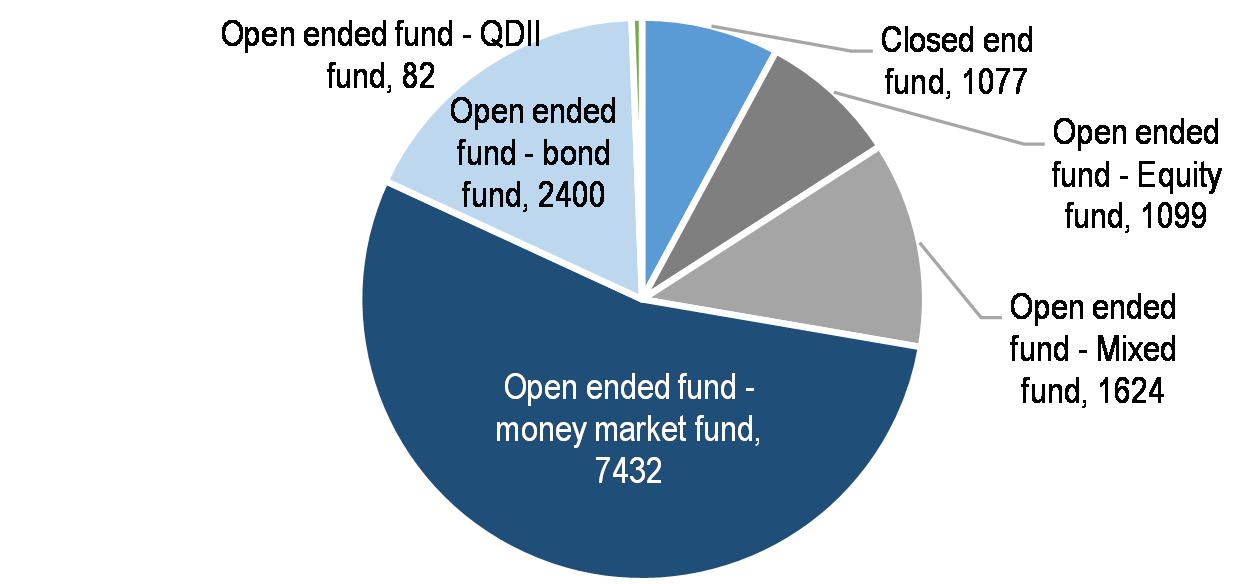
Source: Asset Management Association of China
YU’E Bao Tianhong-managed MMF holdings include a variety of money market instruments (Figure 21): While the “benchmark” of the fund is the 7-day call deposit rate, its asset allocation mix appears to favor modest yield enhancements. For example, the majority of its assets are bank deposits (60.3% of AUM), followed by financial assets held under repo agreements and fixed income securities (predominately being NCDs and commercial paper). The weighted average maturity of YU’E Bao’s assets is 57 days, and 40% of the assets the fund holds have a remaining maturity of above 60 days. To provide extra protection to customers, the fund’s assets are fully covered by Zhongan Insurance.
Figure 21: YU’E Bao holds mostly bank deposits and CDs, though it does some repo as well
YU’E Bao holdings by type as of Q3-end 2019
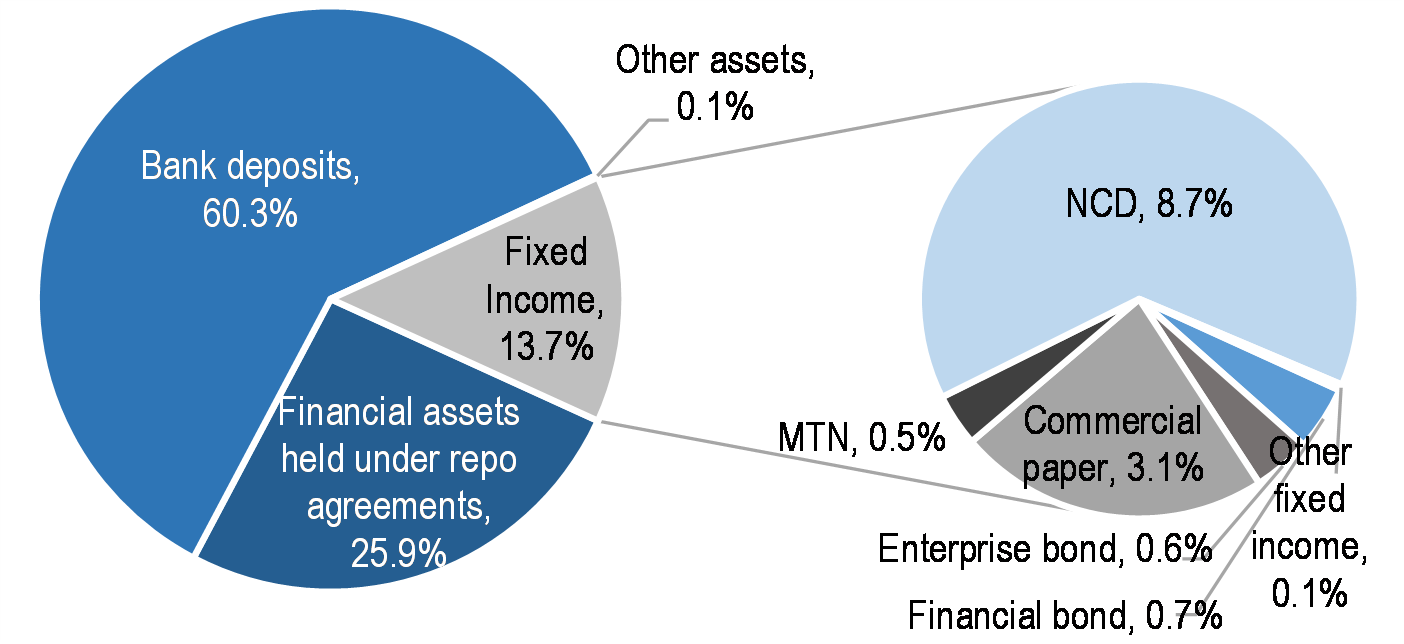
Source: J.P. Morgan, Fund Quarterly Disclosure
A significant aspect of YU’E Bao’s appeal is to allow retail investor participation in money markets. Given China’s dual-track interest rate system (i.e., lack of transmission between banks deposit/lending rates versus interest rates in the money market/bond markets), this was not previously possible. For example, given its size, YU’E Bao is also able to negotiate higher yields for interbank products like bank deposits and NCDs, allowing retail investors to “invest” in interbank market rates, which were traditionally out of reach for these investors.
Figure 22: Chinese MMF yields tend to track SHIBOR, and at times have offered much higher yields than bank deposits …
3-month SHIBOR, YU’E Bao 7-day annualized yield, 1-year benchmark household savings deposit rates%
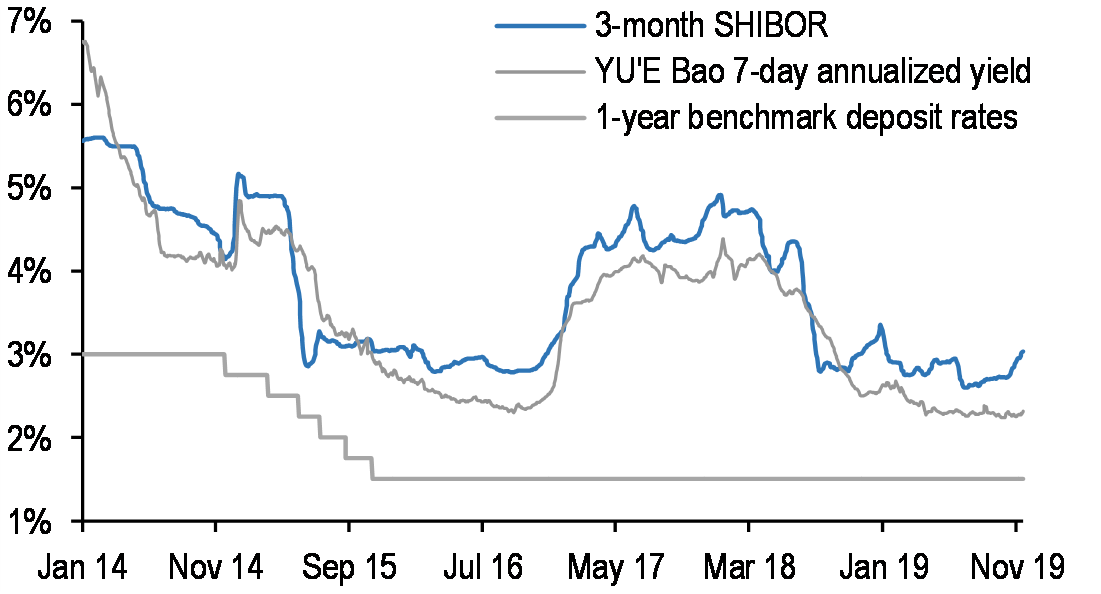
Source: J.P. Morgan, Bloomberg
This proved particularly attractive in late-2016 and 2017, when the PBoC tightened liquidity conditions to address a cyclical turn-up in growth by withdrawing monetary stimulus. One result was higher interbank rates, which increased YU’E Bao’s investment yield relative to benchmark deposits while lending rates were unchanged (Figure 22). This large yield pickup led to substantial inflows from bank deposits, leading YU’E Bao assets to more than double by 4Q 2017, peaking at nearly RMB1.7trn (~240bn US$ at the time). This growth was substantially faster than the overall MMF complex in China, likely owing in part to much easier access via Alipay. At its peak, this one fund represented more than 28% of all MMF assets in China (Figure 23). With Ant Financial shifting the business model of YU’E Bao into a marketplace model from 1H18, customers could choose from a selection of MMFs instead of just buying the Tianhong-managed fund. There is tight competition among money market funds as they offer very similar 7-day annualized yields and Tianhong MMF’s market share inevitably fell.
Figure 23: … but as that spread has compressed, inflows into MMFs have slowed and YU’E Bao in particular has shrunk quite a bit
YU’E Bao direct AUM and that facilitated but placed with third parties (LHS) and total Chinese MMF AUM (RHS); both axes in RMB trn
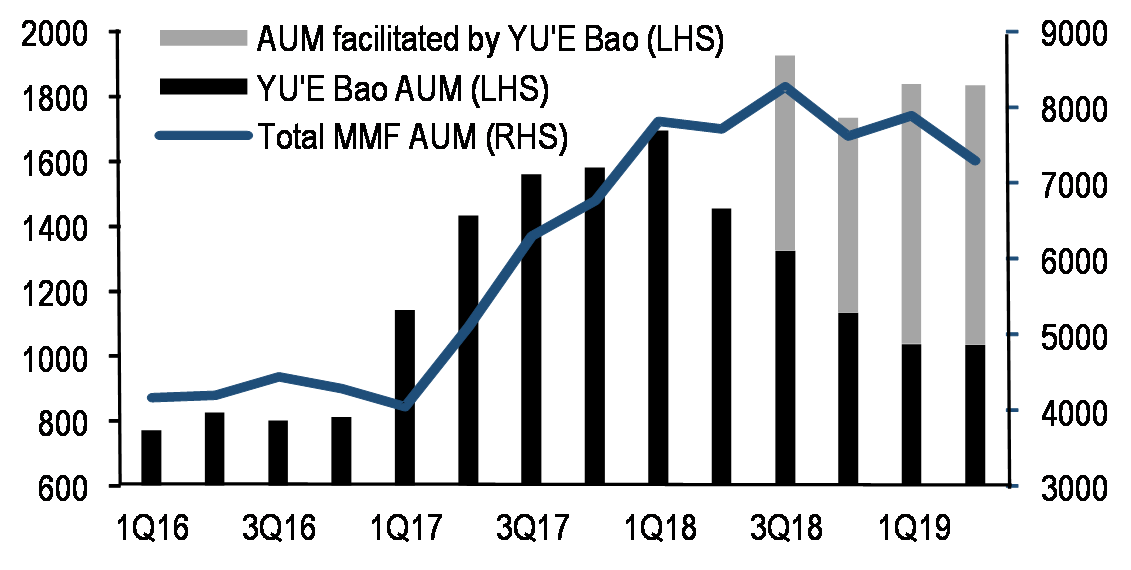
Note: 3Q 2019 data only available for YU’E Bao AUM and therefore is excluded.Source: J.P. Morgan, Bloomberg, IIF
These developments have attracted the attention of regulators, who have grown concerned about possible financial stability risk introduced by the rapid growth of the MMF industry. They have specifically highlighted:
- Redemption risks during periods of rising interbank rates: in November 2016, 1-month NCD rates rose by over 200bp and the China bond index fell by 2%, leading the NAV of money market funds to fall by 13% from mid-November to mid-December.
- Concentration risks of institutional investors: it stands to reason that MMFs can better predict potential redemptions when their investor base is predominately small, retail investors. However, as of late-2017 roughly 45% of end-users were financial institutions such as banks and insurance companies—in part due to targeted marketing to large institutional investors on the part of some funds to grow their assets. This raised the risk of unexpected and large redemptions that could impair liquidity.
- Cross market transmission risks: MMFs are major participants in various parts of the money market and bond market. During periods of large redemptions—e.g., in December 2016—MMFs had to meet redemptions of up to RMB50bn/day. This was meaningful size relative to the NCD and bond markets, which saw ~RMB1trn and 5trn in average daily volume, respectively. On several trading days, MMF selling of NCDs led to spikes in NCD yields, impaired price discovery, and various instruments eventually sold at a discount.
- Timing mismatches between assets and liabilities: Some internet-based MMFs adopted T+0 redemption mechanisms to compete with savings deposits, but the funds themselves are not subject to equity requirements or reserve requirements. These funds also deposited the aggregate funds in banks with T+1 settlement, which could potentially amplify withdrawal risk due to timing mismatches.
To address these concerns, in July 2018 the CSRC and PBoC imposed regulations over the distribution of internet-based MMFs, including individual limits over their holdings of YU’E Bao funds as well as daily subscription amounts—though these were removed in April 2019. They also implemented T+0 withdrawal maximums (10k RMB/day) to reduce the perception of “infinite liquidity” provided by the MMFs. Over time, measures including caps on MMFs holdings’ residual maturity, minimum amount of liquid asset holdings, and limits to MMF’s credit bond investments will be strengthened. There will also be additional oversight on systematically important MMFs including possible inclusion of the country’s largest MMF’s into PBoC’s Macro Prudential Assessment Framework. Thanks to the increased competition between different MMFs in the YU’E Bao platform, idiosyncratic risks brought by a rapid buildup of AUM into a single fund was reduced and therefore a maximum holding cap of the Tianhong managed MMF per customer was removed in 2019.
Also, to reduce and monitor financial stability risks, in late-2018 the Chinese mutual fund industry was recently subjected to liquidity stress tests designed by the PBoC. A total of 4851 funds were included, which required calculating risk-weighted assets for comparison to potential withdrawals under stress (10% confidence) and heavy stress (5%) for each fund type. If the risk-weighted asset less liabilities related to pledged-repo transactions exceeded the potential withdrawal amount, the fund was deemed to have pass the test. All 371 MMFs passed the heavy stress scenario by this measure, which for this fund type assumed 67% of the assets were redeemed. By contrast, 8.5% of all medium-to-long-term fixed income funds and 12.5% of all short-term fixed income funds failed to pass the heavy stress scenario test, likely because these funds are known to deploy some leverage on the fund level to boost potential returns.
What can we learn from this experience? Though MMFs have been a key component of Chinese financial markets for some time, the rise of internet-based funds with tie-ins to alternative payment venues like Alipay was a key development. The rise of YU’E Bao is a case study in the mix of simultaneously reducing barriers to entry by incorporating the fund into online platforms while at the same providing a strong economic incentive by allowing access to higher returns in markets from which retail customers were previously restricted. The result was a rapid build-up of several forms of financial stability risk—a cautionary tale regarding linkages between traditional financial markets and new fintech platforms and investment products. The subsequent evolution of the regulatory landscape is also an example of a similarly rapid and seemingly effective response. There are also advantages to this marriage, in particular the ability of fund managers to leverage AI and data analytics offered by the YU’E Bao platform to better predict the liquidity fluctuations by the hour, and therefore effectively enabling them to design more cost-effective investment strategies, and better manage liquidity.
Figure 24: The decline in Chinese MMF AUM, even after regulations have been relaxed, stands in contrast to continued growth in private and public money, and suggests investors in these funds are motivated primarily by yields and other economic benefits than network externalities
MMF AUM, currency in circulation, other MB, and quasi-money (M2 minus MB), in China, normalized to 100 as of 1H 2018; unitless
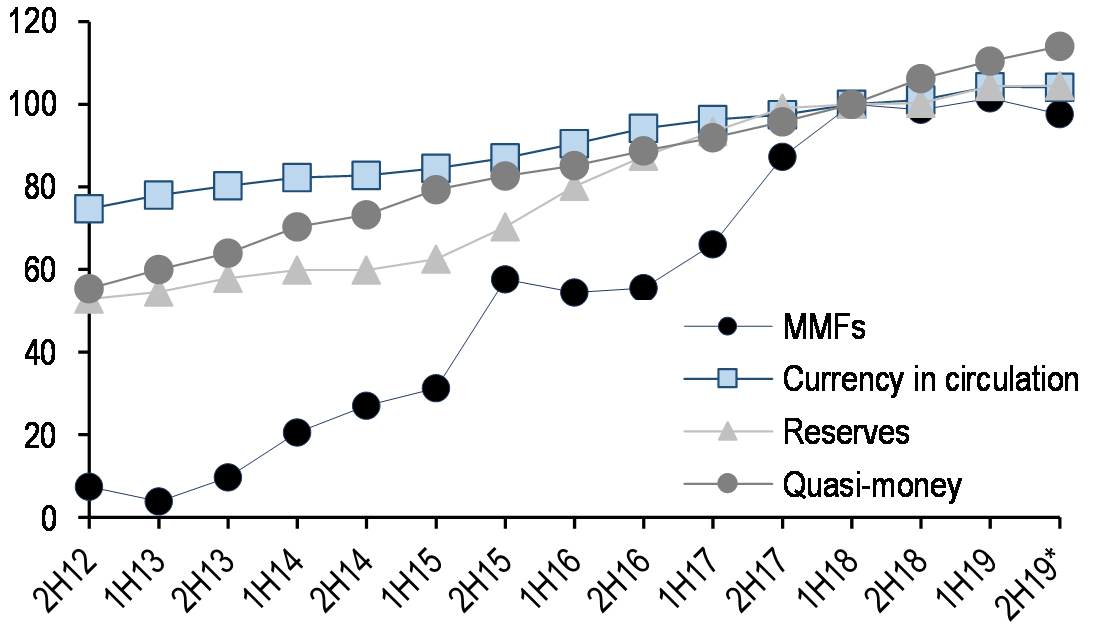
* Includes data through September 2019. Source: J.P. Morgan, IIF, Haver Analytics
However, perhaps the most interesting lesson of the Chinese MMF experience in the context of Alipay and other alternative payment systems is the responsiveness of retail investors to purely economic incentives. For example, though it is tempting to blame the stabilization of YU’E Bao AUM (including that facilitated by the fund but placed with third parties) on regulations, the fact that the removal of these limits earlier this year has not resulted in a resumption of inflows suggests that investors were responding primarily to lower yields on offer, rather than liquidity and network related incentives. In fact, the Chinese MMF complex as a whole appears to have shrunk modestly through 3Q 2019. This is striking in the context of continued growth in both the monetary base and quasi-money (Figure 24). In other words, MMF assets in China have likely stabilized primarily because the yield pick-up relative to traditional bank deposits has declined. That investors appear to be most responsive to economic considerations is striking given the other strong incentives to participate in payments-related MMFs—e.g., accessibility, convenience, scale, integration, etc. This is but one example, but holds important lessons as we contemplate the scalability and likely reception of other alternative payment systems, including Libra and other stablecoins.
Conclusion
Having covered quite a bit of ground, we conclude by taking a step back and considering what lessons the Chinese experience holds for the broader global payments system. The first, and most important, take-away is how rapidly new technology can take hold. Mobile payments in China went from virtually non-existent to systemic in only a few years. This may owe in part to the idiosyncrasies of the Chinese financial system, particularly a lack of competition from other forms of cashless payments such as credit cards, not to mention an arguably more flexible regulatory framework. But it is also likely not unique to China either, and we see no reason why other major economies cannot experience similarly rapid shifts.
Another important lesson of high speed financial disruption is the potential for an unforeseen concentration of risk. In the case of China, digital MMFs grew out of a genuine desire for alternatives to low-yielding traditional bank accounts convolved with the potential for rapid penetration and integration into existing online ecosystems via e-commerce platforms. As that occurred, subtle design features such as same-day liquidity that work on a smaller scale can be transformed by exponential growth into true threats to financial stability. A corollary is the value of the kind of rapid regulatory response that China has been able to mount to address these risks—one which is arguably somewhat less feasible in most other major economies.
Also, consumers appear most sensitive to economic incentives. YU’E Bao and other digital MMFs were attractive in part because of ease of adoption and extensive integration into existing and pervasive e-commerce and social media platforms. Ultimately, however, inflows have slowed in the absence of a meaningful yield pick-up relative to transactional accounts in the traditional financial system—even after other gates had been removed. That this has occurred despite continued expansion in the overall money supply—both the money base and quasi-money like traditional bank deposits—suggests the primary motivation for investors in Chinese digital MMFs has been yield pick-up, rather than the network externalities and other benefits associated with participation. For Libra, other stablecoins, and potential alternative payments venues more generally, the message is clear: convenience and synergies are likely insufficient without a compelling economic rationale.
Finally, the Chinese experience shows us that a cashless economy can work. The early phases are of course likely to be met with challenges and excesses. But the Chinese payments infrastructure and financial system has mostly made it through without major incident. Ensuring financial stability going forward requires close attention and discipline—even China still has a long way to go before its payments are truly fast and cashless. But the opening act appears to have been successful thus far, with clear gains from greater efficiency and financial inclusion.
Joshua Younger AC joshua.d.younger@jpmorgan.com J.P. Morgan Securities LLC | Alex Yao AC alex.yao@jpmorgan.com J.P. Morgan Securities (Asia Pacific) Limited |
Katherine Lei AC katherine.lei@jpmorgan.com J.P. Morgan Securities (Asia Pacific) Limited | Arthur Luk AC arthur.luk@jpmorgan.com J.P. Morgan Securities (Asia Pacific) Limited |
Munier Salem munier.salem@jpmorgan.com J.P. Morgan Securities LLC | Henry St John henry.stjohn@jpmorgan.com J.P. Morgan Securities LLC |
George Cai george.cai@jpmorgan.com J.P. Morgan Securities (Asia Pacific) Limited | Daqi Jiao daqi.jiao@jpmorgan.com J.P. Morgan Securities (Asia Pacific) Limited |
The Japanese case study: Rapid growth of QR code payment and loyalty programs
- The Japanese cashless rate stood at 24% (BIS basis), but at 49% with direct debit/bank transfers.
- Cashless payments growing rapidly, especially since government promotion started in Oct 2019. Credit card payments driving the rise, and QR code payments growing most.
- Loyalty programs growing rapidly, too, supported by platformers’ reward ratios as high as 20% and the negative interest rate environment in Japan.
- Platformers’ loyalty points, with currently modest market size, could be used as an alternative payment measure as their ecosystems expand. It could bring issues for monetary policy/financial stability in the medium term.
- Banks are reworking the strategy of their digital currencies while consumers choose noncash payment measures with high rewards.
Noncash payments grow rapidly in Japan
Japan is steadily going cashless. The cashless rate (as defined by BIS/the World Bank) stood at 21.4% in 2017, up from 20% in 2016, and the government is targeting 40% by 2025. Japan’s own and similar definition had it at 24.1% in 2018, up nearly 3-pt YoY, and we suspect penetration accelerated in 2019 on the back of the government’s promotional rebate program launched last October. This momentum is expected to continue after September 2020, owing to another government promotion tied to the My Number system (see Cashless, and Beyond Cashless, Rie Nishihara, Haruka Mori et al., 26 September 2019).
One reason why Japan’s cashless rate remains low on a global comparison is that it excludes direct debit and bank transfers. These have long been popular in Japan, and including them pushes the rate to 49% (2018: credit cards 16%, direct debit/bank transfers 33%), topping BIS/World Bank-based figures for the US and France.
Figure 1: Noncash payment ratio in G7 countries
Japanese noncash payment ratio is rapidly increasing
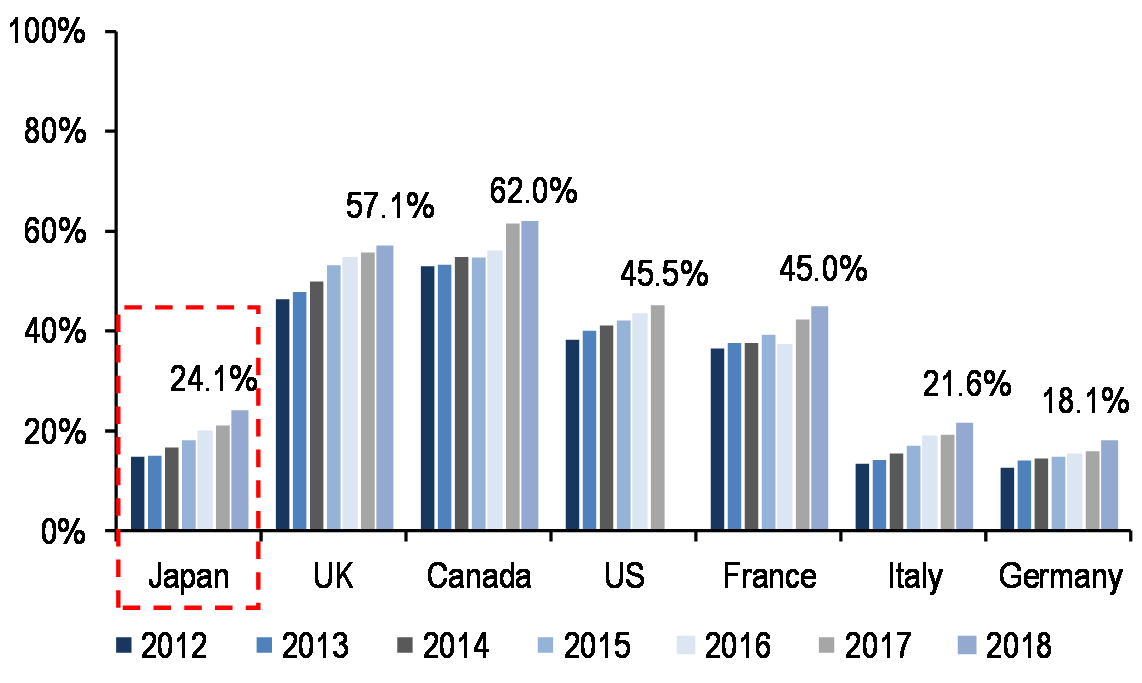
Source: BIS, World BankNote: US data for 2018 have not been released.
Figure 2: Japanese noncash payment ratio including direct debit/bank transfers (2018)
Japanese noncash payment ratio is 49% if direct debit/bank transfers included
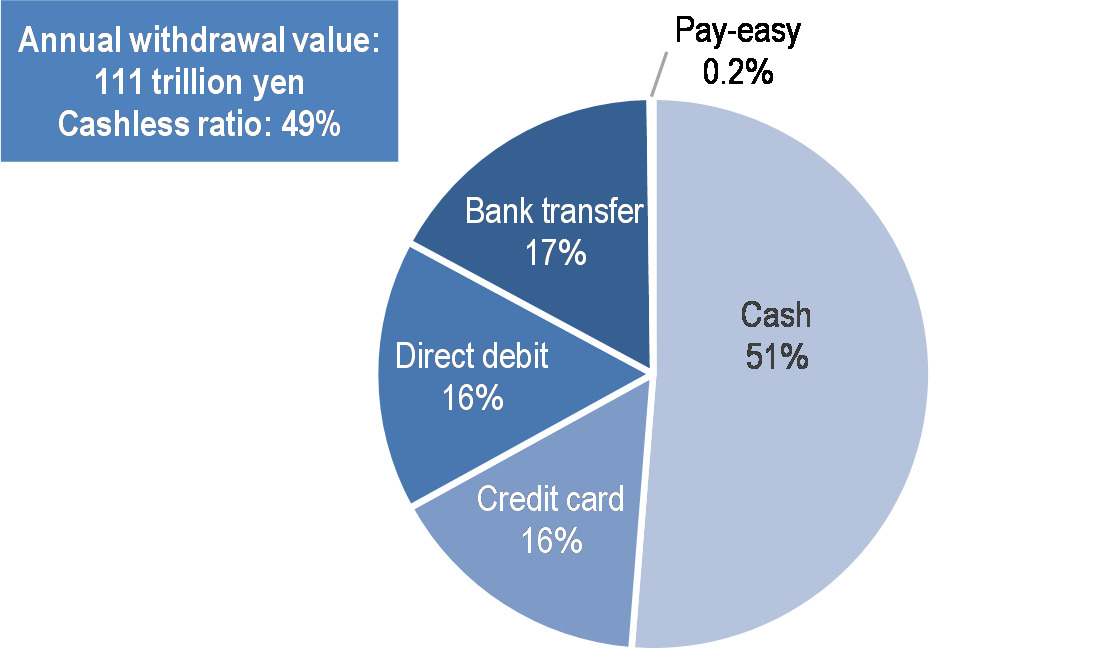
Note: Coverage scope: Megabanks + Resona Bank/Saitama Resona Bank and JP BankSource: J.P. Morgan based on Japanese Bankers Association
Credit card payments drive the growth, but QR code payments grow most
The government’s rebate program was launched in tandem with the October 1 consumption-tax hike through end-June 2020 with the aim of leveling consumption demand and of promoting cashless payments by offering point rebates for cashless purchases at SMEs. Consumers receive point rebates of up to 5% when making purchases at eligible merchants using whichever cashless payment service they are registered for. Rebates come mainly in the form of loyalty points.
METI issued a progress report on the program on January 10 that showed a total of ¥2.3 trillion in eligible cashless payments over its first two months and ¥90 billion in rebates. Credit card payments accounted for 61% of total rebates, QR-code payments for 7%, and e-money and others for 32%, but their respective contributions to the total settlement amount shows credit cards and e-money at just 2-3% of the 2017 balance but QR-code payments surging from zero to ¥0.2 trillion. According to METI’s survey, 25% of respondents used QR-code payments at least once per month, up from just 16% two months earlier and rivaling the corresponding figure for e-money.
Table 1: Government’s cashless promotion program
Progress so far: QR-code payments growing fast
| Credit card | QR code | Other e-money | ||
| Subject payment value | Approx. ¥1.4trn (approx.61%) | Approx. ¥0.2trn (approx.7%) | Approx. ¥0.7trn (approx.32%) | |
| Percentage of payment value (2018) | Approx.2.5% | Approx.12.8% | ||
| Number of subject payments | Approx. 290mn (approx.28%) | Approx. 140mn (approx.14%) | Approx. 590mn (approx.58%) | |
| Average payment price | Approx. ¥4800 | Approx. ¥1400 | Approx. ¥1200 | |
Source: METI, BOJ Note: QR code payment value was roughly zero in 2017.
Rapid growth of loyalty programs and its implication
Loyalty programs’ market size rapidly expands as QR code payments grow. The rapid growth of loyalty point programs reflects the 20% rebates that have now become standard for platformers such as e-commerce operators and also Japan’s negative interest rate environment. The 20% rebate level faces high hurdles to sustainability even for high-margin e-commerce businesses, which now seems to be facilitating consolidation of the industry. Japan’s negative interest rate policy has, meanwhile, made bank deposits less attractive and loyalty-point rebates more appealing in comparison. In other words, when banks cannot offer depositors benefits in the form of deposit yields, non-financial platformers offer consumers discounts with loyalty points, tokens with which they get discounts for future purchases.
Platformers’ loyalty points could be used as an alternative payment measure as their ecosystems expand. The more loyalty points are used, the more they become pseudo-money. Loyalty points can basically be used by issuing companies, but discount rates change and have expiration dates, so they do not fulfill the three basic functions of currency (value scale, value preservation, distribution means). However, as platformers become open to exchanging their points with others, and build large ecosystems by increasing the number of affiliated companies, the distribution functions are improved for consumers to accept them as payment measures. “Rakuten Super Point” can be used for a variety of services the company offers, from e-commerce to traveling, while “Ponta point” by Recruit can be transferable with “d point,” and “T point” can be transferable to cash.
Table 2: Major loyalty programs in Japan
Loyalty point market worth ¥1.0–1.9 trillion
| (thousand) | Number of membership owners | Program provider |
| Rakuten super point | over 10,0000 | Rakuten |
| Ponta point | 93,130 | Loyal Marketing |
| T point | 70,140 | Culture Convenience Club |
| d point | 72,340 | NTT Docomo |
| LINE Pay | 50,000 | LINE Pay |
| PayPay bonus point | 20,000 | Paypay |
Source: Company dataNote: Rakuten super point is based on number of Rakuten ID
What if loyalty points are used as an alternative payment measure? Potential issues for monetary policy, discounts from the point of view of consumers using loyalty points may not be captured in the CPI data and therefore the gap between CPIs and prices in consumers’ sentiment could widen. Under ultra-low interest rates, the marginal effect of additional interest rate cuts on lending and consumption has been reduced. The importance of routes by which platformers stimulate private consumption via reward programs could be increasing.
In addition, as points become pseudo-money, their security level could become a problem for user protection. In the case of Japan, the Cabinet Office’s Advisory Council on National Strategic Special Zones decided to include digital money payrolls as one focus of regulatory reforms in December 2019. Salary transfer to digital money offered by payment providers could be started as early as in 2020. These platformers’ digital money is linked to loyalty points and will drive a sharp expansion of the point economy and sharp progress in points’ pseudo-monetization. As all of this suggests, we are fast approaching the point at which loyalty points can no longer be ignored.
Table 3: Market sizes for major payment methods in Japan
Loyalty points market is still modest compared to other payment measures
| (trillion yen) | Amount | As of |
| Cash | 112 | Dec-18 |
| Bank deposits | 734 | Dec-19 |
| Payment value | ||
| e-money | 5.5 | 2018 |
| Credit card | 56.7 | 2018 |
| Debit card | 1.4 | 208 |
| Loyalty point market (issued amount basis) | 1-1.9 | 2018 |
Source: BOJ, Japan Credit Association, Yano Research Institute, Nomura Research Institute
The loyalty point market is currently estimated at ¥1.0–1.9 trillion in Japan, still modest compared with bank deposits (¥798 trillion in 2018), cash (¥112 trillion in 2019), credit card payment value (¥56.7 trillion in 2018), and e-money payment value (¥5.5 trillion in 2018). Its annual growth rate is 4-5%, a similar pace as global loyalty point market growth. Against this backdrop, government deliberations on the policy front are now getting underway via the JFSA’s study group.
Banks’ digital currencies: rework the strategy
In Japan, banks had not developed a 24/7 intra-bank payment system used with mobile phone numbers as in the UK, Singapore, and Sweden. Nor is the BOJ, now poised to launch a demonstration experiment for CBDC issuance, active in issuing it. Against this backdrop, Mitsubishi UFG Financial Group (MUFG) had originally planned to commercialize its blockchain-based digital currency “coin” in FY2017 but ended up delaying the launch. Media reports in December 2019 suggested that MUFG is now planning to hand off the digital-currency business to a joint venture that is to be established with Recruit Holdings in 2020. With the cashless payments space already becoming red oceans with numerous smartphone-based services such as SoftBank’s PayPay and Rakuten Pay, competition to acquire users is intensifying, and it is unclear how large a share of retail payments banks’ services might secure. In wholesale payments, MUFG plans to leverage its digital currency to provide a safe platform for corporate ecosystems.
A look at the Japanese case thus shows that banks are struggling to launch their digital currencies when consumers are attracted by platformers’ high reward levels, and negative interest rates make bank deposits less attractive. In such an economy, there is a greater possibility that digital money/loyalty points by platformers will be used as an alternative payment measure. This, as a result, could bring issues related to monetary policy and financial stability. Our focus is how the government addresses this before Japan faces such a situation. Platformers’ average 20% rebate looks unsustainable, and we will watch where this is headed. For the bank sector, we will see whether banks can establish a position in retail payments by partnering with non-financial companies à la the SMFG-GMO Payment Gateway-visa or MUFG-Akamai/MUFG-Recruit alliances and leverage their massive payment platforms to gain meaningful market share in wholesale payments.
Rie Nishihara AC
rie.nishihara@jpmorgan.com
JPMorgan Securities Japan Co., Ltd.
The market implications of Libra and other stablecoins
- Unlike free-floating cryptocurrencies, stablecoins are designed to minimize price fluctuations, in some cases by tying their value to collateral (including fiat currencies and assets).
- Libra is the most high profile such token, owing primarily to the significant network externalities created by its association with Facebook…
- …and more recently central bankers appear to have started seriously considering a supranational multi-currency-backed token as a replacement global reserve asset.
- Rather than opine on the likelihood of success for this project, we consider the stability risks introduced in any scenario in which stablecoins have a global and systemic footprint.
- Though e-commerce is primarily associated with C2B and C2C transactions, the vast majority of these payments are B2B…
- …which subjects Libra or any other stablecoin-based payments system that takes on a significant share of these transactions to the intraday liquidity requirements of a high-turnover network like Fedwire.
- Without overdraft or other short-term credit markets to redistribute cash and maintain payment chains, such a system would be prone to gridlock, particularly under stress.
- Though underbanked populations could be less at risk of payment gridlock, they make up a very small fraction of global economic and payments activity, even after including shadow economies.
- As designed, Libra relies on the income from collateral in the Reserve Account to fund network maintenance and other costs, as well as to compensate Libra Association members…
- …but with most major currencies subject to negative yields, it is unclear how such a system could continue to function if the collateral is a cost rather than a revenue source.
- The need to impose transaction costs as rates decline—especially when they turn negative—could worsen and prolong recessions by acting as an escalating tax on consumers and businesses as conditions worsen.
Libra and other stablecoins: A primer and stability analysis
What follows is both a primer on stablecoins in general and a detailed discussion of two key stability risks introduced by some designs. But first we cut to the chase:
First, high-turnover payments systems require short-term liquidity facilities, particularly daylight overdraft provided by a non-economic central authority, to avoid gridlock—especially under stress. For an asset-backed stablecoin like Libra, this is difficult if not impossible to implement by construction.
Second, the underbanked populations likely make up a small fraction of global payments volume, even after folding in the shadow economy. This means a world in which Libra or another stablecoin is successful is one in which its activity is dominated by developed markets—and by extension B2B transactions with their associated reliance on intraday liquidity.
Third, any system that relies on reserve asset income to fund operational and other ongoing costs becomes unstable in a negative yield world. With more than half of high-quality short-term sovereign debt already negative, the vast majority of the remainder made up of US government securities, and trends pointing towards global monetary easing, a fully negative-yielding Libra Reserve has become a plausible (some would argue likely) risk. The need to impose transaction costs as rates decline—especially when they turn negative—could worsen and prolong recessions by acting as an escalating tax on consumers and businesses as economic conditions deteriorate.
Introduction
Though media and market focus has waned as Bitcoin and other cryptocurrencies have fallen significantly off their 2016 peaks, the technology has not gone away (see Facebook, D. Anmuth et al., 18 June 2019, J.P. Morgan Perspectives: Blockchain and Cryptocurrencies: Adoption, Performance and Challenges, J. Loeys et al., 24 Jan. 2019, and Decrypting Cryptocurrencies: Technology, Applications and Challenges, J. Loeys et al., 9 Feb. 2018). Rather, it has evolved, and in some ways we have arguably learned the most valuable lessons of that bubble: volatility is a severe impediment to broader adoption. Extreme price fluctuations severely undercut the utility of cryptocurrencies as a store of value and, as a result, severely limit their use in true economic activity and commerce. Even today, there is evidence that Bitcoin remains primarily a vehicle for speculation24.
This highlights what we believe to be the more durable benefits offered by this innovation. As has been highlighted in prior work (see above), at base cryptocurrency is arguably more about crypto than currency. In other words, more efficient and resilient information transfer and storage via distributed ledger technology has many more applications and use cases than simply monetary.
Along these lines, the community has prioritized the ledger over the currency to some extent in shifting towards tokens designed to minimize price fluctuations relative to other financial assets and fiat currencies. Though not yet live, the most prominent cryptocurrency that has identified itself as a stablecoin is Libra, a project driven by Facebook. Such high profile sponsorship and associated network externalities create significantly greater potential for adoption and integration into global financial markets and payments than other currencies, in our view. Facebook is not the only large institution discussing such things; more recently, Governor Carney of the Bank of England voiced support for a similar project intended to provide a truly global reserve currency. However, these are only two examples of a family of cryptocurrencies with strong ties to more traditional market instruments.
Before we begin, a caveat: we are not explicitly arguing for or against the likelihood of success of the stablecoin project—or cryptocurrencies more generally for that matter. Doing so would require careful consideration of the (potentially significant) remaining technological—e.g., scalability of a particular blockchain—and regulatory—e.g., the willingness of governments and central banks to allow integration—hurdles to these kinds of projects. These are perhaps more fundamental considerations, but beyond the scope of what we seek to accomplish here. Instead, we consider the market and stability implications of widespread use of Libra and/or other stablecoins as a medium of exchange and store of value. In this sense, for this analysis their success is assumed in constructing our scenarios, and we proceed from there.
To date, there has been quite a bit of discussion of the macro risks posed by this technology. First and foremost, a wholesale shift towards alternative currencies without government backing could significantly reduce the efficacy of monetary policy. Further, P2P digital money—even coins issued and backed by familiar central authorities (e.g., The long, uncertain road from bitcoin to Fedcoin, M. Feroli, 20 Oct. 2017)—runs the risk of disintermediating the commercial banking system, disrupting credit creation with negative consequences for growth. Less focus, however, has been paid to the impact on financial infrastructure, and in particular the potential instabilities introduced by design decisions. In the case of Libra or an alternative global reserve currency, there is an advantage to undertaking this kind of analysis when the project is in its infancy, and seemingly small changes can have an outsized impact down the road. Particularly with stablecoin-style tokens now being discussed—even in passing—by some central authorities as a global reserve asset, these considerations become that much more critical to the stability of global payments.
A brief primer on stablecoins
With that in mind, we first consider the various families of stablecoins that have been proposed and/or launched. Broadly speaking, they fall into three categories: asset-backed, sponsored, and algorithmic. We summarize this family tree with some examples in Figure 1.
Asset-backed tokens derive and maintain their value by being exchangeable for other assets25. Most analogously to more traditional currencies, these assets can take the form of commodities like gold—Digix Gold is one such example. They can also take the form of fiat currencies, either in the form of bank deposits or securities. By far the largest of these is Tether, which as of this writing has a market capitalization in excess of $4bn, making it the seventh largest token and nearly 10x larger than USD Coin. Both of these stablecoins are generally referred to as off-chain, meaning they are backed by non-crypto assets. Alternatively, there are on-chain stablecoins, which can reference a basket of free-floating cryptocurrencies.
Figure 1: Stablecoins and various forms of tokenized payments can be broadly split into asset-backed, sponsored, and seigniorage-style (algorithmic), and the asset-backed can be backed by a mix of on- and off-chain collateral
Schematic family tree of stablecoins and tokenized payments variants by underlying methodology and collateral type, with example tokens for each
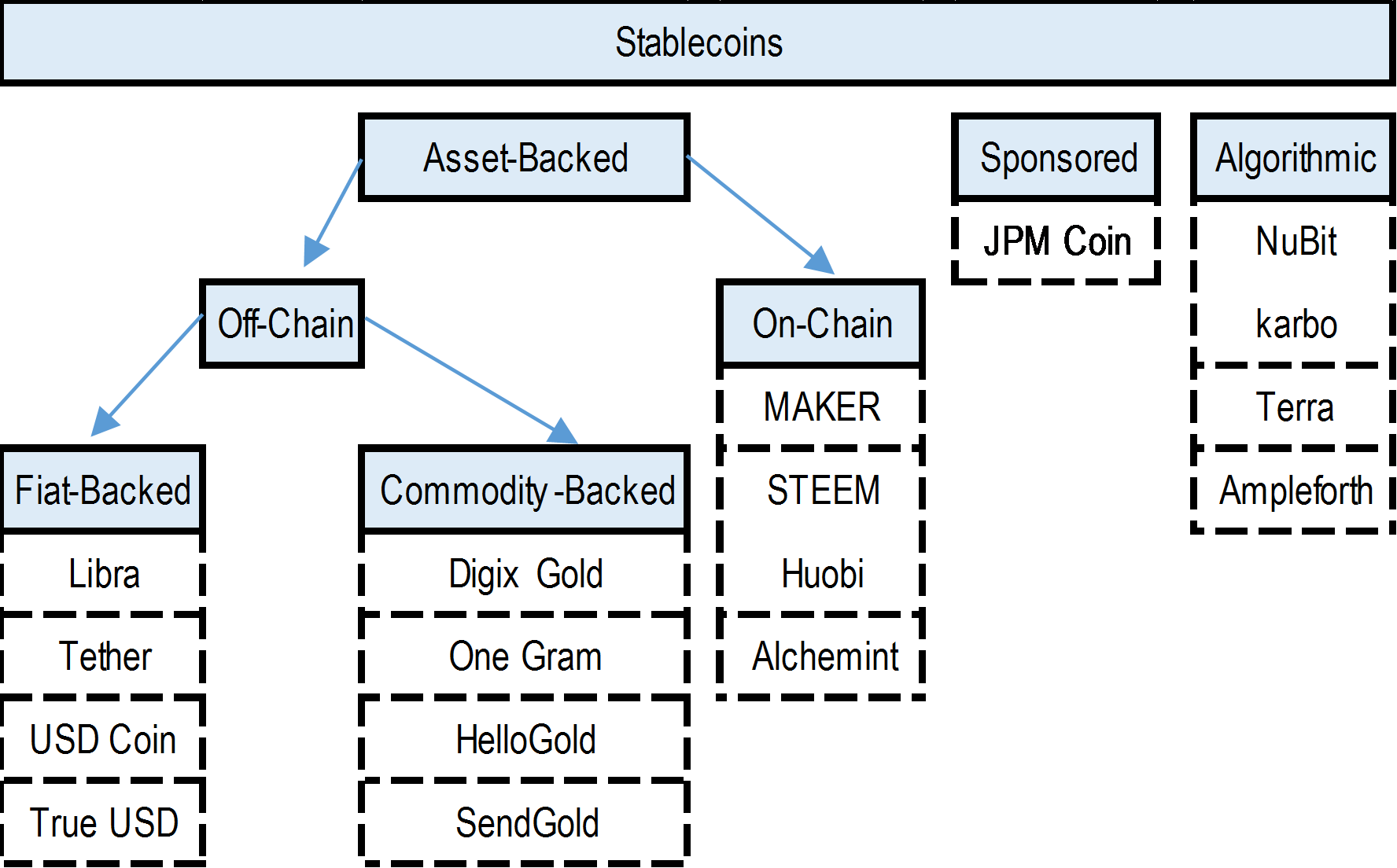
Source: J.P. Morgan, Blockdata.tech
Sponsored tokenized payments are backed by an agreement with a sponsor institution. In the case of JPM Coin as currently contemplated, for example, they are freely exchangeable for a USD-denominated credit2627to a J.P. Morgan deposit account. In this way, they can be easily converted into fiat currency and in theory should have a strong anchor to their value. Another distinguishing feature of coins sponsored by banks is that they can be designed to be exchangeable for FDIC insured fiat deposits and therefore could be considered higher credit quality than some asset-backed coins.
Finally, there are seigniorage-style, a.k.a. algorithmic, stablecoins. These essentially amount to rules-based monetary policy taken to the extreme: new coins are automatically created (or “minted”) and destroyed (“burned”) to target a stable exchange rate versus a reference fiat currency or basket.
Recent trends suggest the market has broadly coalesced around asset-backed stablecoins (Figure 2). A recent report from Blockdata.tech, for example, finds that 95% of the roughly 66 currently active stablecoins use this approach. Though there was a bit more diversity among the 134 new tokens in development at the time the report was published, 77% of those were also asset-backed. It is also worth noting that of the 25 stablecoins that have been closed, 20% were algorithmic, and roughly half of the remainder were linked to gold rather than fiat currency.
Libra has unsurprisingly received disproportionate attention since its announcement earlier this year. This has less to do with its design than its sponsor, in our view: with over 2.4 billion monthly active users, Facebook is a powerful and valuable platform for the promotion of a new digital currency. In this sense, we think it’s useful to focus specifically on its proposed collateral pool, the potential for growth, and what impact its success might have on financial markets. That is with the important caveat that the Libra project remains in very early stages, with details subject to change.
Figure 2: The vast majority of stablecoins, both active and in development, are asset-backed
Number of tokens by style and current status
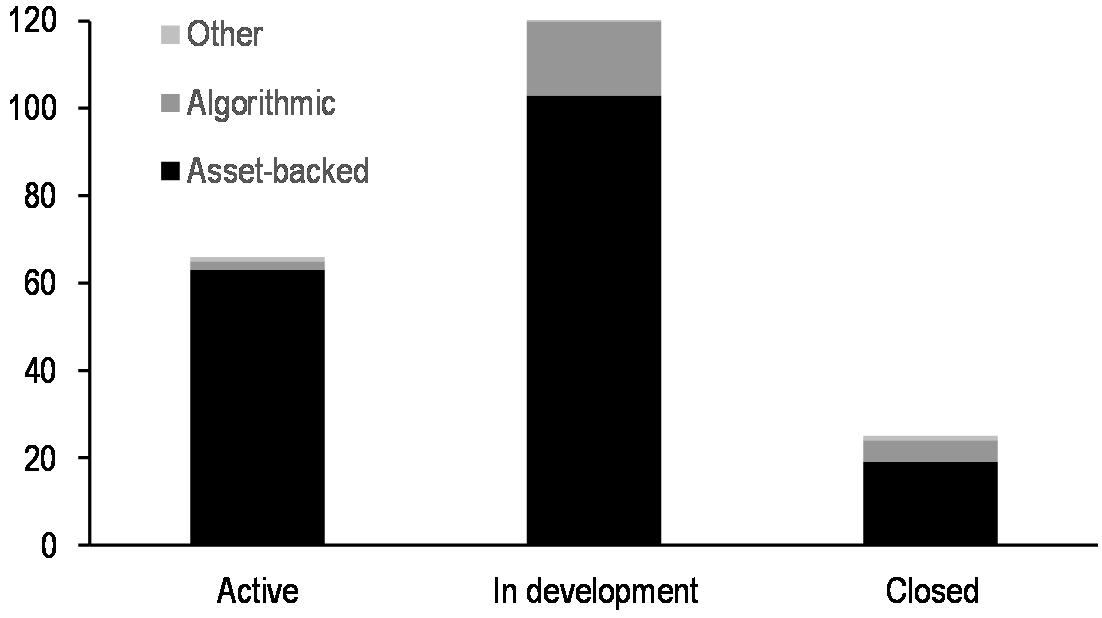
Source: Blockdata.tech
The first question we can ask is: does fiat currency backing work in practice? For this we can compare the daily volatility in several stablecoins pegged to USD to larger free-floating cryptocurrencies. The results suggest that even in arguably very nascent form these pegs are effective at suppressing daily volatility: roughly 0.5% per day versus 4-6% for XRP, ETH, and BTC (Figure 3). To be clear, 0.5% of daily volatility in FX markets is far from stable. In fact, not only have pegged currencies like HKD posted much lower levels of vol over the same period, but even the trade-weighted US dollar is less volatile. That said, it is plausible that observed inefficiencies in stablecoins reflect a relatively thin and under-developed market. Presumably better liquidity would alleviate much of this volatility, helping further improve stablecoins’ function as a store of value and facilitating adoption.
Figure 3: USD-backed stablecoins exhibit much lower volatility than their freely floating cousins, but are still much more unstable than pegged fiat currencies
1-year daily volatility by token; % per day
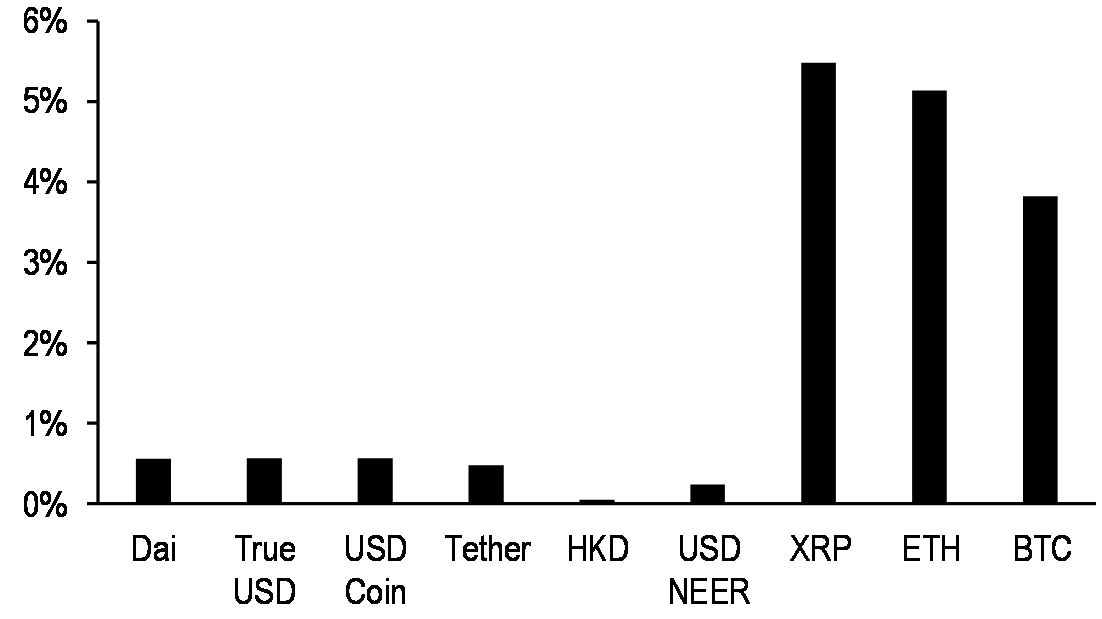
Source: J.P. Morgan, coinmetrics.io
A large-scale payments system without short-term credit for settlement liquidity is inherently unstable
Given some empirical evidence that fiat currency-backed tokens are much more stable, we turn our attention to implications of their success. Naturally, this is a big “if.” The regulatory hurdles facing Libra and its cousins are substantial, to say the least. In addition to reports of significant regulatory scrutiny in the US, multinational organizations have voiced concerns and highlighted the need for extensive study and risk management as well28. However, rather than opining on the likelihood of widespread adoption, we consider the direct impact such an event might have on financial markets. In particular, we consider the financial stability implications of a large, Libra-based global payments system to rival those tied to fiat currencies.
To do so, we start with the amount of Libra that would likely be required to safely and reliably operate such a system. Two features are key to this estimate. The first is the nature of settlements in most cryptocurrency-based payments: real-time gross settlement (RTGS), meaning all transactions are cleared instantly and there is no netting. Similar mechanisms are currently common among the large value payment (LVP) systems—e.g., Fedwire in the US, TARGET2 in Europe, etc.29—that form the backbone of global transfers and dominate global payments volume (90-95% across most major jurisdictions). In this sense, we have some empirical evidence to rely on when considering their behavior in normal times and under stress.
The second is the volume and nature of that activity. For this aspect, we focus on e-commerce activity that would likely be a first mover to a stablecoin-based payments system. Data collected by the UNCTAD suggests that the vast majority of that volume occurs in B2B format, rather than among or to consumers (Table 1). That is not to say Libra is likely to be dominated by these types of transactions. However, it does suggest that a world in which stablecoins are used for a significant fraction of e-commerce is also one in which the players are predominantly B2B. Were Libra or something like it to constitute a systemically important currency and payments system, it would likely behave similarly to operational corporate wholesale bank deposits: high turnover with relatively small average balances compared to gross activity. Though there are important differences worth keeping in mind, this suggests that LVP systems like Fedwire are a reasonable if imperfect analogy.
Table 1: The vast majority of global payments occur in large value payment systems, and e-commerce makes up a modest share even of those remaining retail payments
Payments data by country as of 2017
| Retail and Fast Payments | E-Commerce Volume | |||||
| Country | Amount; $bn | % of total payments | Amount; $bn | % of retail | B2B Share | |
| United States | $65,654 | 5% | $8,883 | 14% | 90% | |
| Japan | $26,712 | 5% | $2,975 | 11% | 95% | |
| China | $47,282 | 12% | $1,931 | 4% | 49% | |
| Germany | $3,704 | 5% | $1,503 | 41% | 92% | |
| Korea | $18,362 | 15% | $1,290 | 7% | 95% | |
| United Kingdom | $8,781 | 9% | $755 | 9% | 74% | |
| France | $6,572 | 16% | $734 | 11% | 87% | |
| Canada | $4,380 | 6% | $512 | 12% | 90% | |
| India | $1,741 | 9% | $31 | 2% | 91% | |
| Italy | $1,816 | 1% | $23 | 1% | 93% | |
| Top 10 | $185,005 | 7% | $18,637 | 10% | 87% | |
| Global Total | $204,854 | 6% | $29,367 | 14% | 87% | |
Source: J.P. Morgan, BIS, UNCTAD
Figure 4: The payment system effects of a larger Fed balance sheet provide an invaluable experiment in intraday liquidity requirements of institutions’ RTGS systems at different levels of underlying cash
Bank cash (LHS) and peak daylight overdraft (RHS) as a % of total Fedwire volume, quarterly data
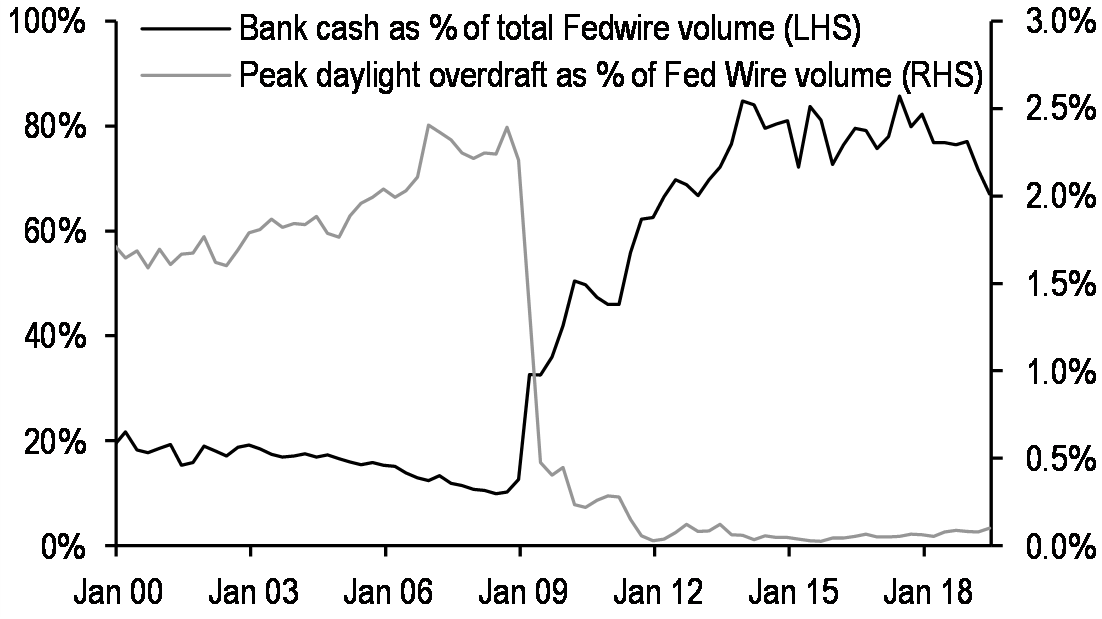
Source: J.P. Morgan, FRB
A critical difference between fiat currency RTGS systems and cryptocurrencies in general—including stablecoins—is the availability of short-term extensions of credit for settlement liquidity. For the Federal Reserve System, there are both private and public venues to do so. The Federal funds market allows for the temporary redistribution of reserves among banks, from those with excess liquidity to those with a shortfall. Alternatively, the central bank extends credit in the form of daylight overdraft, in which temporary new reserves are created to relieve shortfalls. This effectively bridges timing mismatches between receipts and payables that would otherwise lead to significant frictions and gridlock in the payments system (for a theoretical discussion, see also Beyeler et al., 200630). For example, if a bank has an opening balance of $20 and owes $100 before noon, but expects to receive $90 before the close at 6:30pm, it can resort to either borrowing the reserves from another bank with an excess (e.g., buying Fed funds) or overdrafting its Fed account if that payable is late in arriving and not miss the deadline.
This allows Fedwire and other RTGS systems with very high account turnover to operate stably on relatively small stocks of cash. It is also particularly important to allow the payments system to continue operating during unexpected events—e.g., the September 11, 2001 attacks, which rendered several large Fedwire nodes unable to process instructions.31 It is also worth noting that a public source of temporary settlement liquidity (e.g., Fed daylight overdraft), in being immune from market distortions and the laws of supply and demand, is particularly valuable during these periods of unforeseen stress.
As proposed, Libra and other stablecoins—all cryptocurrencies, for that matter—have no such short-term credit markets. In being fully asset-backed, their design is somewhat inconsistent with daylight overdraft or similar facilities, since there is no central counterparty with authority to mint temporary coins for this purpose, and it would be impractical to source collateral for such short periods. This suggests the ratio of volume to cash in such a payments system must be sufficiently low as to make overdraft unnecessary. Thankfully for our purposes, the Fed conducted precisely this experiment when it expanded its balance sheet as part of QE: as excess reserves increased and member banks were able to more easily run higher opening balances, overdraft activity essentially vanished (Figure 4). This also led to much earlier payments overall, which further reduced the risk of timing mismatches to trigger short-term disruptions that risk cascading into much larger events.32 This not only applies to the system as a whole, but to its smaller participants in particular.33 Based on this experience, we estimate that roughly $600bn of stablecoin would be required to facilitate $1trn of daily transactional activity without frequent disruptions (defined as less than 0.1% peak daylight overdraft). That said, given a lack of daylight settlement liquidity, we would argue more conservative levels are likely necessary, since even isolated disruptions in payment activity can have cascading consequences if they occur in key nodes. Conservative design calls for targeting a cash-to-volume ratio that is calibrated to times of stress, rather than normal operations.
This highlights a key risk posed by the sequencing of growth in a global stablecoin. As usage expands, merchants and service providers will increasingly accept these tokens as payment at the same time as new coins are minted. One could imagine a scenario in which payment activity expands faster than the available stock of the currency’s ability to safely facilitate those transactions under stress. Under those circumstances, the risks posed by this setup would be masked by smooth operation in normal times. By the time tail events do materialize, stablecoin-based payments could have grown systemically important, making the macroeconomic and financial consequences of significant disruption similarly destructive. This would be compounded by any run from Libra and other stablecoins due to currency and credit events or, as we discuss below, problematic shifts in global monetary and bank regulatory policy.
This could be addressed in two ways. The first would be to implement liquidity-saving mechanisms. These systems delay and aggregate transactions to allow for netting and are much more efficient. In the US, CHIPs (LVP) and ACH (retail) are highly efficient while allowing for same-day settlement. We estimate these venues allow US institutions to facilitate $100 of gross payment activity with less than $10 of cash on hand (see The financial stability benefits of very abundant reserves, J. Younger et al., 2 Feb. 2019). In this sense, incorporating some capacity to allow for netting by delaying payments that are not truly needed urgently into stablecoin payment systems would enhance their stability.
The second would be to conduct an extensive study of existing payment systems, with the results used to inform restrictions or incentives in the minting and burning of stablecoin, as well as regular monitoring of risks to the payments system. Libra, in particular, is set up well for this kind of supranational regulatory infrastructure, given a governing Libra Association, a gatekeeping role played by authorized resellers of the currency, and a closed network for the first five years. In principle, part of the responsibility of these resellers could also be to provide short-term liquidity to major participants in the payments system, to further mitigate the risk of abrupt and significant timing shifts to trigger cascading disruptions.
Tokens issued by central authorities do not suffer this limitation. A dollar-backed token issued by the Fed, for example, could in principle benefit from the same or comparable liquidity facilities currently enjoyed by participants in Fedwire. However, this benefit primarily arises from the fact that such a token would be issued by fiat and not backed by collateral; Fedcoin would only be a ‘coin’ to the extent it exists on a distributed ledger. This brings up a host of questions about who should be given access to such a network, but they are beyond the scope of the currency itself. In other words, a Fedcoin or equivalent token from another central authority would likely in practice simply be a technology upgrade to the payments system, rather than a truly decentralized and/or alternative venue.
What about the underbanked?
A reasonable retort to the above would be: what about the underbanked? The Libra White Paper is quite clear that financial inclusion is a key motivation for their project. Were this segment of global consumers to drive the growth of this or another similar currency, it would presumably be more about P2P than B2B payments. As such, one could imagine it would lessen the risk of gridlock by distributing activity across a much larger number of accounts, avoiding issues of congestion at individual nodes.
The first observation worth making is the relatively small footprint of the underbanked in the global economy. Based on data collected by the World Bank in 144 countries, global economic activity is unsurprisingly far more concentrated among countries with high levels of financial inclusion (Figure 5). For example, the 1.5 billion people (~20% of the total) in its sample for which less than 40% have a bank account34 represent less than 5% of nominal GDP across the whole sample. On its face, this suggests the payments activity associated with these populations is likely to be rather limited.
To what extent do official statistics undercount activity in developing countries? There are well established statistical techniques for estimating the size of the shadow economy, the results of which show very clearly that a significant fraction of “true” GDP in developing and underbanked economies does occur in underground markets (e.g., Median & Schneider, 201835). That said, we are not talking about an order of magnitude—more like 20-30%, on average, among lower income countries, with some as high as 50-60%. Further, underground activity makes up a non-trivial fraction of economic output in larger economies as well. As a result, the proportion of world GDP attributable to underbanked economies is very similar after applying these adjustments (again, Figure 5).
Figure 5: Though the underbanked represent a significant fraction of the global population, economic activity is much more concentrated among countries with higher levels of financial inclusion …
Fraction of global GDP and population in buckets by fraction of adult population (15+ years old) with a bank account, data as of 2017; %
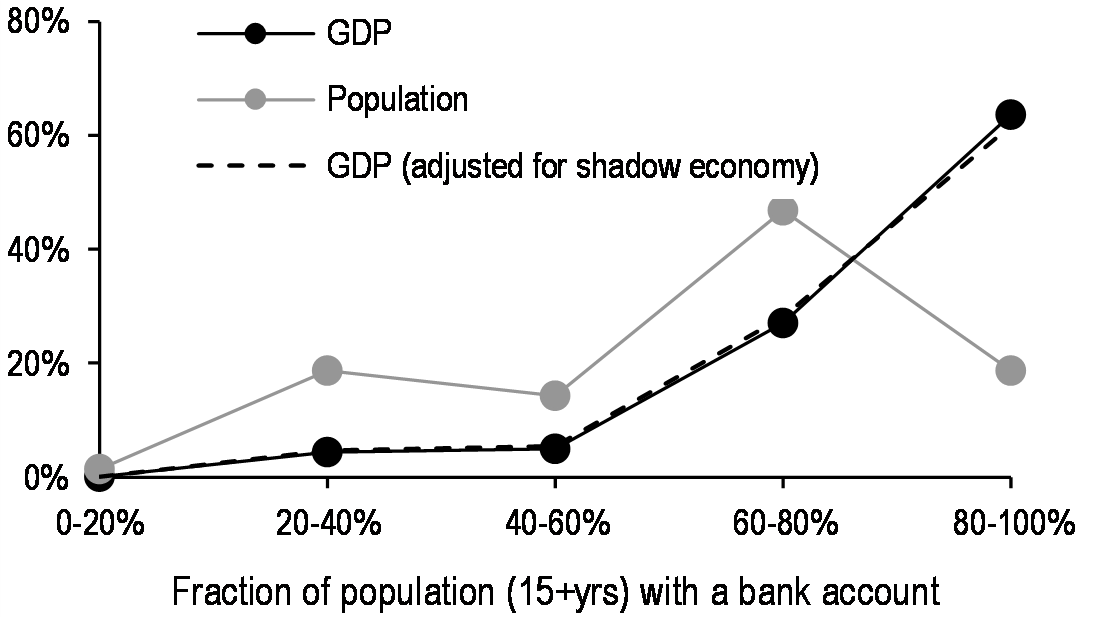
Note: Based on data from the 2017 World Bank Global Findex Database. Economic and population data also from the World Bank with the exception of Taiwan (from Bloomberg and the IMF). South Sudan data as of 2016. The sample includes 144 countries. Shadow activity based on estimates as a % of GDP as of 2015 by L. Median & F. Schneider, Shadow Economies Around the World, IMF Working Paper 18/17, 2018, which covers 92% of the World Bank sample by count and more than 99% by GDP.Source: J.P. Morgan, World Bank, IMF, Bloomberg, Medina & Schneider
Table 2: … and BIS payments data suggest that, if anything, lower income countries, which are also generally underbanked, have lower levels of payments activity per unit economic output
Statistics for various counties split by World Bank Income Category
| World Bank Income Category | ||||
| Attribute | Low | Lower middle | Upper middle | High |
| 2017 GDP ($bn USD) | $418 | $6,493 | $22,231 | $50,346 |
| % of World GDP | 0.5% | 8% | 28% | 63% |
| Shadow economy (%of GDP) | 35% | 29% | 21% | 13% |
| % of adjusted World GDP | 0.6% | 9% | 29% | 61% |
| Avg. % with bank accounts | 33% | 44% | 62% | 92% |
| GDP-wtd% with bank accounts | 37% | 58% | 73% | 95% |
| Non-bank pmt of GDP Ratio* | N/A | 8.1 | 29.3 | 12.2 |
* As of 2016 for counties covered by the BIS Red Book.Note: GDP and financial inclusion statistics cover the full World Bank sample of 144 counties; shadow economy data covers 92% of that by count and more than 99% by economic output; and payments data is for the subset of 22 counties covered by the 2017 BIS Red Book.Bank account in this context refers to the definition from the World Bank Findex glossary, which includes deposits at banks and other financial institutions as well as self-reported personal use of mobile money services.Source: J.P. Morgan, World Bank, IMF, Bloomberg, BIS, Medina & Schneider
We can combine this with data for the 22 countries covered by the 2017 BIS Red Book36 to get a sense of how this maps to payments specifically (Table 2). Though more limited, this does include some examples of lower middle income countries (per the World Bank definition), for which the average level of financial inclusion is much lower than that of upper middle or high income countries. The results suggest, if anything, the ratio of payments activity to economic output is lower in these less developed economies. Combined with the observation that the shadow economy in these countries only marginally increases their global footprint, we believe it’s fair to say that a world in which Libra is systematically important is a world in which payments in this currency are dominated by larger economies, and by extension B2B payments and with the associated reliance on intraday liquidity.
Finally, P2P payments in underbanked populations will not necessarily behave like those in developed economies. In the US, for example, a CFPB study37 found that frequent overdrafters typically were younger with shorter tenures as depositors, had lower FICO scores and much less access to traditional sources of consumer credit (e.g., credit cards). At the same time, they had the highest level of gross monthly deposits but lowest average end-of-day balances. In many ways, this population resembles the underbanked globally, and their high-turnover payment activity looks more like B2B than anything else.
Negative yields pose a significant challenge to fiat-backed stablecoins like Libra
Libra, as currently proposed, is an asset-based stablecoin tied to multiple fiat currencies. The Libra Reserve will be set up to manage the collateral pool, consisting of bank deposits and short-term government securities in currencies from “stable and reputable central banks.” We think it’s safe to say this likely refers to large, developed economies like the G10, and particularly avoids significant capital controls. Authorized resellers can mint new Libra by delivering eligible fiat currency cash and securities; equivalently, they can redeem their Libra for the same. In this way, the value of a Libra will vary with this underlying basket and will not be pegged to any one currency. The Reserve will also inherit the monetary policies of the relevant central banks, similarly to currency boards like the Hong Kong Monetary Authority.
The investment policies of this Reserve are set by the Libra Association, a third-party governing body based in Switzerland, and can only be changed with a supermajority vote. Their stated goal, however, is value preservation rather than maximizing returns. Consistent with this, the holders of Libra do not benefit from any income or trading gains generated by the Reserve; they are instead used to fund day-to-day expenses and development. Libra Association Members will also receive Libra Investment Tokens (LITs), which represent a pro-rata share of any income or trading gains on the reserve assets, net of these expenses.
This raises the question of whether there is sufficient free float of collateral for stablecoin payments systems to take on a significant volume of retail transactions. Conceptually, fiat currency-backed stablecoins will function very similarly to central banks with a highly managed exchange rate—a combination of gold standard and currency board. Net inflows into a given stablecoin can therefore be thought of as a capital account surplus; to avoid appreciation versus the reference basket, those inflows are invested in fiat currency assets against which new tokens (liabilities) are minted—and vice versa in the event of net outflows. Thus, the collateral pool functions analogously to an FX reserve manager in emerging economies with a large current account imbalance and explicit valuation targets relative to a reference basket.
Given this conceptual framework, there is optically more than adequate high-quality collateral to provide reserves for such a payment system in aggregate, including more than $2trn of AAA-rated short-term government securities38. Potential issues arise, however, when we consider the global monetary policy environment. As Europe and Japan have abandoned the zero bound as a floor on policy rates, more than a third of global bonds now trade with a negative yield (Figure 6), including more than half of the front end (the vast majority of which are concentrated in USD and GBP; Figure 7). This presents a significant challenge to reserve models like what has been proposed for Libra, which rely on income from their holdings to fund operational costs and development work to maintain and improve the network. In this way, it is unclear how Libra and other similarly designed stablecoins would cope with persistently negative yields on a large proportion of reserve assets.
Figure 6: Over the past few years negative yields have enveloped more than a third of global sovereign debt …
Fraction of GBI constituents with negative yields; %
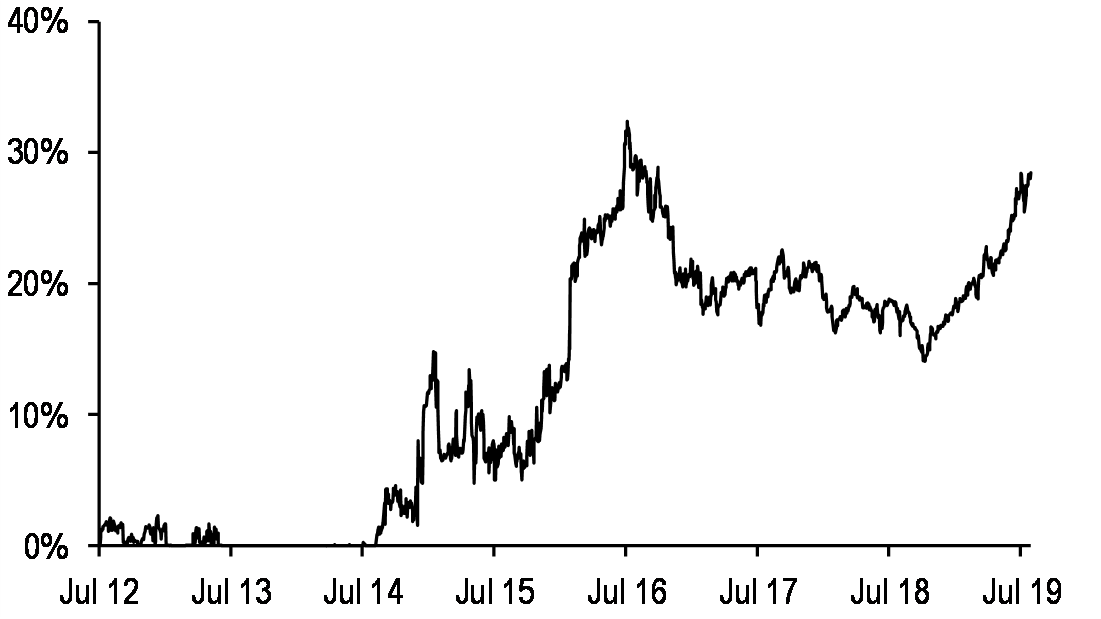
Source: J.P. Morgan
Figure 7: … particularly at the front end, where negative yields are the rule rather than the exception
Outstanding balance of GBI-eligible assets broken out into positive yielding currencies (LHS; $bn), with % of that amount labeled, as well as % of all bonds in each maturity bucket with positive yields as of July 2019
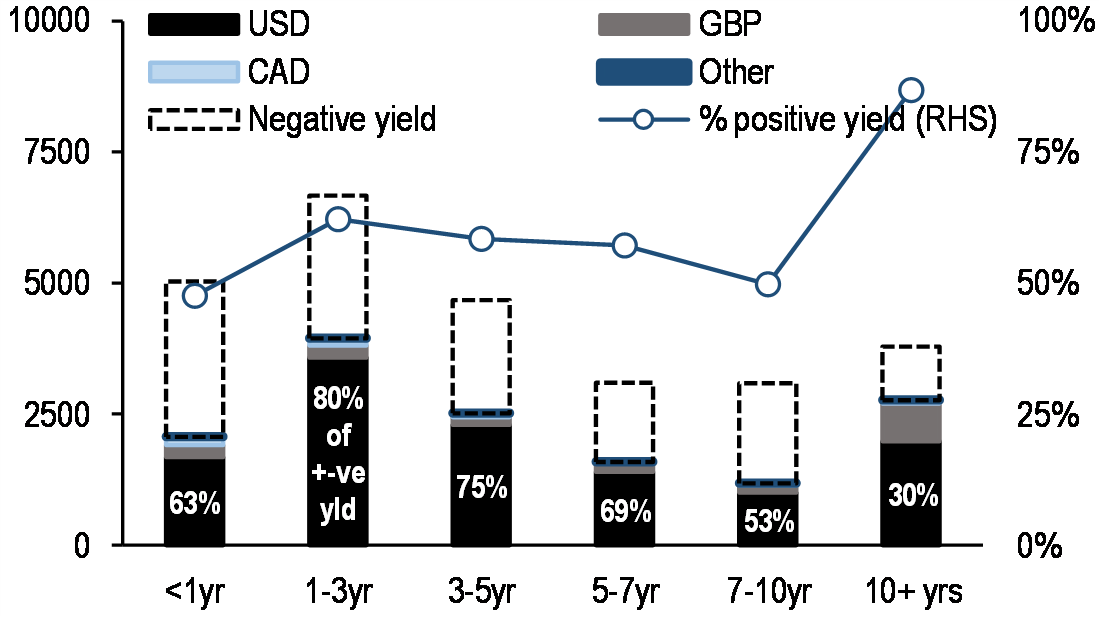
Source: J.P. Morgan, Bloomberg
What if the Libra Reserve were to simply avoid negative yields? If we restrict this sample to just securities likely to be eligible for Libra collateral, this includes roughly half of the short-term, highly liquid government securities issued by the top 10 countries most active in e-commerce and retail payments (Figure 8). Of the roughly $2trn left with a positive yield, more than 70% consists of T-Bills and short coupons issued by the US government. Of that, roughly $750bn is already held by US money market funds (see “Short-Term Fixed Income” in US Fixed Income Markets Weekly, A. Roever et al., 12 July 2019) and a bit less than $300bn in foreign official hands (see e.g., the May 2019 release from the Treasury International Capital [TIC] System39). This leaves quite a bit less free float in positive yielding, short-term government assets not subject to capital controls than broader market aggregates would suggest.
Could the Libra Reserve simply turn to bank deposits as an alternative? This presents two challenges. The first is a lack of federal insurance on most large corporate deposits. This exposes the reserve to counterparty risk, which in principle should sharply narrow the list of banks to those which are a de facto substitute for government securities—i.e., large international and well-capitalized institutions that would likely be considered too big to fail in a crisis, and thus enjoy an implicit government backstop. Second, those same large institutions are subject to liquidity requirements that sharply penalize wholesale deposits40. The high runoff rates assumed in outflows used to calculate the relevant ratios require larger stocks of low-yielding high-quality liquid assets (HQLA; mostly government securities and bank reserves) that negatively impact business performance (Figure 9). In the US, for example, this led to an industry-wide push to reduce exposure to non-operating corporate deposits (see Deposit non-grata, A. Roever et al., 27 Feb. 2015)—which would presumably describe Libra Reserve assets.
This is an inherently unstable setup. Imagine, for example, that Libra achieves its potential as an alternative currency with a significant share of global payments but with reserve assets heavily concentrated in USD and other positive yielding government securities. In such a scenario, any move into negative rates by the Fed would be a profound shock to Libra. On the one hand, it would deprive the system of income to meet baseline expenses, which might require passing these costs along to some combination of authorized resellers or Libra Association Members. On the other, it would render LITs not just essentially worthless, but more akin to a liability than an asset from the perspective of these members. It would be natural to question the value of remaining a member of the Association under those circumstances.
Figure 8: Global financial markets are awash in high quality short-term government debt suitable as stablecoin collateral, but only half offer positive returns
Outstanding balance of government debt with a single-A credit rating and positive versus negative yields as of July 2019; $bn
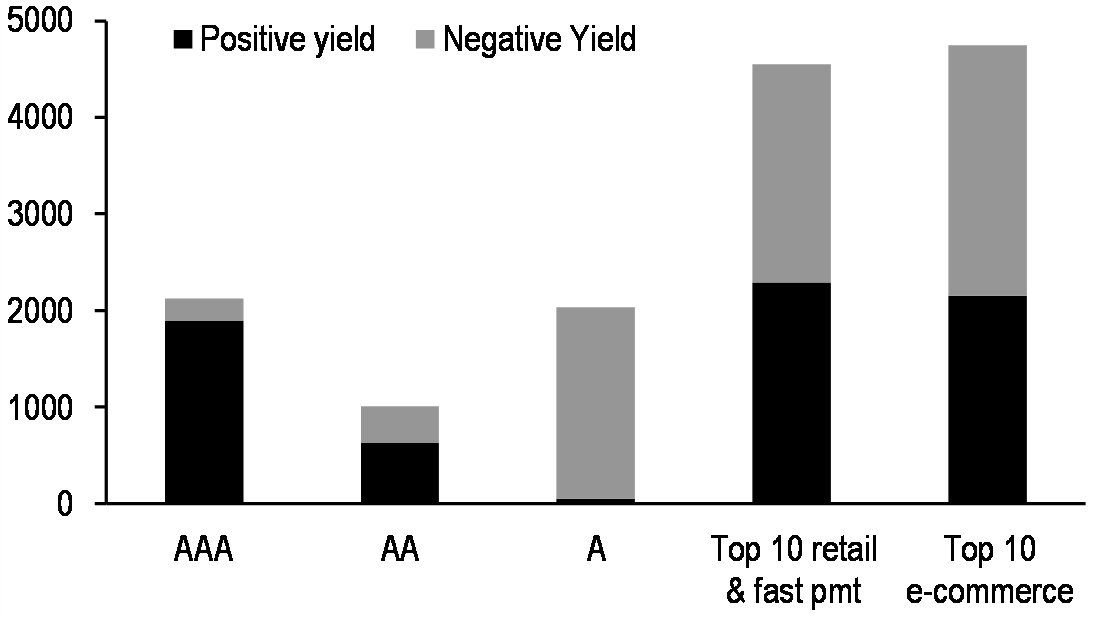
Source: J.P. Morgan
Figure 9: Libra Reserve deposits would likely be considered non-operational wholesale unsecured funding, which receives relatively punitive treatment in bank liquidity regulations
Funding by source among the four largest US banks, fraction of overall funding and outflows for LCR purposes, all as of 4Q 2018; %
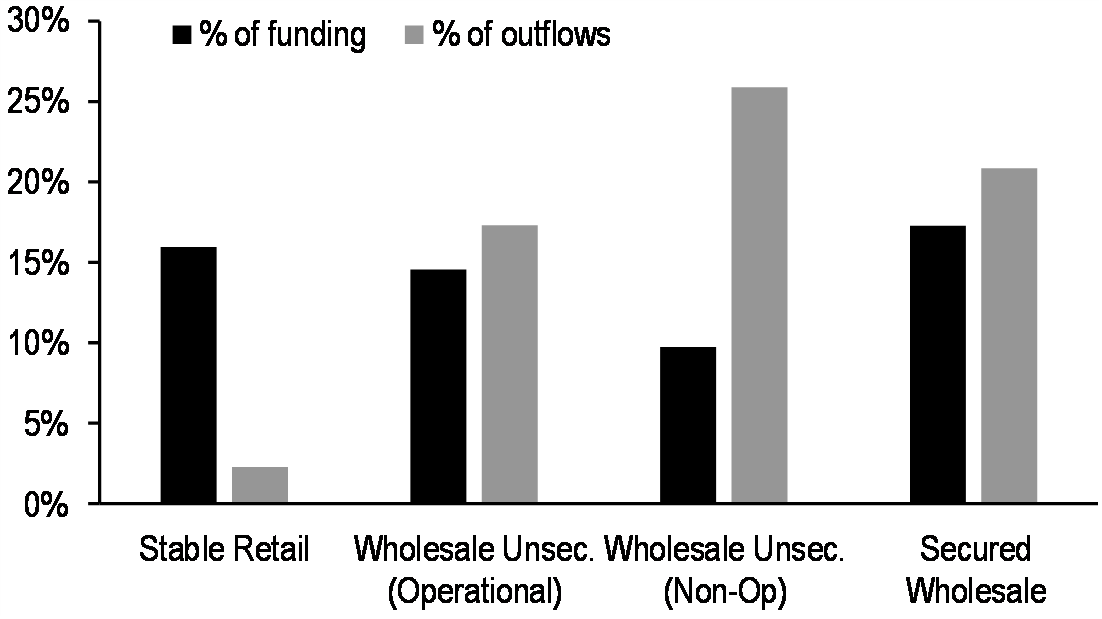
Source: J.P. Morgan, company disclosures
The risk of an exodus and run on LITs could be very destabilizing for the currency, and global markets more generally. First, it would become much harder to maintain the network in the absence of funding, and in the extreme, of willing participants—a run on LIT, if not the currency. Second, to the extent this results in a substantial reduction in the stock of Libra available for transactions, the risk of payment system gridlock due to liquidity shortfalls would increase as well. At a minimum, persistent negative yields on Libra Reserve assets would likely force a significant redesign of the currency—for example, charging a negative yield on Libra wallets, either through transaction or storage fees. In the extreme, this could make it far more difficult for global central banks to respond to economic or financial shocks without introducing new systemic risk via this channel.
One potential way to continue operating a Libra-based payments system in a low and especially negative yield world is to impose transaction costs when funds run short. This would, however, arguably drive vicious cycles during periods of stress. Since negative yields reflect challenging economic circumstances, imposing transaction costs would be in some sense equivalent to raising taxes on consumers and businesses in the face of slowing growth. The implicit rate of this tax would also increase as worsening growth and financial conditions drove rates lower. To the extent Libra-based payments become an important part of the global economy, this would work against monetary policy and potentially worsen and prolong recessions.
Conclusions
What are we to conclude from this exercise? Stablecoins, and Libra in particular, have the potential to grow substantially and ultimately shoulder a significant fraction of global transactional activity. However, as currently designed and proposed, they do not take into account the microstructure of operating such a payment system. A lack of short-term liquidity facilities, particularly those relatively insulated from market forces, introduces the risk that activity grows faster than the underlying base of currency can safely support. The risk of payment system gridlock, particularly during periods of stress, could have serious macroeconomic consequences. Though underbanked populations could be less exposed to this risk, they make up a very small fraction of global economic activity, even after including shadow economies. This is exacerbated by the difficulty of operating the Libra Reserve in a world increasingly dominated by negative interest rates. The interaction between the two poses significant and potentially systemic risks to global payments, and by extension economic growth. Finally, the need to impose transaction costs as rates decline—especially when they turn negative—could worsen and prolong recessions by acting as an escalating tax on consumers and businesses as conditions worse. They can, however, be addressed by learning the lessons of fiat currencies: liquidity-saving mechanisms and short-term credit are essential, and reserve assets should be thought of as collateral rather than a source of returns
Joshua Younger AC
joshua.d.younger@jpmorgan.com
J.P. Morgan Securities LLC
Munier Salem
munier.salem@jpmorgan.com
J.P. Morgan Securities LLC
Henry St John
henry.stjohn@jpmorgan.com
J.P. Morgan Securities LLC
Can stablecoins achieve global scale?
- In a previous publication we examined the practical challenges to operating a stablecoin-based payment system…
- …but as the G7 Working Group noted in a recent report, the risks posed by a stablecoin that achieves global scale are potentially different in kind relative to more niche implementations.
- Here, we consider three questions regarding the scalability of Libra and other stablecoins, particularly those backed by assets.
- Is the world ready for private money? Very much so, in our view. Thanks to the ubiquity of fractional reserve banking, most of the money in the world comes from private issuers. But if the experience of traditional banks is any guide, the privilege of doing so comes with significant regulatory oversight and costly compliance obligations.
- Is the underlying technology ready for global scale? Many popular distributed ledger technology (DLT) protocols are very energy intensive—the Bitcoin network, for example, consumes as much power as the country of Austria, even though it processes far fewer transactions than would be required for global applications. In practice less distributed, semi-private networks are likely required.
- Where will the collateral come from? A significant fraction of short-term high-quality sovereign debt is locked up in central bank balance sheets, and USD is the only material source of positive yield for such assets. Wholesale bank deposits are less likely to follow policy rates into negative territory, but non-operating balances will likely be a challenge for liquidity-constrained institutions.
In the above chapter Younger et al. considered the market implications of private stablecoins, including what is publically known about plans for Libra. In tying their value to fiat currency assets, some such coins have been successful in suppressing exchange rate volatility. In this sense they have solved a critical obstacle to their broader acceptance as “money,” particularly for use in payments. And there are of course significant network externalities, technological advantages, and even some financial stability benefits associated with distributed ledger technologies (DLTs)—the infrastructure through which stablecoins are generally exchanged—especially those that are integrated into broader digital ecosystems. Even so, in our previous publication we highlighted design flaws intrinsic to asset-backed stablecoins that introduce instabilities into any large-scale payment system.
Among those concerns, the risk of gridlock is a potentially significant practical limitation, but there are solutions. Liquidity saving mechanisms are generally very effective at reducing gridlock and are common to retail payment systems across developing and advanced economies. For example, data collected by the BIS suggest that 90% of major traditional payment systems allow for at least some multilateral netting, with the remainder offering bilateral netting or batching. We see no reason why similar features cannot be incorporated into stablecoins. Alternatively (or additionally) intraday settlement liquidity could be provided by Libra Members via an overcollateralized Reserve. This would allow for certain trusted nodes (e.g., Libra Association Members) to mint temporary coins to smooth timing mismatches without the need to source new assets on short notice. Based on the experience of Fedwire in the pre-crisis days of scarce reserves, something around 5% of daily payment volumes would be sufficient.
That said, these concerns are a moot point if stablecoins remain a small, niche technology. As the G7 Working Group noted,41 “some risks are amplified and new risks might arise if adoption is global in nature.” Thus, a key element only partially addressed in our prior work is an accounting and analysis of the hurdles to the growth of stablecoins. In this publication, we consider three specific potential limitations: acceptance of “money” from private issuers, the energy requirements of DLT systems, and the ability of stablecoin reserve managers to source sufficient collateral.
Is the world ready for private money?
A common critique of cryptocurrency in general, including stablecoins, is that governments are protective of their right to control the issuance of currency and supply of money. Public money in this context generally consists of central bank liabilities including currency in circulation (paper and coin) and bank reserves. The former is primary for consumers and non-financial companies making everyday payments (especially in person); the latter forms the backbone of the large value payment systems on which the economy runs. However, corporations almost never use cash on a value-adjusted basis, and even consumers rely on it for a small and in fact declining fraction of their payments: 26% in 2018 down from 33% in 2015, according a 2019 Federal Reserve Study.42 Further, this fraction is highly concentrated in small purchases, and drops to less than 10% for anything over $50 (Figure 1).
Rather, thanks to the ubiquity of fractional reserve banking, the world is awash in “private money,” which makes up more than three quarters of the total (Figure 2). By that we are primarily referring to commercial bank deposits, which are liabilities of private companies, but are nonetheless almost universally accepted as a store of value and medium of exchange. Most noncash payment activity is in fact a simple transformation of these liabilities: a novation of the creditor in all cases and potentially the obligor as well. These transactions are generally batched and netted throughout the day and therefore involve very little actual exchange of public money–less than 10% by our estimates in the case of ACH (see The financial stability benefits of very abundant reserves, J. Younger et al., 21 Feb. 2019).
Figure 1: Consumers very rarely use public money in the form of paper currency for even modest purchases
Consumer purchases split into cash and non-cash payments in October 2018; %
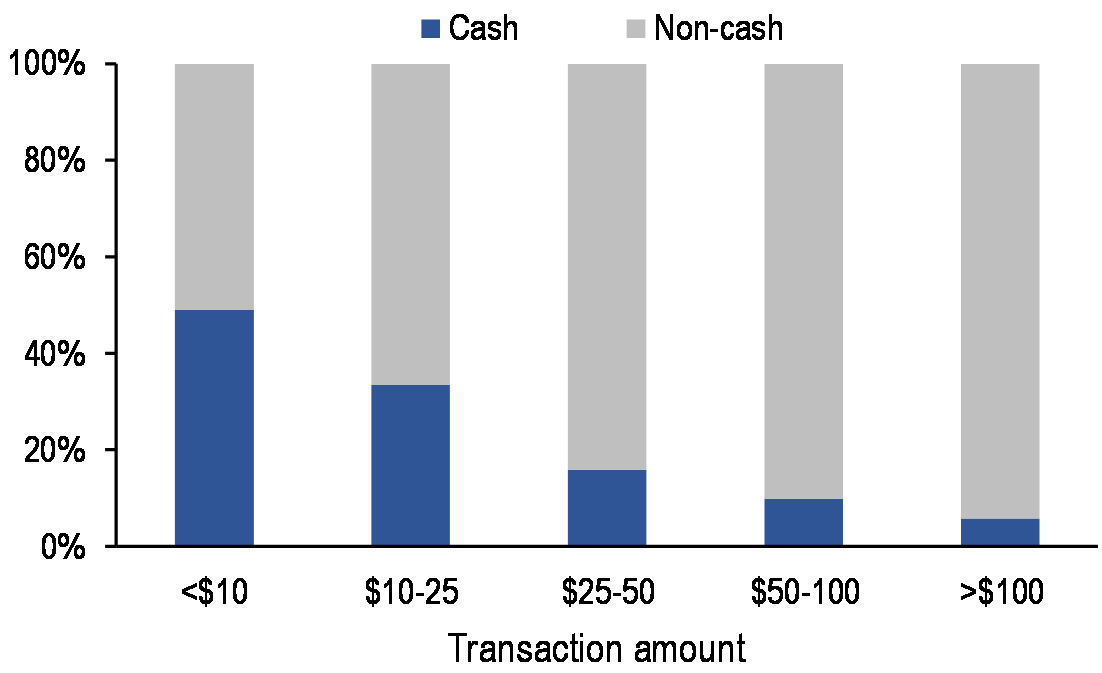
Note: From the 2019 Federal Reserve Diary of Consumer Payment Preferences2.Source: J.P. Morgan, SFFRB
Figure 2: Though we typically associate “money” with sovereign issuers, the vast majority is provided by private sources
Global public money, defined as the monetary base (MB), versus private money, defined as M2 net of MB; $trn

Note: Includes the United States, Euro Zone, Japan, U.K., Australia, Switzerland, Sweden, and Canada (developed markets) as well as China, Brazil, India, and South Korea (emerging markets). Converted to US dollar equivalents on a quarterly basis.Source: J.P. Morgan, Haver Analytics
From this we can conclude that private money derives its value from two principle sources. The first, to paraphrase The role of central bank money in payment systems43 is the expectation that it is functionally exchangeable on demand for public money at par. In practice, these exchanges are small relative to aggregate payment volumes for the reasons outlined above. In that sense, private money is a form of leverage in the payment system—the money multiplier. A second, and conceptually related, benefit is the use of private money to cure liabilities of persons and corporations to the central government—e.g., taxes. The choice of what means of payment are accepted for this purpose is a form of official endorsement that makes private money that receives this designation quite valuable indeed.
Why are banks entrusted to serve such a critical function? Because they are highly regulated. This allows central authorities to control money issued through this channel via a combination of constraints on their funding and activity. In the past this was primarily accomplished via statutory reserve requirements, which limited the aggregate size of the banking system. These days there are a number of other potentially binding constraints on bank activity, including liquidity requirements (which we will come to later), resolution planning, stress testing, and leverage and “bigness” limits (i.e., GSIB, SLR). Subjecting themselves to this web of regulations allows banks to obtain federal insurance for eligible deposits. However, this is only a partial solution: roughly 45% of deposits at the 10 largest US banks, for example, are not covered by the FDIC. In this sense, the substitutability of private for public money is maintained in large part by their credit worthiness, which among other things, owes largely to regulatory constraints and regulatory monitoring by federal authorities.
The privilege of acting as a bank in this way also generally comes with obligations to safeguard the financial system from fraud and abuse. This is not a small ask: a recent study by Lexis Nexis44 found that US financial firms spend more than $26bn annually on AML and KYC compliance. Applying similar regulations to stablecoin issuers and other fast payment systems, particularly those designed to facilitate cross-border transactions, remains a key area of focus for government officials (see e.g., Investigating the impact of global stablecoins, Bank for International Settlements, 10/18/19). Implementing AML protections that are up to international standards would likely require some limits on anonymity and the openness of a given network. Some issuers may have philosophical objections to closed and/or non-anonymous networks, but there are no fundamental barriers to such features.
In principle this means that a private stablecoin issuer acts as a de facto bank in certain respects. Not a traditional bank, to be sure, but a form of narrow bank. That is because the value of their liabilities (coins) are in most cases fully backed by a pool of high-quality collateral. However, they would perform some similar functions: providing liquidity via maturity transformation and facilitation and settlement of payments. In that sense, it would not be surprising for any stablecoin issuer who reaches a certain scale to be subject to some form of bank regulatory requirements. This could substantially increase operating costs, which the income from a reserve account would not necessarily be sufficient to cover.
Is the underlying technology ready for global scale?
A second oft-cited constraint on the potential growth of stablecoins is the efficiency of the underlying DLT implementation. In practice, the computing power required to validate transactions in cryptocurrencies spans a very wide range. This primarily has to do with the process of “mining,” in which transactions generate complex mathematical problems to be solved by a network of miners (e.g., proof-of-work). These solutions are the key to confirming the authenticity of transactions and maintaining the integrity of the ledger. It is, however, quite computationally expensive, particularly when the difficulty of these problems increases over time to limit the supply of new coins, as is the case with many cryptocurrencies.
At this point, researchers have produced estimates of the power required to process transactions in the two largest cryptocurrencies: Bitcoin and Ethereum. Though the latter is much more efficient, both are orders of magnitude greater than some traditional, centralized, account-based payment systems. For example, each Bitcoin transaction requires more than 600 kWh of electricity to validate, which given the current pace of activity, the overall network likely consumes roughly 50-70 TWh/year to operate annually—roughly the same as the country of Austria. Ethereum is likely more than 20x less demanding, but still orders of magnitude more power-hungry than the VISA network, for example, which can process more than 16,000 transactions for each transfer of Ethereum.
Figure 3: Using currently popular technology, migrating a significant fraction of global e-commerce, and especially broader retail payments would put significant strain on energy resources …
Annual power required to operate a DLT-based retail (RHS) and e-commerce (LHS) payment system by country, based on 2018 figures with fraction of total energy production indicated along each market; both axes in TWh/yr
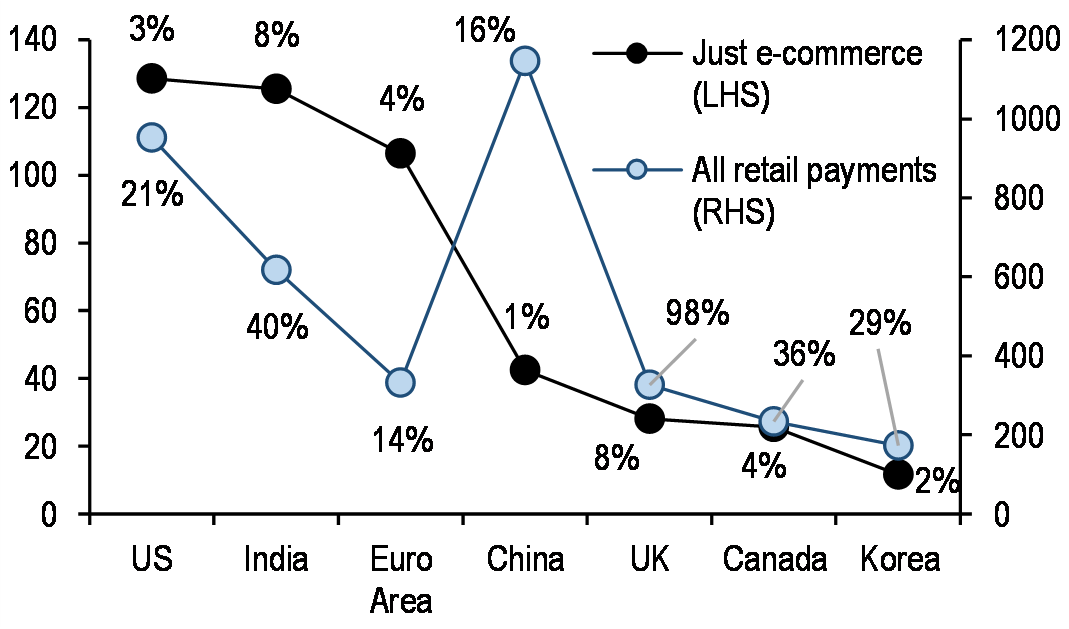
Note: Transaction counts from BIS Red Book data for 2018, electrical generation data from the BP Statistical Review of World Energy 2019. E-commerce payments assume gross transaction volumes from a range of official sources for 2018 (see UNCTAD estimates and references therein for the prior year), assuming the number of transactions scales with value. Based on estimated power usage per transaction for Ethereum.
Source: J.P. Morgan, BP, BIS, Digiconomist.com, UNCTAD
Figure 4: … and even if technological solutions are found, the rapid growth of retail payments relative to global electrical production suggests ongoing improvements will be required
Volume of retail payments activity (count of transactions) and annual power generation (in TWh/yr) for major economies active in e-commerce; normalized to 100% as of 2012
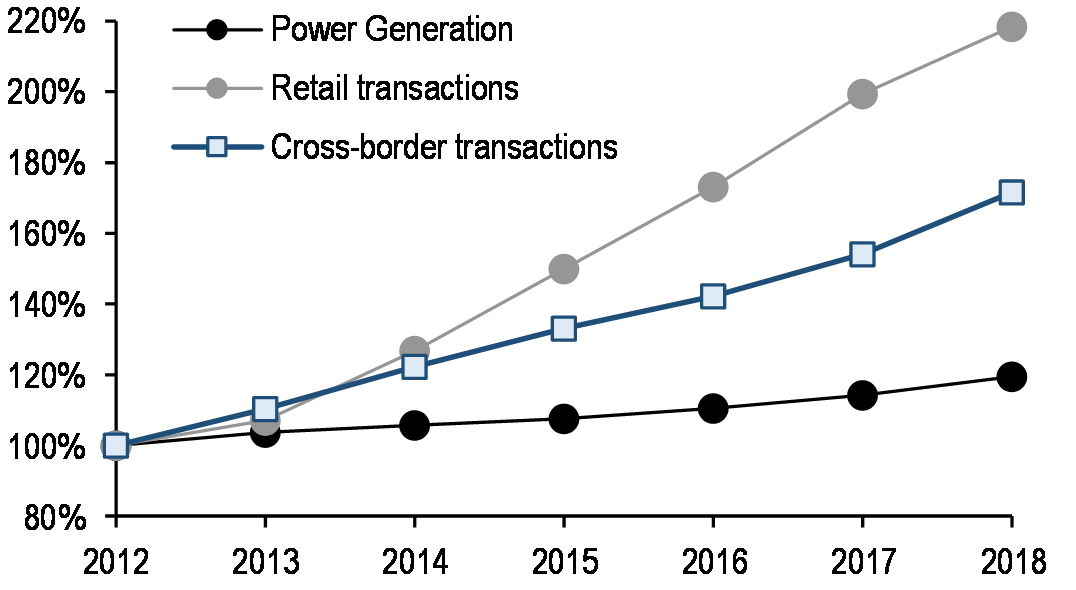
Note: Transaction counts from the BIS Red Book, and includes retail and fast payments. Electrical generation data from the BP Statistical Review of World Energy 2019. The sample includes the US, China, Euro Zone, India, U.K. Canada, and Korea. Cross-border transactions from BIS Red Book SWIFT global aggregate instructions sent.
Source: J.P. Morgan, BP, BIS
The Ethereum network may draw the same power as the country of Bolivia, but it is also not nearly as active as current retail payment systems. BIS Red Book Data, for example, suggest that China, the US, India, and the Euro Zone generated 41, 34, 22, and 12 billion retail transactions last year, respectively—hundreds of times the activity on the Ethereum and Bitcoin transactions networks over the same period. If we apply this scaling, it suggests that if retail payments were migrated to private stablecoins using a validation protocol comparable in efficiency to Ethereum, it would consume a significant fraction of current electrical production in most major countries (Figure 3). Even if we restrict this to e-commerce transactions, which make up 10-20% of retail payments in most jurisdictions, we are still talking about a noticeable fraction of total electrical production. Further, over the past few years global retail payment volumes and cross-border transactions have grown much faster than energy production (Figure 4), which suggests continued improvements will likely be required. And of course if we were to assume Bitcoin-like energy consumption the requirements are completely infeasible.
In this sense, design decisions regarding the protocol that drives a given stablecoin are a key consideration in its potential to achieve global scale. One approach is to prioritize truly distributed maintenance of the ledger, while another is to rely on a semi-private network with a small group of trusted nodes to validate transactions (e.g., proof-of-stake). There are benefits and costs to both. Open, truly distributed ledgers are resilient and transparent with few barriers to entry, but are also necessarily computationally intensive to deter abuse, such as denial of service attacks or spamming. There is also a risk that new technology (e.g., quantum computing) renders existing cryptography obsolete, leading to even more demanding proof-of-work requirements—a vicious cycle resulting in ever less energy efficient protocols. The latter is much more efficient but introduces operational and cybersecurity risks in the form of key trusted nodes. There are also some intermediate solutions such as sharding, in which the ledger is subdivided and validation is localized to parallelize computations and reduce communications overhead. We cannot say for certain a truly distributed, open network cannot achieve global scale, but the required improvement over current technology is imposing. Thus at the moment, we think it fair to say that global stablecoins are more likely to rely on networks that are at least somewhat centralized.
Where will the collateral come from?
Finally, we consider the assets backing stablecoins. Though commodity and on-chain tokens have been produced and found limited applications, the vast majority of interest is in those tied by fiat currency. In the case of what is currently proposed for Libra, this consists of a mix of high credit quality short-term government debt and bank deposits. That said, it is not clear that either can be sourced in sufficient size to support stablecoins with global reach and scale.
We begin with government bonds. Much has been made of the explosion of sovereign debt over the past few years. However, not all of those securities are freely floating in the market. The combination of growing FX reserves among emerging economies and large scale asset purchases in developed markets means a substantial fraction are locked up on central bank balance sheets. If we focus on G4 currencies, for example, these official sector holdings total nearly half of the overall stock of central government debt outstanding (Figure 5). In fact, the free float remaining has declined since peaking in 2010, despite some recovery in recent years as asset purchases have tapered off. It is also important to note that a non-trivial fraction of short-term securities, especially in USD, is locked in money market funds (MMFs).
Then there is the additional problem of negative yields. As we discussed in our previous publication on the topic, it is unclear how persistent net losses will affect Reserve Account holdings for Libra and other stablecoins. This is not an isolated problem: looking across major currencies, only USD is a material source of positive-yielding free float short-term government securities (Figure 6). Despite their recent assurances to the contrary, there are no guarantees that the Fed will not eventually adopt a negative interest rate policy—in fact, markets are pricing a reasonably high likelihood of just such an eventuality (see Interest Rate Derivatives, US Fixed Income Markets Weekly, J. Younger et al., 27 September 2019).
Figure 5: Thanks to large-scale asset purchases across developed markets, the free float of G4 central government debt has not grown in more than five years …
USD, EUR, JPY and GBP central government securities separated into those held by central banks (FX reserves as well as QE-related purchases) and free float (LHS; $trn) and the fraction that is free floating (RHS; %), all converted into US dollar equivalents

Source: J.P. Morgan, Haver Analytics, NYFRB, ECB, BoE, BoJ
Figure 6: … and Treasury Bills and short nominal coupons are the only clear source of positive yield short-term government securities
Government securities with <1yr remaining maturity by currency, split into positive and negative yield free float, central bank holdings (FX reserves and QE-related holdings) and money market fund assets as of August 2019; $bn

Note: We assume 15% of FX reserve holdings across currencies are <1yr remaining maturity coupon securities. ECB holdings based on J.P. Morgan estimates, while NYFRB, BoE, and BoJ data are more granular.
Source: J.P. Morgan, Crane’s, NYFRB, ECB, BoJ, BoE, IMF COFER
One solution would be to pass losses along to token holders. This would, however, provides a strong disincentive since bank deposits have generally not followed policy rates into negative territory. In other words: why hold negative-yielding stablecoins when your old private fiat money is offering zero or above? Alternatively, this could lead to the imposition of traction costs, which would similarly reduce the incentive to hold stablecoins. Thus, negative yields, particularly if they occur unexpectedly, introduce risks that for a stablecoin with global scale would constitute a significant threat to financial stability. Suddenness in the move to negative policy rates is, in fact, the rule rather than the exception thus far—as evidenced by the experience of Europe and Japan (Figures 7 and 8).
Figure 7: The options market in Europe strongly discounted the risk of negative rates until a few months before they emerged …
EUR 1Yx1Y zero-strike receiver swaption deltas compared to EUR 1Yx1Y swap yields and NIRP risk inferred from ATMF 1Yx1Y swaptions; %
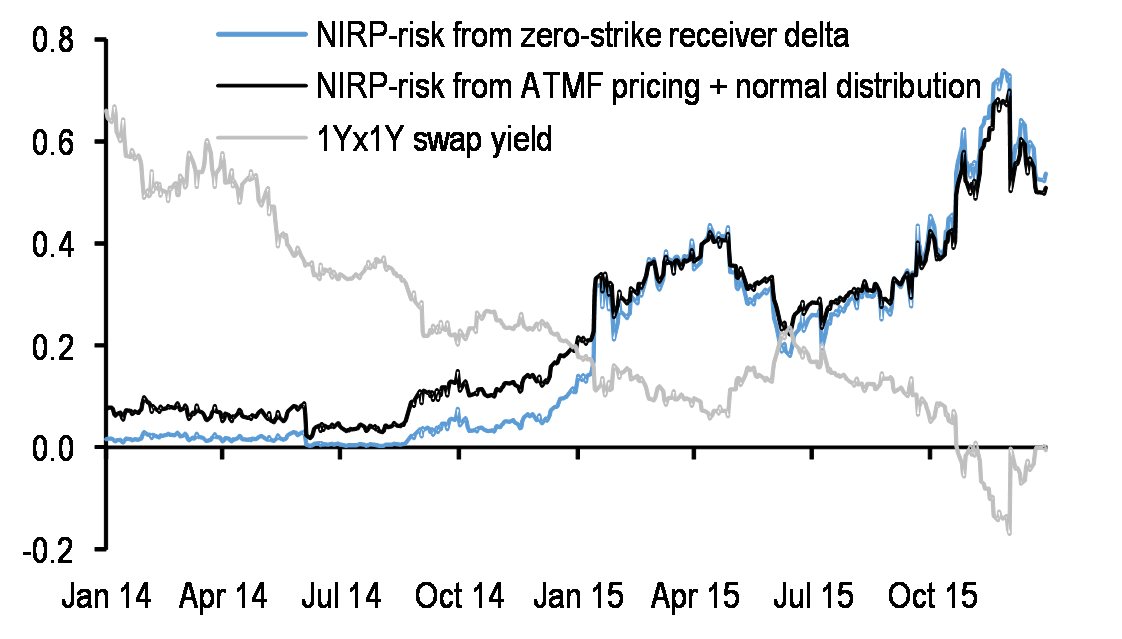
Source: J.P. Morgan
Figure 8: … and in Japan, the risk was strongly discounted right up until the breach occurred
JPY 1Yx1Y zero-strike receiver swaption deltas compared to EUR 1Yx1Y swap yields and NIRP risk inferred from ATMF 1Yx1Y swaptions; %

Source: J.P. Morgan
One way to avoid negative yields on Reserve Account assets is to focus on high-quality bank deposits rather than government bonds. As noted above, private money is generally exempted from negative policy rates. However, this is easier said than done. The difficulty lies primarily in bank liquidity requirements. In particular, systemically important banks are required to hold high-quality liquid assets (HQLA) to cover potential stressed outflows. These outflows are assigned different weights depending on their characteristics, with stable retail deposits assumed to be fairly sticky (~3% runoff) but operational (i.e., those used for cash flow management transactional activity; ~25%) and especially non-operational wholesale deposits (i.e., those not used primarily for operations; ~60%) are assumed to be much more flight-prone.
We think it likely that stablecoin reserve deposits at traditional banks would fall into the non-operational wholesale category. That means consumer inflows into new tokens would constitute a conversion of stable retail funding into non-operational wholesale deposits. The additional HQLA required could have a material impact on bank profitability. Imagine, for example, a canonical commercial bank with a typical funding mix: 40% retail, 20% operational wholesale, and 15% non-operational wholesale deposits, with the remaining 25% coming from secured wholesale sources. Were a quarter of those depositors to move their savings into a new stablecoin, and those inflows were rolled back into the banking system rather than government securities, the bank in question would need to increase their holdings of HQLA by roughly 40%—presumably at the expense of wider spread lending such as loans. To the extent this becomes a systemic shift it would likely contract overall availability of credit (by ~8% in our example) and weigh on bank profitability.
In practice, such punitive treatment is a strong disincentive to adding—even retaining—non-operational wholesale deposits. This constraint is particularly acute in the US, where large banks are closest to the minimum required holdings of HQLA given their funding mix (Figure 9). As a result, though US banks have grown meaningfully over the past two years, most of that funding has come in the form of retail and secured wholesale sources (Figure 10). There has in fact been a concerted effort among GSIBs to actively shed non-operational funding for precisely this reason (see Deposit non grata, A. Roever et al., 27 Feb. 2015). Given these regulatory constraints, we think stablecoin issuers may find it hard to source deposits at banks for which liquidity constraints are or could become binding.
Figure 9: Among G4 economies, large commercial banks in the US are most liquidity constrained…
Aggregate LCR by jurisdiction as of 2Q 2019; %

Note: Includes US GSIBs, the 10 largest Euro Zone banks, the four largest public Japanese banks, and the three largest U.K. banks.
Source: J.P. Morgan, Pillar 3 Disclosures
Figure 10: …which is reflected in their strong preference to source new funding from retail and secured wholesale sources while specifically avoiding non-operational wholesale deposits
Change in unweighted outflows by category for US GSIBs, 3Q 2019 versus 2Q 2017; $bn
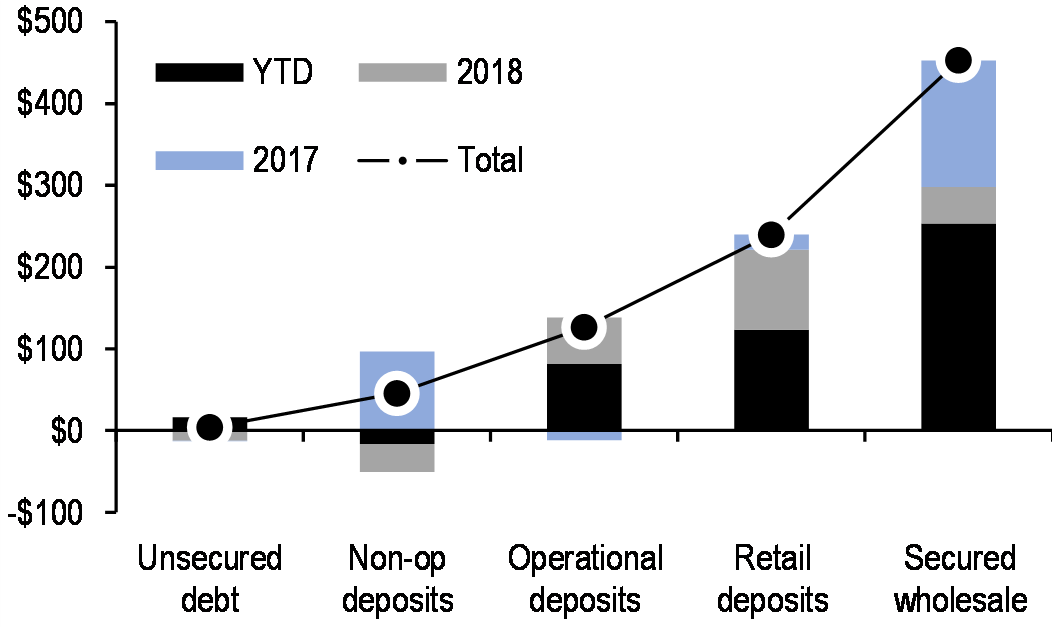
Source: J.P. Morgan, Pillar 3 Disclosures
That is not to say stablecoins could not find jurisdictions in which it is easier to source deposits for reserves. For example, Japan and the U.K. are much less constrained by liquidity requirements than the US and Europe. This all suggests a successful stablecoin would likely be backed by a mix of short-term USD government securities, which are positive yielding with significant free float, as well as JPY and GBP bank deposits. This is in principle a scalable proposition, but it does limit the extent to which a multi-currency reserve could be diversified in practice.
Conclusions
What are we to conclude from this exercise? The world is absolutely ready for private money—most of what we think of as fiat currency is already privately issued. However, the likely regulatory and compliance required for stablecoins to, for example, be accepted as payment for liabilities to the central government would be significant. Sourcing collateral for a global stablecoin will likely be a challenge, but is absolutely achievable, and will likely require a preference for bank deposits over government securities in some jurisdictions. That said, the risk that USD policy rates in particular turn negative is a significant risk to the stability of asset-backed designs. Energy requirements, however, remain a potentially significant limitation. Absent substantial and ongoing improvements in efficiency, it will be very difficult for truly distributed stablecoins to achieve global scale, in our view. Reliance on a central authority for validating transactions and maintaining the integrity of the ledger is a possible solution, but does not offer the same benefits as a true DLT.
Joshua Younger AC
joshua.d.younger@jpmorgan.com
J.P. Morgan Securities LLC
Munier Salem
munier.salem@jpmorgan.com
J.P. Morgan Securities LLC
Henry St John
henry.stjohn@jpmorgan.com
J.P. Morgan Securities LLC
Is the cryptocurrency market maturing?
- The market capitalization of cryptocurrencies recovered from around $125bn a year ago to around $235bn, with Bitcoin increasing its dominance by accounting for nearly two-thirds of the total.
- Once ‘fake’ trading volumes such as wash trades are adjusted for, participation by institutional investors is now significant.
- The crypto market continues to mature with the introduction of new contracts on regulated exchanges, most recently with the launch of options on futures contracts in regulated exchanges.
- The gap that opened up between Bitcoin’s market price and our estimate of its “intrinsic” value has narrowed substantially, largely due to declines in the market price.
- Its market value continues to trade above our estimate of intrinsic value, suggesting some downside risk remains.
Cryptocurrency market expands again in 2019, while bitcoin dominance has continued to increase
The market value of cryptocurrencies has recovered in 2019 to around $235bn at the time of writing. This follows the severe price declines in 2018, when the market value of cryptocurrencies had declined to around $125bn in early 2019 from a peak of $800bn in early 2018 (Figure 1). Moreover, the share of Bitcoin of the total cryptocurrency market capitalization has continued to increase. It rose from an all-time low of just one third in early 2018 to just over half in early 2019, and has continued to increase to nearly two thirds currently. This suggests that after suffering disproportionately during the 2018 correction phase, other cryptocurrencies have also failed to capitalize on the recovery in 2019.
Figure 1: Cryptocurrency market cap
In $bn
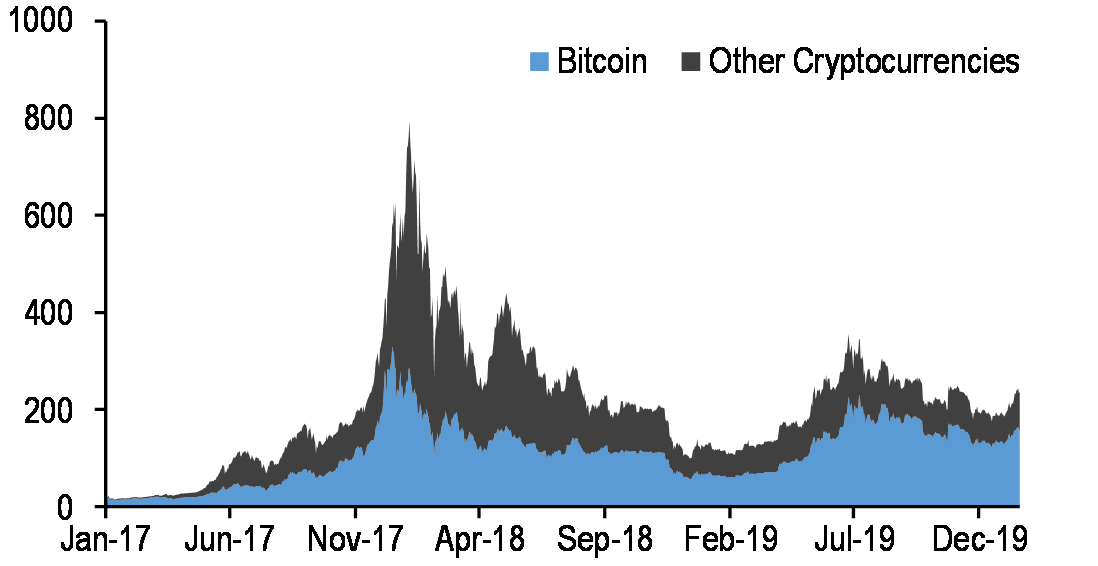
Source: Coin.dance, J.P. Morgan
Participation by financial institutions is increasing, once ‘fake’ volume is accounted for
The past year has seen a rather sharp increase in reported trading volumes of Bitcoin and other cryptocurrencies. These reported volumes on crypto exchanges based on data collected by coinmarketcap.com suggest that monthly average volumes rose from an average of $185bn in 2018 to more than $500bn in 2019, and a peak of nearly $725bn in May 2019. This compares to previous peak volumes in Dec17 and Jan18 of $420bn. And this development came against a backdrop of the market cap of bitcoin in May 2019 averaging half of its average in Dec17. While a substantial part of the increase in volumes in dollar terms reflects an increase in the market value of bitcoin and other crypto currencies, the volumes in bitcoin terms are also significantly above their previous peaks.
Taken at face value, this would suggest a dramatic increase in cryptocurrency activity. But concerns have increasingly been expressed over how authentic the reported volumes really are. These reported volumes are significantly higher than the average monthly volume of aggregate bitcoin transactions of $235bn per month suggested by looking at daily average transaction sizes and the number of transactions based on data by Bitinfocharts.com, including transactions beyond crypto exchange trading. And work by Bitwise, a cryptocurrency asset manager, in a submission to the SEC45 as part of an application for a bitcoin ETF suggested that bitcoin trading volumes on many cryptocurrency exchanges are significantly overstated by ‘fake’ trading, e.g., exchanges reporting volume of trades that never took place or via wash trades, and that genuine trading volumes could be around 5% of the reported total. Similarly, the Blockchain Transparency Institute publishes market surveillance reports and estimated in April 201946 that less than 1% of reported volume for some exchanges represented real trades. While there had been some improvement by September, if these estimates of the proportion of real trades are correct, i.e., that only around 5% of trading is genuine, that would imply that the genuine volumes of Bitcoin trading on cryptocurrency exchanges in May were around $36bn, rather than the reported $725bn according to coinmarketcap data, and that the monthly average for 2019 was around $25bn rather than $500bn.
An important implication from this lower level of true trading activity, beyond the fact that the actual market size is markedly lower than reported numbers would suggest, is that the importance of the listed futures market has been significantly understated. Indeed, the report by Bitwise credits the traded futures as an important development in allowing short exposures that enabled arbitrageurs to properly engage in arbitrage, and that the futures share of spot bitcoin volumes increased sharply in April/May of 2019. Looking at aggregate volumes on both the CME and CBOE futures contracts (the latter have since been discontinued from mid-2019), we estimate around $12bn of traded volume on these two futures exchanges in May. Indeed, the $12bn of bitcoin futures trading volume in May also represented a significant increase on the April’s $5.5bn and a 1Q19 monthly average of $1.8bn, suggesting there was a genuine rise in trading volume even if the total volumes on cryptocurrency exchanges was likely vastly overstated. In addition, May saw trading volumes of around $18bn on the perpetual swap contract on the Bitmex exchange. Taking together these contracts, volumes were close to the genuine volumes of Bitcoin traded on cryptocurrencies.
This overstatement of trading volumes by cryptocurrency exchanges, and by implication the understatement of the importance of listed futures, suggests that market structure has likely changed considerably since the spike in Bitcoin prices in end-2017, with a greater influence from institutional investors.
Crypto market continues to mature
A number of developments over the past year has seen the crypto market mature. The most recent is the launch of CME bitcoin options on futures on Jan 13th, 2020, where the option contracts are based on the underlying CME cash-settled bitcoin futures contract. Volumes on the first day were reportedly $2.2mn, and had increased to nearly $10mn by the second week of trading.
This is not the first Bitcoin option contract, as there are already contracts actively traded on Derebit and LedgerX, but the CME option on futures contracts has been widely anticipated given the dominance of CME in trading bitcoin futures in regulated exchanges. ICE and Bakkt, who introduced physically settled option monthly futures contracts in September 2019, had also introduced option contracts in December 2019 that settle on the physically delivered futures contract. But while the ICE and Bakkt launch represented the advent of centrally-cleared bitcoin options on a regulated US exchange, a major milestone for the crypto market, the option volumes and open interest have so far been rather small. Even the futures contracts traded at ICE/Bakkt, also launched on December 9, 2019, have failed so far to achieve significant volumes. So far, any decent bitcoin option activity has been focused on less regulated exchanges, primarily Derebit and to a lesser extent LedgerX.
The combined option open interest at Derebit/LedgerX is decent at around $500mn, in dollar terms around half of the futures open interest we see at Bitmex and CME together (Figure 2). This suggests that there is genuine demand for non-linear institutional trading products in crypto markets.
Figure 2: Aggregate open interest across CME and Bitmex Bitcoin contracts
$mn
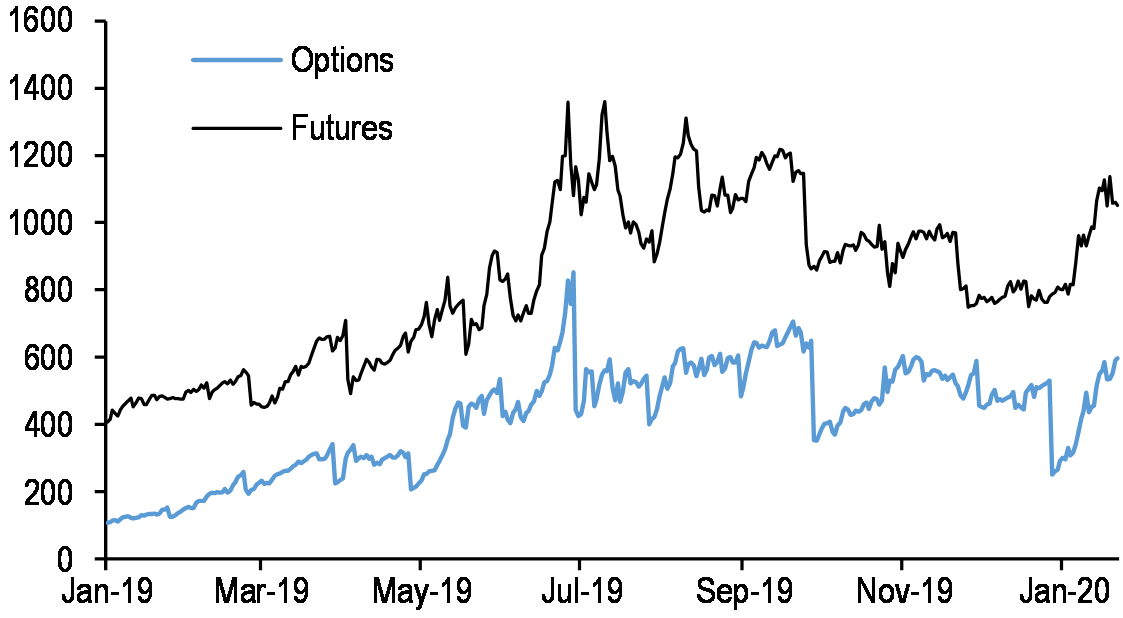
Source: CME, Skew.com, J.P. Morgan
The implied vols behind these bitcoin option contracts have been hovering around the 70% mark, as Bitcoin prices are typically 4-5 times more volatile than equities. The implied to realized vol ratios have been hovering around the x1.2 mark (Figure 3), in line with what we see on average across traditional asset classes.
Figure 3: Implied to Realized volatility ratio for Bitcoin
Volatility ratio for 1 month and 3 months
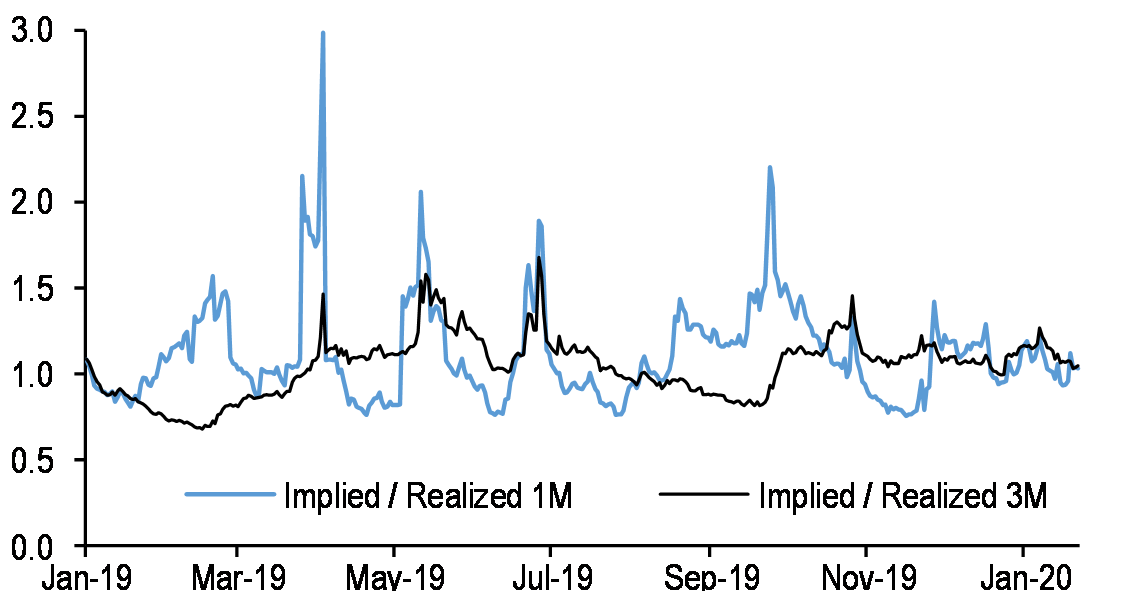
Source: Skew.com, J.P. Morgan
Bitcoin prices have corrected much of the gap versus intrinsic value
What about Bitcoin’s intrinsic value more broadly? We argued during last year that the sharp rise in the market price of Bitcoin from early May 2019 had seen a marked divergence in the price relative to its intrinsic value, and that this carried some echoes of late 2017 (F&L, May 17, 2019). How has this divergence developed since then?
To answer that question, we revisit our previous work on estimating this intrinsic value. Defining an intrinsic or fair value for any cryptocurrency is clearly challenging. Indeed, views range from some researchers arguing that it has no fundamental value, to others estimating fair values well in excess of current prices.
The approach we took to estimate a quantifiable intrinsic value for Bitcoin was to effectively treat it as a commodity and base it on the marginal cost of production. Mining cryptocurrencies consumes electric power, which results in a real-world cost incurred in nominal currency terms. In principle, a market price above that cost should induce miners to increase resources to mine coins, bringing the cost of mining higher until the marginal cost approaches the market price, while a price below that cost should induce higher cost producers to exit the market lowering the overall cost until it again approaches the marginal cost. We followed a methodology adopted by Hayes (2018) 47, which first estimates the daily cost of production as a function of the computational power employed, cost of electricity, and energy efficiency of hardware. It then divides the daily cost of production by the number of bitcoins produced daily to get a marginal cost of production per Bitcoin.
In order to estimate this marginal cost of production for Bitcoin at an aggregate level, we use daily data on market price, hash rate and difficulty from bitinfocharts.com, and use the assumptions employed by Hayes (2018) on historical efficiency of mining hardware and electricity costs ($0.135 per kWh) up to February 2018. We then use estimates from the Bitcoin Electricity Consumption Index allowing for a gradual increase in efficiency of mining hardware and decline in electricity cost (to $0.05 per kWh). There had been some deterioration in the implied efficiency of mining hardware the first half of 2019 from 0.115 Watts per GH/s to 0.135, potentially due to less-efficient mining rigs shut down in 4Q18 as prices dropped having been bought second hand and moved to lower energy cost locations. But over the course the second half of 2019 efficiency increased to 0.078 W per GH/s.
The market price and our updated estimate of the intrinsic value of Bitcoin are shown in Figure 4, and the ratio of actual to intrinsic price in Figure 5. Our intrinsic value estimate has been gradually rising in 2019 consistent with the rising hash rate and consequently difficulty, though the pace of increase was somewhat greater in 1H19 amid a decline in mining efficiency than in 2H19 when efficiency again improved.
Figure 4: Bitcoin market price and intrinsic value
$; intrinsic value estimated using the cost of production approach following Hayes (2018)
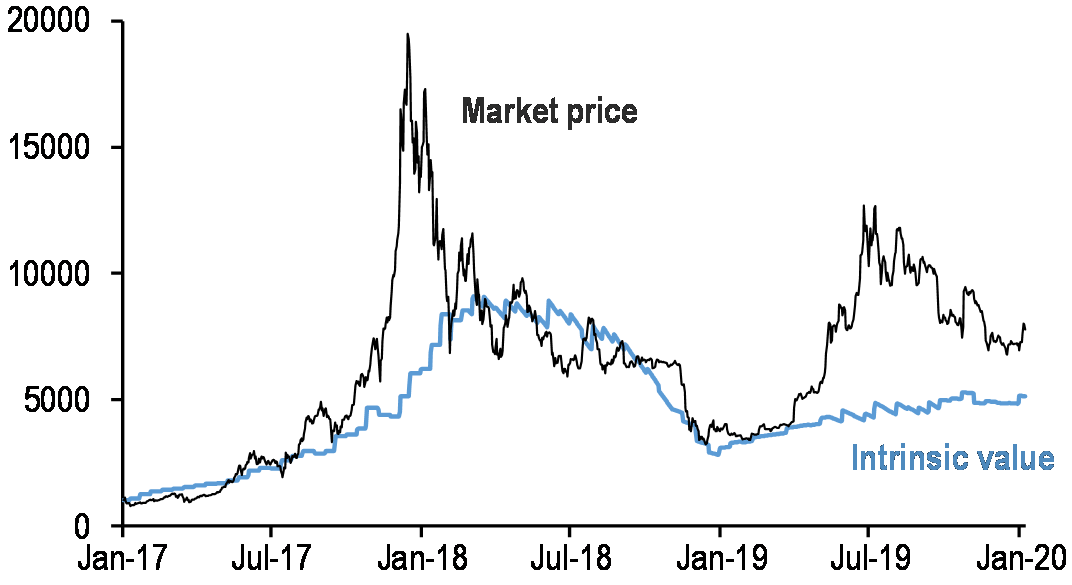
Source: J.P. Morgan
Figure 5: Ratio of Bitcoin market price to intrinsic value
Intrinsic value estimated using the cost of production approach following Hayes (2018)
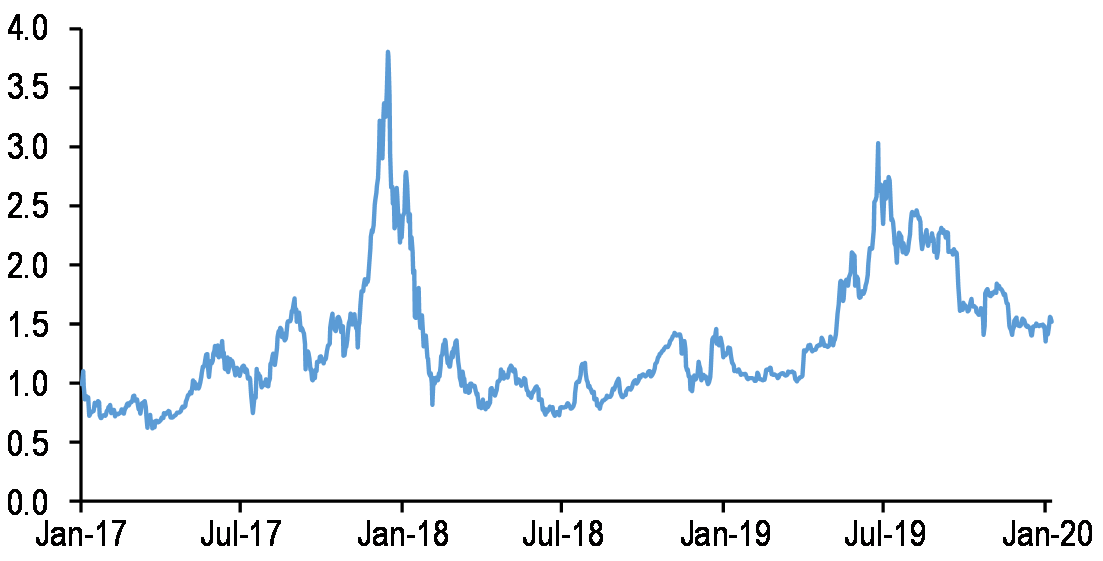
Source: J.P. Morgan
We argued in May last year that the sharp rise in the market price relative to its intrinsic value from early May 2019 carried some echoes of the spike market prices in late 2017, when this divergence was resolved mostly by a decline in actual prices even as intrinsic values also gradually increased as mining profitability encouraged new entrants. This is indeed what appears to have happened in the second half of 2019, albeit more gradually than end-2017/early 2018, as the market price has declined by nearly 40% from its peak while the intrinsic value has risen by around 10%. Moreover, the gap has not yet fully closed, suggesting some downside risk remains.
What about the positioning backdrop? To infer positioning in bitcoin futures, we use our open interest position proxy methodology that we also apply to other futures contracts, where we look at the cumulative weekly absolute changes in the open interest multiplied by the sign of the futures price change every week. The rationale behind this position proxy is that when there is a price increase, the net long position of spec investors increases, also with the magnitude of the increase determined by the absolute change in the open interest. It does not matter whether the open interest rises or falls as the net long position can increase either via fresh longs (increase in open interest) or a reduction of previous shorts (reduction in open interest). And vice versa. When there is a price decrease, the net long position of spec investors decreases also with the magnitude of the decrease determined by the absolute change in the open interest. It does not matter whether the open interest rises or falls as the net long position can decrease either via fresh shorts (increase in open interest) or reduction of previous longs (reduction in open interest).
Our position proxies for the CME and Bitmex futures contacts are shown in Figure 6, and they do not yet give a consistent message of positioning having turned oversold despite the nearly 30% price declines from their mid-2019 peak. The position proxy based on open interest in the Bitmex perpetual swap has shifted from neutral to short, while the position proxy on CME contracts suggests some increase in net longs.
Figure 6: Our Bitcoin position proxy based on open interest in Bitmex perpetual swap and CME Bitcoin futures contracts
$mn
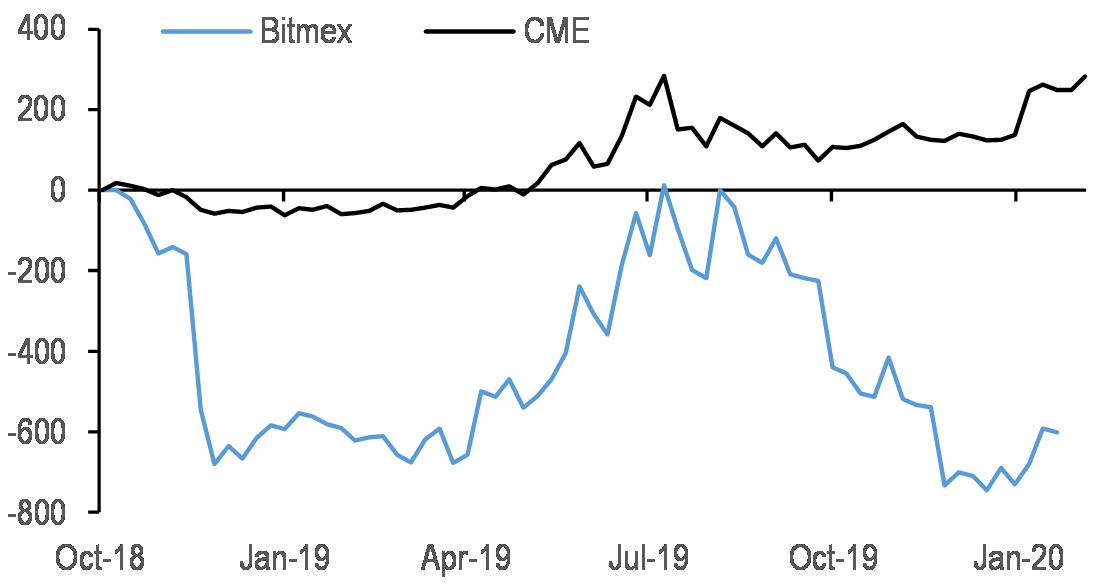
Source: Bloomberg, Skew.com, J.P. Morgan
Nikolaos Panigirtzoglou AC
nikolaos.panigirtzoglou@jpmorgan.com
J.P. Morgan Securities plc
Mika Inkinen AC
mika.j.inkinen@jpmorgan.com
J.P. Morgan Securities plc
Cryptocurrencies for portfolio diversification: Struggling to prove uniqueness
- As the global economy enters year 12 of its longest-ever expansion, there is no shortage of risks to hedge, ranging from the somewhat familiar (recession, inflation, military conflict, trade war, currency war) to the newer (pandemics, climate change catastrophes, systemic cyberattack).
- Many of these events have occurred with sufficient frequency over the past 50 years of modern finance that investors and risk managers think they know how best to hedge via defensive assets such as Treasuries, the Yen, Gold and Quality stocks.
- With so many historical episodes backing the usefulness of traditional assets for hedging extreme macroeconomic environments and geopolitical flashpoints, it might seem creative but pointless to explore alternatives like cryptocurrencies.
- The appeal of crypto assets has been their low correlation to traditional asset classes, which has usually improved portfolio efficiency.
- But even miniscule allocations remain impractical as long as lack of legal tender status limits their transactional use and in turn their liquidity. Crypto assets are also still failing to rise as consistently as Bonds, the Yen and Gold when Equities incur large drawdowns.
- Bonds may lose their ability to hedge Equity portfolios over the next several years as Japanization pins rates near 0% and limits capital gains from falling yields when stocks decline. Thus less-constrained markets like the Yen and Gold should form part of long-term hedges. Cryptocurrencies should be added to this list too, not because they have demonstrated the same hedge effectiveness as traditional markets but because they can uniquely hedge a yet-unseen environment entailing simultaneous loss of confidence in the domestic currency and its payments system.
Abundant risks, familiar hedges
As the global economy enters year 12 of its longest-ever expansion, there is no shortage of risks to hedge, ranging from the somewhat familiar (recession, inflation, military conflict, trade war, currency war) to the newer (pandemics, climate change catastrophes, systemic cyberattack). Many of these events have occurred with sufficient frequency over the past 50 years of modern finance that investors and risk managers think they know how best to hedge via defensive assets. Typical trades include: 1) buying Treasuries (or any DM government bond ex peripheral Europe), funding currencies (USD versus EM FX, JPY versus USD, CHF versus EUR), Gold and Quality stocks for any event that could depress global growth; 2) buying Oil or overweighting oil proxies (Energy Equities, US HY Energy Credit, Russian ruble) for any threat to energy production; and 3) overweighting inflation-linked bonds and possibly Commodities on any upside risk to inflation (note that Commodities hedge price pressures based on raw materials, but not those based on labor costs).
With so many historical episodes backing the usefulness of traditional assets for hedging extreme macroeconomic environments and geopolitical flashpoints, it might seem creative but pointless to explore alternatives like cryptocurrencies. In a multi-asset context, the unique appeal of cryptocurrencies is not so much their expected returns, which have averaged an extraordinary 100% per annum over the past five years, but with such high volatility that their risk-adjusted returns are similar to Equities (Figures 1 and 2). The attraction should be their contribution to portfolio efficiency (the improvement in risk-adjusted returns) that might come from their low correlation to other financial assets whose prices are more closely tied to fluctuations in the business/corporate profits cycle, the monetary policy phase, or fiscal/regulatory policy. As private money produced and exchanged outside the regulated financial sector, cryptocurrencies could both retain this low return correlation to other assets indefinitely, but also insulate investors and companies from a collapse in a country’s payments systems. That thunderdome scenario probably sounds extreme in developed economies, but it may become reality in a range of small economies that political scientists call failed—or failing—states (Figure 3).
Figure 1: The hype cycle – Bitcoin has traced a steeper ascent and decline than Gold in 1970s, Nikkei in 1980s, and Nasdaq in 1990s
Asset values indexed to 100 in Year 1 of regime change, chosen as 1971 for gold, 1986 for Nikkei, 1995 for Nasdaq and 2013 for Bitcoin

Source: J.P. Morgan
Figure 2: Cryptocurrencies’ risk-adjusted return used to be materially higher than that of traditional asset classes but now is comparable to that of Equities and Commodities
Rolling 12-mo returns divided by rolling 1Y realized volatility
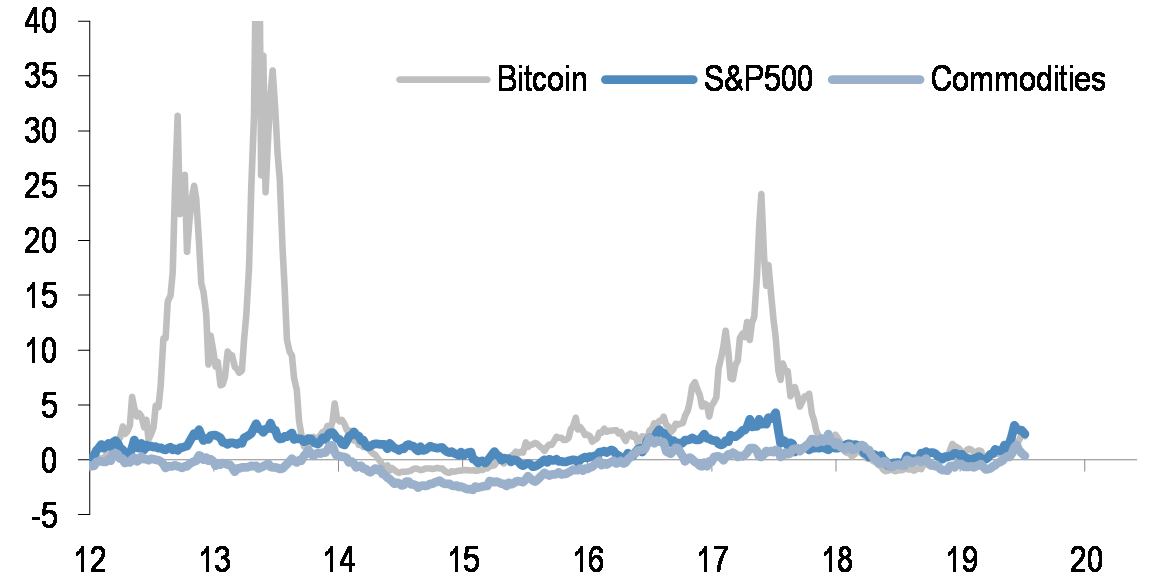
Source: J.P. Morgan
Revisiting cryptocurrencies advantages and limitations
Previous JPM research reports over the past few years have explored cryptocurrencies’ diversification benefits and concluded the following:
- Despite their extraordinary standalone volatility, crypto assets still raise the efficiency of a multi-asset Equity and FICC portfolio (the Sharpe ratio, or return per unit of risk) due to high historical returns and low cross-asset correlations;
- But efficiency gains exist but are probably overstated since crypto assets’ early-year returns were so above production costs that they seemed bubble-like;
- And even miniscule exposure of 1% is impractical for institutional investors and corporates since crypto assets’ lack of legal tender status will probably always limit their use as a medium of exchange and therefore liquidity (a medium of exchange that agents are not obligated to accept is an inferior medium in most transactions);
- Strangely, crypto assets’ medium-term contribution to portfolios has provided less hedge protection than traditional defensive assets like Treasuries, Gold or the Yen during the most extreme equity market drawdowns of the past decade
While crypto might serve some retail investors with a small asset base as one of several hedge instruments, it could not serve all retail investors nor institutional ones and corporates due to a liquidity constraint tough to circumvent without legal currency status to convey scale (Figure 4). For those original J.P. Morgan studies, see The audacity of bitcoin: Risks and opportunities for corporates and investors from 11 Feb. 2014; Cryptocurrencies as portfolio diversification: Questionable, despite low correlations from 15 Feb. 2018; and Cryptocurrencies as portfolio diversification: Still failing in high-stress environments from 23 Jan. 2019 by J. Normand.
Figure 3: Private money like cryptocurrencies is a unique hedge for fragile states where risk to the payments system aggravates more familiar risks to the economy
Fragile States Index (FSI) level for worst 20 countries in 2019 versus 5Y change in FSI. Higher levels indicate a more fragile country based on component indicators covering security, factionalism, income inequality, human rights, refugees and external intervention. Venezuela ranks 30th in level terms but is added because its 5Y deterioration is the worst globally.
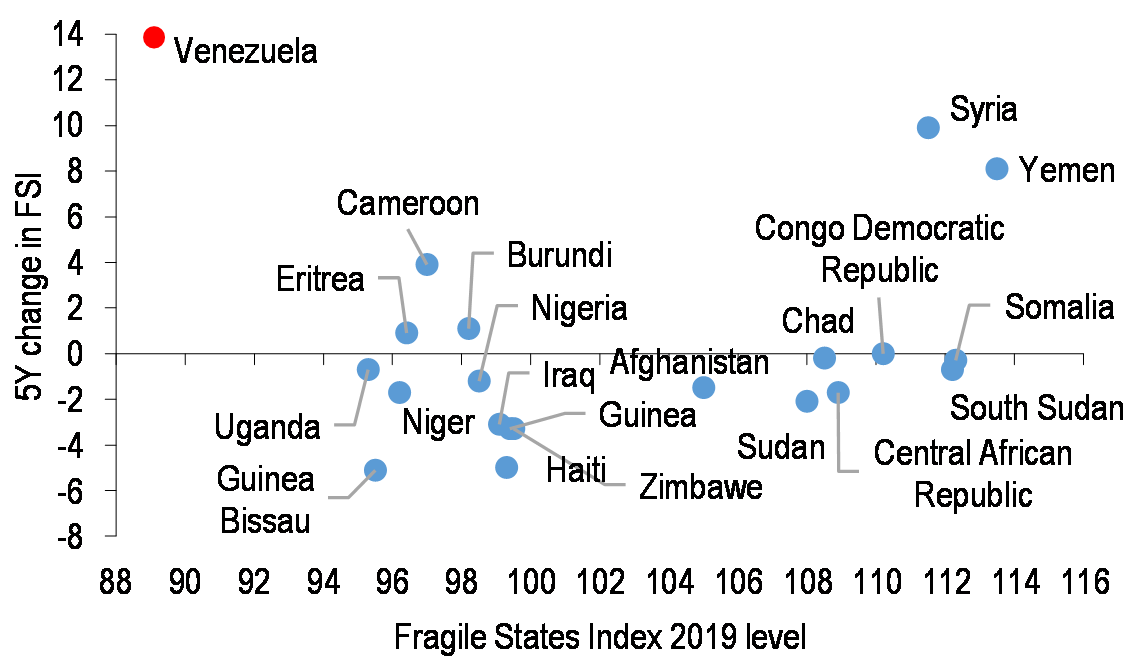
Source: J.P. Morgan, The Fund for Peace (www.fundforpeace.org)
Figure 4: Lack of legal tender status may always constrain cryptocurrency liquidity compared to traditional portfolio hedges
Value of outstandings in traditional portfolio hedges in $ trillions. Measures used are: for bonds, outstanding nominal and inflation-linked bonds for US, Euro area and Japan; for commodities, open interest across commodities futures curve for a commodity index (JPMCCI) and gold, and value of aboveground gold stock; and for cryptocurrencies, market capitalization of Bitcoin, Ripple and Ethereum.

Source: J.P. Morgan
Developments over the past year have not altered our reservations about these assets’ limited role in global portfolios. Cryptocurrency detractors have often cited these instruments’ extreme volatility as a reason to avoid the most-watched market since dot-com stocks of the 1990s (Figure 5). But even if Bitcoin’s realized volatility is now far from the all-time highs seen in the early years of trading, its level remains considerable at about 60%, so five times that of Equities or Commodities. Thus, any consumer, business, or investor who prioritizes stability in their medium of exchange or store of value should probably avoid the majority of the world’s government-issued/fiat currencies (i.e., most emerging market ones plus G10 commodity ones), much less the crypto aspirants.
Figure 5: Cryptocurrency volatility has fallen but remains about five times greater than core markets like Equities or hedges such as Commodities
1Y realized volatility on BTC, S&P500 and JPM Commodity Curve Index
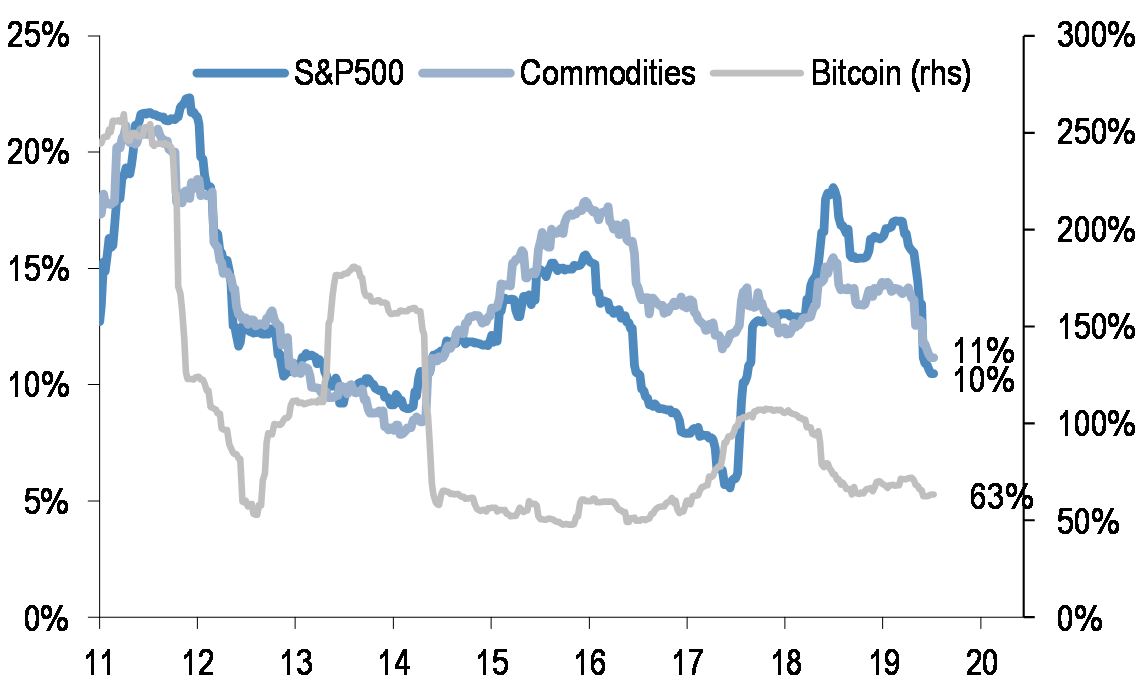
Source: J.P. Morgan, Bloomberg
The correlation appeal of crypto assets remains, despite initial concerns that a gradual mainstreaming of these instruments could synchronize their moves with core markets. (The more widely-owned an asset becomes, the more likely it could be sold with cyclicals like Equities and Credit when a shock hits.) Table 1 refreshes correlations amongst cryptocurrencies (proxied by Bitcoin), major asset classes, and conventional hedges (Treasuries, TIPS, Gold and Yen) and highlights cryptocurrencies’ potential diversification value. Bitcoin’s co-movement with all markets over the past five years has been near zero, which would seem to position it better than the Yen or Gold for hedging purposes. Inspecting annual correlations in 2019 reveal that with some markets like EM Bonds (local currency), Gold and Commodities, Bitcoin’s degree of co-movement has been above average and increasing for two consecutive years, but in absolute value the figures remain modest. Further, annual correlations are typically patchy, making it difficult to claim that a structural break in Bitcoin’s neutral correlation structure has taken place.
Table 1: Cryptocurrencies’ correlation with some asset classes has risen over the past year from their long-term average, but the degree of co-movement remains quite low
Correlation of weekly returns over past five years and past year
| Past five years | |||||||||
| S&P500 | USTs | US HG Credit | EM Local | TIPS | Commodities | Gold | Yen cash | BTC | |
| S&P500 | 1 | -0.29 | -0.07 | 0.30 | -0.03 | 0.39 | -0.14 | -0.33 | 0.04 |
| USTs | 1 | 0.88 | 0.16 | 0.82 | -0.20 | 0.50 | 0.53 | 0.01 | |
| US HG Credit | 1 | 0.30 | 0.82 | -0.03 | 0.45 | 0.43 | 0.03 | ||
| EM Local | 1 | 0.36 | 0.38 | 0.46 | 0.22 | 0.00 | |||
| TIPS | 1 | 0.08 | 0.49 | 0.43 | 0.01 | ||||
| Commodities | 1 | 0.18 | -0.06 | 0.03 | |||||
| Gold | 1 | 0.59 | 0.02 | ||||||
| Yen cash | 1.00 | 0.08 | |||||||
| Bitcoin | 1 | ||||||||
| Past year | |||||||||
| S&P500 | USTs | US HG Credit | EM Local | TIPS | Commodities | Gold | Yen cash | BTC | |
| S&P500 | 1 | -0.46 | -0.29 | 0.31 | -0.29 | 0.51 | -0.09 | -0.50 | -0.03 |
| USTs | 1 | 0.93 | -0.16 | 0.84 | -0.35 | 0.54 | 0.63 | -0.02 | |
| US HG Credit | 1 | -0.05 | 0.84 | -0.20 | 0.59 | 0.56 | -0.04 | ||
| EM Local | 1 | 0.06 | 0.29 | 0.38 | 0.02 | 0.20 | |||
| TIPS | 1 | -0.13 | 0.65 | 0.71 | -0.01 | ||||
| Commodities | 1 | 0.02 | -0.22 | 0.17 | |||||
| Gold | 1 | 0.56 | 0.21 | ||||||
| Yen cash | 1.00 | 0.10 | |||||||
| Bitcoin | 1 | ||||||||
Source: J.P. Morgan, Bloomberg
Cryptocurrencies’ diversification potential also emerges from a standard optimization framework. As Figure 6 illustrates in a model USD-denominated multi-asset portfolio, standard unconstrained Markovitz optimization based on a set of expected returns (10% for US Equities, 3% for US Treasuries, 4% for Gold and +20% for BTC) and five-year historical correlations and volatility levels assigns a positive weight to BTC. In this exercise, capital markets conditions are assumed to be average rather than representative of the current market environment. Hence, expected returns are not based on JPM’s expectations for 2020 but on 20-year average annual returns for traditional asset classes and on the 2014-2019 average (ex-2017, given its outlier nature) for BTC. The results of adding BTC to an Equity and Bond portfolio supports the inclusion of cryptos. The positive implied weights for BTC increase with target portfolio risk and range from 1.2% to 5% for portfolios with volatility in the 4-10% interval. The model’s positive allocation is primarily motivated by cryptos’ correlation with conventional asset classes being close to zero, thereby resulting in a significant diversification advantage.
Including in the portfolio conventional hedges (Gold in this example) leaves the conclusions unaltered. As shown in Figure 7, the framework’s allocation to BTC remains unchanged while implied weights of US Treasuries are lower given elevated correlation levels between Gold and Bonds. For realistic levels of target portfolio risk, the optimal BTC weight remains small relative to what is assigned to Equities, Bonds and Gold given that BTC historical volatility, much higher than those of traditional asset classes, penalizes ex-ante risk-adjusted returns thereby reducing implied weights. Despite the relatively modest weight assigned to cryptocurrencies by the framework, the optimal allocation probably remains impractical for all levels of target volatility given that the size of the crypto market is small and could always be constrained by the lack of a legal tender status
Figure 6: Optimal portfolio’s allocation to crypto is positive and increases with target volatility but this allocation is always impractical given size of market
Optimal allocation to US Equities, US Treasuries and BTC for an unconstrained portfolio for different levels of target volatility. The optimization is a standard Markovitz framework applied to expected return assumptions and 5Y historical volatilities and correlations.
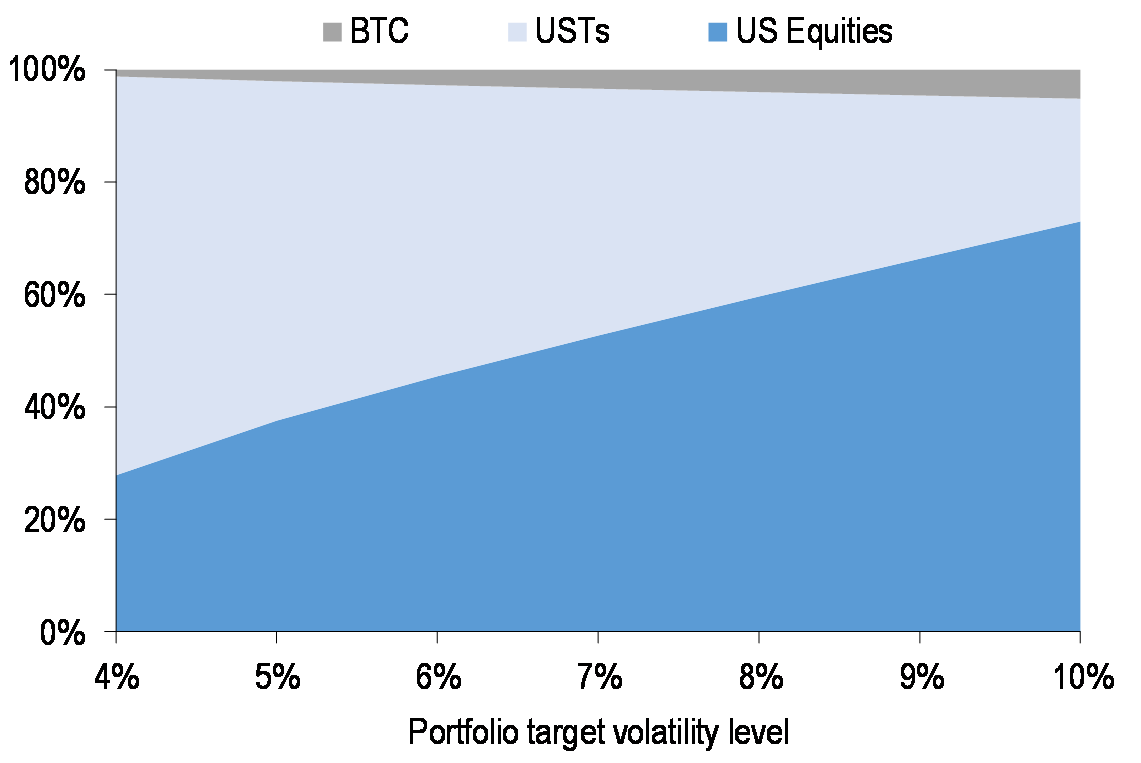
Source: J.P. Morgan
Figure 7: And cryptocurrencies optimal weight in the portfolio is unaffected by the inclusion of safe havens with diversification potential
Optimal allocation to US Equities, US Treasuries, Gold and BTC for an unconstrained portfolio for different levels of target volatility. The optimization is a standard Markovitz framework applied to expected return assumptions and 5Y historical volatilities and correlations.
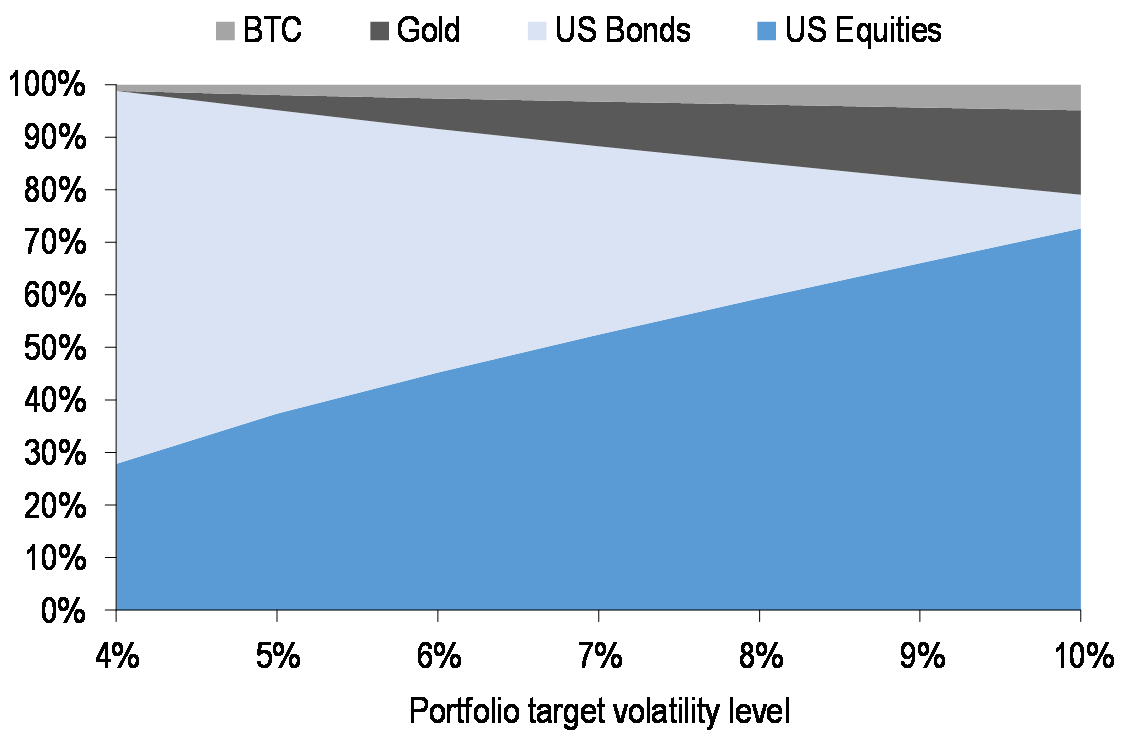
Source: J.P. Morgan
However, low correlations have little value if the hedge asset itself does not offset losses in a bear market or in a prolonged correction. Despite the apparent diversification benefit, cryptos have provided much less protection than Treasuries, Gold or the Yen during extreme market drawdowns over the past several years. The cryptocurrency bust (Figure 1) may be remembered as a 2018 event, but over these assets’ short history they have frequently under-delivered during large core market drawdowns. For example, during the worst drawdowns for a multi-asset portfolio since 2011, Bitcoin losses have been consistently larger than those of stocks (Figure 8). In peak-to-trough terms, the S&P 500 has averaged -10% while Bitcoins averaged -30% during these corrections. On the contrary, traditional haven assets have consistently fulfilled their role in offsetting risky assets’ losses with an average trough-to-peak move of 6.4% for Gold, 2.5% for US Treasuries and 4.7% for JPY versus USD.
Hedges with broader Japanization, plus unseen states of the world
It’s possible that Bonds lose their ability to hedge Equity portfolios over the next several years as central bank rates approach their lower bound and bond yields converge on policy/deposit rates. Hence why we have argued for owning less-constrained defensive assets such as the yen and Gold for long-term investors (see The limits to Japanization as a global investment theme: Nine presumptions worth rethinking by Normand from Jul 2019). Add crypto to this list, but more for the ability to hedge an environment that most countries have never experienced—entailing a loss of confidence in both the domestic currency and the payments system—because it is still not clear that these assets deliver protection that more liquid defensives cannot.
Figure 8: Despite their medium-term diversification benefit, cryptos have provided much less protection than traditional portfolio hedges during equity markets’ most significant drawdowns.
Returns on various defensive assets during the largest peak-to-trough drawdowns for the S&P500. Ten episodes over 2011-2019 sample.
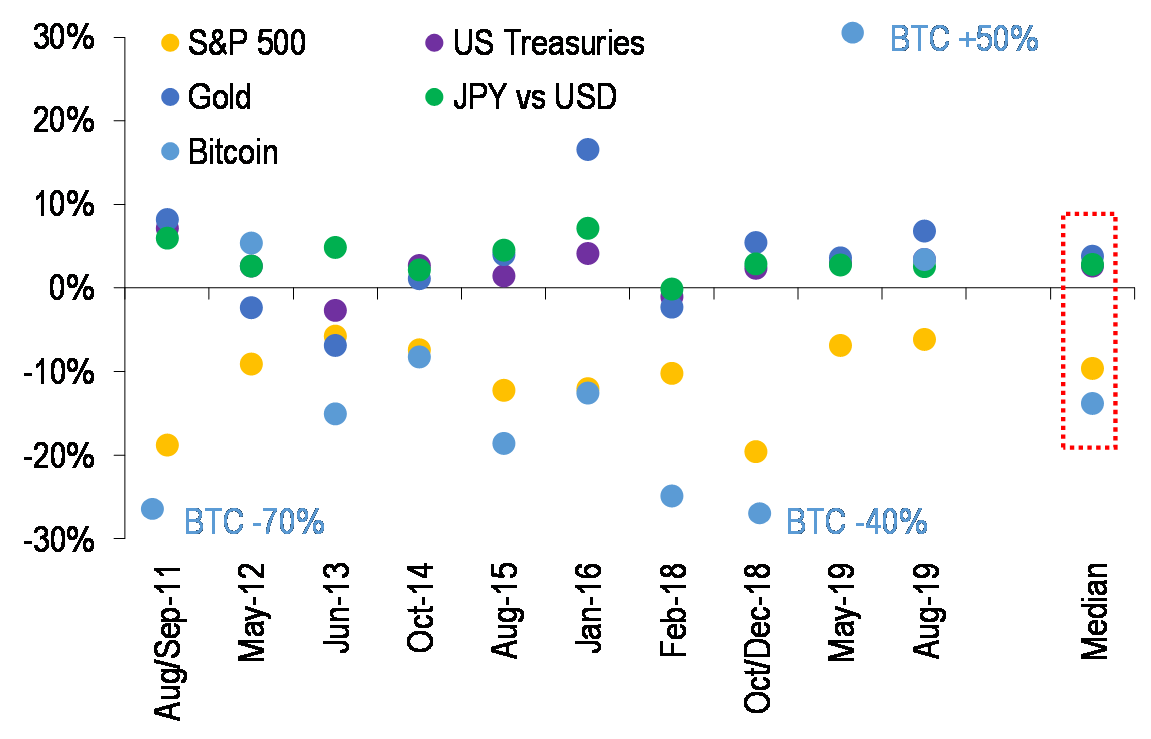
Source: J.P. Morgan
John Normand AC john.normand@jpmorgan.com J.P. Morgan Securities plc | Federico Manicardi federico.manicardi@jpmorgan.com J.P. Morgan Securities plc |
Venezuela’s Petro: All dressed up with nowhere to go
- The Petro was introduced with much fanfare, but it has gained little if any international traction.
- The Maduro regime is increasingly attempting to find domestic use for the “sovereign” coin.
- But in the end, the Petro has so far looked more like another (hyperinflationary) fiat currency.
Domestic use, but not much more
Since the much ballyhooed end-2017 announcement of Venezuela’s Petro—supposedly the first sovereign cryptocurrency, and apparently backed by oil—not much has happened. If anything, the Petro appears to be a digital fiat currency that so far still has limited use even inside Venezuela.
As we wrote last year,48 in the midst of strong financial sanctions from the US, including targeting the state oil company PDVSA and the Venezuelan central bank, it came as little surprise that the Maduro regime would seek detours around the US financial system. In this context cryptocurrency held some obvious appeal. Maduro’s regime in 2018 initially announced several billion dollars’ worth of Petros had been placed in an initial cryptocurrency offering. However, there is no evidence that the regime placed any significant amount of Petros in the initial coin offering (ICO).
Rather than gain traction as an accepted international cryptocurrency, the Petro has thus far served as a reference price for domestic transactions inside Venezuela, and more recently as a vehicle to distribute social spending, pensions and bonus payments to government employees. Indeed there seems to be an effort to reorient more domestic transactions into Petro, and proposals to allow domestic entities to use it to pay taxes, for example, could increase domestic demand. Maduro has also recently required that international companies use Petro to pay fees and costs in Venezuela’s air and seaports. This is problematic for international firms, as the US specifically sanctioned Petro transactions in March 201849.
Same flaws
As we wrote last year1, both the “sovereign” aspect of the Petro and its emblematic feature of being backed by a commodity both turned out to be fundamental flaws. On the former, the Venezuelan authorities set up a ministry of cryptocurrency and a centralized infrastructure controlled by the regime, rather than regulated and policed by openness and transparency, which is the key selling point of crypto. On the second point, the promise of oil backing seems like a mirage. The Petro was never convertible into any claim on Venezuelan oil that could ever be monetized. Rather, initial versions of the government marketing suggested that the Petro was backed by the below-ground reserves of a specific, unexploited oil field that still lacks infrastructure or any operating plan to begin to lift crude.
Although the Petro’s face value was said to fluctuate with oil prices, the government’s revised white paper states that the “basket” that sets the Petro’s FX value is a formula based on oil (50%), as well as other Venezuelan natural resources like iron and diamonds. In reality, the Petro has been pegged at $60 per unit (face value) with no apparent link to underlying commodity prices, and the conversion rate to bolívares has skyrocketed to reflect hyperinflation (with a lag to the bolívar black market).
More relevant is the domestic context, where the government has attempted to use the Petro as an indexation vehicle, with an element of coerced savings, for the beneficiaries of government social transfers. The government had already installed electronic infrastructure for administering various direct transfers and subsidies. The authorities have used this system to transfer funds in Petros rather than bolívares and imposing penalties for those who withdraw too quickly from these “savings accounts.” The scheme does allow some protection from inflation insofar as the government has been steadily increasing the bolívar price of the Petro (devaluation), and the penalties in theory could serve to reduce the velocity of money circulating in Venezuela’s hyperinflationary context.
However, the large transfer in December 2019 of year-end bonuses for state employees and pensioners—equivalent to 25% of M2—led to an effort to rapidly convert the coin into bolivares and/or dollars, leading to an 80% spike in the official FX rate since December. In the end, the Petro so far looks like a new version of the bolívar, with more bells and whistles.
Ben Ramsey AC
benjamin.h.ramsey@jpmorgan.com
J.P. Morgan Securities LLC
Appendix
J.P. Morgan Research
J.P. Morgan Perspectives: What if US yields go to zero?, Joyce Chang et al., 16 January 2020
J.P. Morgan Perspectives: Climate Changes ESG Investing, Part II, Joyce Chang et al., 10 December 2019
J.P. Morgan Perspectives: The rise of the corporates: Is a triple-B cliff on the horizon?, Joyce Chang et al., 1 October 2019
J.P. Morgan Perspectives: China’s index inclusion: A milestone for EM as an asset class, Joyce Chang et al., 12 September 2019
J.P. Morgan Perspectives: The rise of the corporates: Buybacks at an inflection point?, Joyce Chang et al., 17 July 2019
J.P. Morgan Perspectives: ESG Investing 2019: Climate changes everything, Joyce Chang et al., 30 May 2019
J.P. Morgan Perspectives: Leaving LIBOR: The Long Road Ahead, Joyce Chang et al., 30 April 2019
J.P. Morgan Perspectives: Paradigm Shifts: What Lies Ahead, Joyce Chang et al., 5 April 2019
J.P. Morgan Perspectives: Achieving Gender Balance 2019: Progress, Opportunities and Challenges, Kimberly Harano et al., 1 March 2019
J.P. Morgan Perspectives: Made in China 2025: A New World Order?, Joyce Chang et al., 31 January 2019
J. P. Morgan Perspectives: Blockchain and Cryptocurrencies 2019: Adoption, Performance and Challenges, Jan Loeys, 24 January 2019
J.P. Morgan Perspectives: Geopolitics and Markets: Risks on the Rise, Joyce Chang et al., 1 November 2018
J.P. Morgan Perspectives: 20 Years After the Asia Financial Crisis: How Is EM Faring?, Joyce Chang et al., 4 October 2018
J.P. Morgan Perspectives: Ten Years After the Global Financial Crisis: A Changed World, Joyce Chang et al., 10 September 2018
J.P. Morgan Perspectives: ESG Investing Goes Mainstream, Jan Loeys et al., 25 May 2018
J.P. Morgan Perspectives: Decrypting Cryptocurrencies: Technology, Applications and Challenges, Jan Loeys et al., 8 February 2018
Click here for more Strategic Research
Long-term Strategy
The Long-term Strategist: Bonds time diversify much better than you think, Jan Loeys and Shiny Kundu, 14 February 2020
The Long-term Strategist: Financial repression, risk aversion and zero yields, Jan Loeys and Shiny Kundu, 24 January 2020
The Long-term Strategist: Why invest on Climate change?, Jan Loeys and Shiny Kundu, 10 December 2019
The Long-Term Strategist: Do BBs still offer better returns?, Jan Loeys and Shiny Kundu, 3 October 2019
The Long-Term Strategist: Buybacks and the investor, Jan Loeys and Shiny Kundu, 18 July 2019
The Long-Term Strategist: What if US joins the Zero-Yield World, Jan Loeys and Shiny Kundu, 12 July 2019
The Long-Term Strategist: Climate change investing, Jan Loeys and Shiny Kundu, 30 May 2019
The Long-Term Strategist: De-globalization, Jan Loeys et al., 5 April 2019
The Long-Term Strategist: Small Caps: A Strategic Overweight, Jan Loeys, Shiny Kundu and Eduardo Lecubarri, 15 February 2019
The Long-Term Strategist: Will Value Come Back?, Jan Loeys and Shiny Kundu, 16 November 2018
The Long-Term Strategist: Politics and markets, long term, Jan Loeys and Shiny Kundu, 6 November 2018
The Long-Term Strategist: Strategic questions on EM allocations, Jan Loeys et al., 28 September 2018
The Long-Term Strategist: The Value of Income, Jan Loeys and Shiny Kundu, 15 June 2018
The Long-Term Strategist: Health Care: A Strategic Sector OW, Jan Loeys, Shiny Kundu, Chris Scott and Jesse Edgerton, 11 May 2018
The Long-Term Strategist: What returns can we expect?, Jan Loeys, Shiny Kundu and Lixin Bao, 13 April 2018
The Long-Term Strategist: First thoughts, Jan Loeys, 26 February 2018
The JPMorgan View: What have I learned?, Jan Loeys, 10 November 2017
Click here for more Long-term Strategy Research
Additional resources from JPMC BCOE
JPMC TechTrends Podcast: What’s Next for Blockchain? Christine Moy, Head of Blockchain Center of Excellence, 3 September 2019
JPMC TechTrends Podcast: Decoding Blockchain: Opportunities for Businesses, Christine Moy, Head of Blockchain Center of Excellence, 25 June 2018
What’s Next for Blockchain?https://www.jpmorgan.com/country/US/EN/insights
Cross-Asset Strategy
Cryptocurrencies as portfolio diversification: Still failing in high-stress environments, John Normand, 25 January 2019
Global Markets Strategy
Flows & Liquidity: How possible is a repeat of Q4 2018?, Nikolaos Panigirtzoglou et al., 27 September 2019
US Fixed Income Strategy
The road ahead for digital currency and fast payments, Joshua Younger, 9 January 2020
A case study in alternative payments: Lessons from the Chinese experience, Joshua Younger et al., 5 December 2019
Can stablecoins achieve global scale?: Regulatory, technological, and practical hurdles to growth, Joshua Younger et al., 3 December 2019
The market implications of Libra and other stablecoins: A primer and stability analysis, Joshua Younger et al., 5 September 2019
The financial stability benefits of very abundant reserves, Joshua Younger et al., 2 February 2019
Global Quantitative and Derivatives Strategy
Alternative Data, Machine Learning & Artificial Intelligence: Summary of Research & Industry Developments 2019H2, Berowne Hlavaty et al., 18 February 2020
Big Data and AI Strategies: 2019 Alternative Data Handbook, Marko Kolanovic and Robert Smith, 25 October 2019
Asia Pacific Equity Research
OneConnect Financial Technology: Early mover to deliver strong growth in a sizable market; initiate at OW, Alex Yao et al., 22 January 2020
Tyro Payments Limited: Initiate at OW – Best-in-class payments challenger, Bob Chen and Russell Gill, 14 Jan. 2020
China Fintech: 101 on banks’ IT strategies and surveying the revenue potential for co-lending business for TSPs, Katherine Lei et al., 3 December 2019
TSMC: Renewed EPS growth beckons; raise PT to NT$320, Gokul Hariharan et al., 26 September 2019
Japan Equity Research
Cross Sector: Report on Japan FinTech Forum 2019: Cashless, and Beyond Cashless, Rie Nishihara, 7 October 2019
Cashless, and Beyond Cashless, Rie Nishihara, Haruka Mori et al., 26 September 2019
Japanese Banks: BoJ’s Payment and Settlement Systems Report: Financial Institutions versus FinTech Companies in Small Payments Arena, Rie Nishihara, 29 March 2019
Europe Equity Research
European Software & IT Services: 2020 Outlook - Digital transformation remains supportive of sustained earnings growth, Stacy Pollard et al., 12 January 2020
North America Equity Research
Signature Bank: 4Q19: With New Teams Gaining Traction, Growth Momentum Likely to Build Through 2020; OW, Steven Alexopoulos et al., 22 January 2020
Signature Bank: Mtgs: New Verticals Driving Above Peer Growth While Reducing Risk; Transformation Deep Dive, Steven Alexopoulos et al., 6 September 2019
Transportation and Logistics: Freight Tech Highlights from Freight Waves in Chicago, Brian P. Ossenbeck, CFA, 15 November 2019
Facebook: FB Unveils Blockchain-Based Libra Currency to Empower Billions Globally; Potential L-T Driver of Engagement & Commerce, Doug Anmuth, 18 June 2019
U.S. Mid- and Small-Cap Banks 1Q19 Earnings Preview: Downgrading CMA, ZION, KEY, Upgrading SBNY as We Reduce Asset Sensitivity; Digital Banks Deep Dive, Steven Alexopoulos et al., 4 April 2019
Latin America Equity Research
Carrefour Brasil: Strengthening Banking and Digital Capabilities -- Acquisition of Ewally, Joseph Giordano et al., 2 October 2019
LatAm Real Estate - Today's News: Cyrela & Blockchain, CashMe update, ABRAINC interview, ICVA decelerating, GDP revised down to 0.7%, Marcelo Motta et al., 17 June 2019
Global Credit Research
Payments paydowns: Resuming coverage of FISV and initiating on FIS as de-levering begins, Christian Crosby and Brian Turner, 13 January 2020
Videos and Podcasts
The road ahead for digital currency, Joshua Younger, 10 January 2020
Podcast: The road ahead for digital currency, Joshua Younger, 16 January 2020
Video: J.P. Morgan Perspectives: Cryptos and Blockchain, one year later, Jan Loeys, John Normand and Sterling Auty, 11 February 2019
External reference materials
Axoni Distributed Ledger Network For Equity Swap Processing Goes Live With Leading Market Participants, 6 February 2020
Bitcoin price and its marginal cost of production: supporting evidence, Adam Hayes, Applied Economics Letters, June 2018
(https://www.researchgate.net/publication/317601872)
Can Blockchain Technology Facilitate International Trade?, C. McDaniel, George Mason University, 24 April 2019
Chainalysis Research: Speculation Remains Bitcoin’s Primary Use Case, Cointelegraph, Marie Huillet, 31 May 2019
(https://cointelegraph.com/news/chainalysis-research-speculation-remains-bitcoins-primary-use-case)
Digital Currencies: The Rise of Stablecoins, Tobias Adrian and Tommaso Mancini-Griffoli, IMFBlog, 19 September 2019
(https://blogs.imf.org/2019/09/19/digital-currencies-the-rise-of-stablecoins)
Economic and Non-Economic Trading In Bitcoin, M. Hougan, H. Kim, and M. Lerner, Bitwise Asset Management, 24 May 2019
(https://www.sec.gov/comments/sr-nysearca-2019-01/srnysearca201901-5574233-185408.pdf)
Global Financial Inclusion (Global Findex) Database, The World Bank Data Catalog
(https://datacatalog.worldbank.org/dataset/global-financial-inclusion-global-findex-database)
JPMorgan News and Announcements: J.P.Morgan Creates Digital Coin for Payments(https://www.jpmorgan.com/global/news/digital-coin-payments)
JPMorgan in talks to merge blockchain unit Quorum with startup ConsenSys – sources, Anna Irrera, Reuters, 11 February 2020
(https://www.reuters.com/article/us-jp-morgan-blockchain-exclusive/exclusive-jpmorgan-in-talks-to-merge-blockchain-unit-quorum-with-startup-consensys-sources-idUSKBN2051AW)
JPMorgan, National Bank of Canada, others test debt issuance on blockchain, Anna Irrera, Reuters, 20 April 2018
Market Surveillance Report, April 2019, Blockchain Transparency Institute (https://www.bti.live/reports-april2019/)
Signature Bank Press Release: Signature Bank and Prime Trust to Align Their Respective Technologies to Better Serve the Institutional Blockchain Industry(https://investor.signatureny.com/file/Index?KeyFile=402036911)
Signature Bank Press Release: Signature Bank Unveils Proprietary Digital Payments Platform, Signet™(https://investor.signatureny.com/file/Index?KeyFile=395984336)
The 2019 Federal Reserve Payments Study: Initial Data Release, Federal Reserve Payments Study (FRPS)(https://www.federalreserve.gov/paymentsystems/fr-payments-study.htm)
The Rise of Digital Money, FinTech Notes No. 19/001, Tobias Adrian and Tommaso Mancini Griffoli, International Monetary Fund, 15 July 2019
(https://www.imf.org/en/Publications/fintech-notes/Issues/2019/07/12/The-Rise-of-Digital-Money-47097)
Wells Fargo to Pilot Internal Settlement Service Using Distributed Ledger Technology, Innovation and Technology 17 September 2019
White House Bans Venezuela’s Digital Currency and Expands Sanctions, J. Davis and N. Popper, NY Times, 19 March 2018
(https://www.nytimes.com/2018/03/19/world/americas/trump-venezuela-sanctions-petro.html)
Websites
J.P. Morgan Blockchain Center of Excellence (BCOE): https://www.jpmorgan.com/global/technology/blockchain
Quorum: https://www.goquorum.com/
JPMorgan Creates Digital Coin for Payments: https://www.jpmorgan.com/global/news/digital-coin-payments
Firm Tests Blockchain Debt Issuance: https://www.jpmorgan.com/country/US/en/detail/1320566740924
Interbank Information Network® (IIN):https://www.jpmorgan.com/global/treasury-services/IIN
BIS Red Book statisticshttps://www.bis.org/statistics/payment_stats.htm
Turvohttps://turvo.com/
- 3 See J.P. Morgan Creates Digital Coin for Payments.J.P. Morgan will complete all internal procedures and satisfy all regulatory and compliance obligations, prior to any live products or services being launched utilizing JPM Coin.
- 4 Seehttps://www.reuters.com/article/us-china-crypto-breakingviews/breakingviews-chinas-e-yuan-will-be-more-cryptic-than-crypto-idUSKBN1YR0DC
- 5 See https://blogs.imf.org/2019/09/19/digital-currencies-the-rise-of-stablecoins/
- 6 4See https://www.imf.org/en/Publications/fintech-notes/Issues/2019/07/12/The-Rise-of-Digital-Money-47097, p 8.
- 7 5See https://www.imf.org/en/Publications/fintech-notes/Issues/2019/07/12/The-Rise-of-Digital-Money-47097, p. 6.
- 8 See J.P. Morgan Creates Digital Coin for Payments.J.P. Morgan will complete all internal procedures and satisfy all regulatory and compliance obligations, prior to any live products or services being launched utilizing JPM Coin.
- 9 See Wells Fargo to Pilot Internal Settlement Service Using Distributed Ledger Technology.
- 10 See Signature Bank Press Release: Signature Bank Unveils Proprietary Digital Payments Platform, Signet™.
- 11 SeeSignature Bank Press Release: Signature Bank and Prime Trust to Align Their Respective Technologies to Better Serve the Institutional Blockchain Industry.
- 12 Refer to footnote #1.
- 13 https://www.swift.com/our-solutions/compliance-and-shared-services/financial-crime-compliance/kyc-solutions/the-kyc-registry
- 14 https://axoni.com/press/axoni-distributed-ledger-network-for-equity-swap-processing-goes-live-with-leading-market-participants/
- 15 https://komgo.io/shareholders
- 16 https://www.vakt.com/saudi-aramco-energy-ventures-makes-5m-investment-into-vakt-and-joins-platform/
- 17 https://www.mas.gov.sg/news/media-releases/2019/mas-helps-develop-blockchain-based-prototype-for-multi-currency-payments
- 18 Can Blockchain Technology Facilitate International Trade?, C. McDaniel, George Mason University, 24 April 2019
- 19 https://www.bis.org/statistics/payment_stats/commentary1911.htm
- 20 The BIS definition of cashless retail payments includes credit transfers, direct debits, checks, debit card, credit card, e-money payments, and other payment instruments.
- 21 Global Payments Report 2019: Amid sustained growth, accelerating challenges demand bold actions, McKinsey & Company, September 2019
- 22 SeeThe World Bank Data Catalog: Global Financial Inclusion (Global Findex) Database
- 23 3What is a client reserve fund? A CRF represents funds received on behalf of clients (payer) from processing payments, and payable to payees. Previously, CRFs were deposited at qualified commercial banks and generated interest income to payment companies. Since 2019, they are all held in a non-interest bearing centralized depository account assigned by PBOC.
- 24 A recent report by Chainanalysis Research found only 1.3% of Bitcoin transactions involved merchants in the first quarter of 2019.
- 25 Though in theory exchangeable for the underlying collateral, it is important to note that the mechanism by and circumstances under which the holders of asset-backed stablecoins could actually receive this collateral is highly uncertain and generally unregulated. The management of those assets is also unregulated with very limited transparency. In the case of a basket, the holder could also receive a cheapest-to-deliver subset of the collateral, and in that sense is short a delivery option to the reserve manager.
- 26 One key difference between JPM Coin as currently contemplated and most stablecoins is the private and closed nature of its network. By some definitions, this does not qualify as a stablecoin or other cryptocurrency. Rather, JPM Coin and other similarly designed tokens are better described as a more efficient protocol for book transfer payments on a closed network, the unit of which has been termed a “coin” but which bears only a passing resemblance to most cryptocurrencies.
- 27 However, the concept of sponsored transferability as an anchor, as opposed to explicit asset-backing, is one that in principle could be applied to future stablecoins on public networks. J.P. Morgan will complete all internal procedures and satisfy all regulatory and compliance obligations, prior to any live products or services being launched utilizing JPM Coin .
- 28 4 See for example Big tech in finance: opportunities and risks, BIS 2019 Annual Economic Report, 23 June 2019 and Update from the Chair of the G7 working group on stablecoins, 18 July 2019
- 29 For details on global payments systems in major and larger economies, see the most recent Red Book from the BIS Committee on Payments and Market Infrastructure.
- 30 Congestion and Cascades in Payment Systems, W. Beyeler, R. Glass, M. Bech, and K. Soramäki, Federal Reserve Bank of New York, Sept. 2006
- 31 Liquidity Effects of the Events of September 11, 2001, J. McAndrews and S. Potter, Federal Reserve Bank of New York, Nov. 2002
- 32 The Payment System Benefits of High Reserve Balances, J. McAndrews and A. Kroeger, Federal Reserve Bank of New York, June 2016
- 33 What Can We Learn from the Timing of Interbank Payments? A. Copeland, L. Molloy, and A. Tarascin, Liberty Street Economics, Federal Reserve Bank of New York, Feb. 2019
- 34 Bank account in this context refers to the definition from the World Bank Findex glossary, which includes deposits at banks and other financial institutions, as well as self-reported personal use of mobile money services.
- 35 Shadow Economies Around the World: What Did We Learn Over the Last 20 Years?, IMF Working Paper, L. Medina and F. Schneider, 24 January 2018
- 36 Statistics on payment, clearing and settlement systems in the CPMI countries - Figures for 2016, BIS, 15 December 2017
- 37 Data Point: Frequent Overdrafters, Consumer Financial Protection Bureau, August 2017
- 38 We have omitted short-term CGBs and other CNY-denominated securities from this analysis. This was done under the assumption that capital controls and lack of free float make them very unattractive reserve assets. Consistent with this COFER data published by the IMF suggests that global FX reserves include a small (~1%) exposure to CNY.
- 39 https://www.treasury.gov/resource-center/data-chart-center/tic/Pages/index.aspx
- 40 See e.g., The Liquidity Coverage Ratio and liquidity monitoring tools, Basel Committee on Bank Supervision, BIS, January 2013
- 41 Investigating the impact of global stablecoins, G7 Working Group on Stablecoins, October 2019
- 42 2019 Findings from the Diary of Consumer Payment Choice, Raynil Kumar and Shaun O’Brien, Federal Reserve Bank of San Francisco, June 2019
- 43 The role of central bank money in payment systems, Bank for International Settlements, Committee on Payment and Settlement Systems, August 2003
- 44 Financial services firms annually spend an average of $14.3 million on AML compliance, LexisNexis® Risk Solutions, 2019
- 45 Economic and Non-Economic Trading In Bitcoin, M. Hougan, H. Kim, and M. Lerner, Bitwise Asset Management, 24 May 2019
- 46 Market Surveillance Report, April 2019, Blockchain Transparency Institute
- 47 Bitcoin price and its marginal cost of production: supporting evidence, Adam Hayes, Research Gate
- 48 See “Venezuela’s Petro: A dry well” inJ. P. Morgan Perspectives: Blockchain and Cryptocurrencies 2019: Adoption, Performance and Challenges, Jan Loeys, 24 Jan. 2019
- 49 White House Bans Venezuela’s Digital Currency and Expands Sanctions, J. Davis and N. Popper, NY Times, 19 March 2018